First takes on the news of the minute from the L.A. Times Opinion section. Follow us on Twitter @latimesopinion and Facebook.
- Share via
Sore loser GOP lawmakers are ruining democracy for everyone else
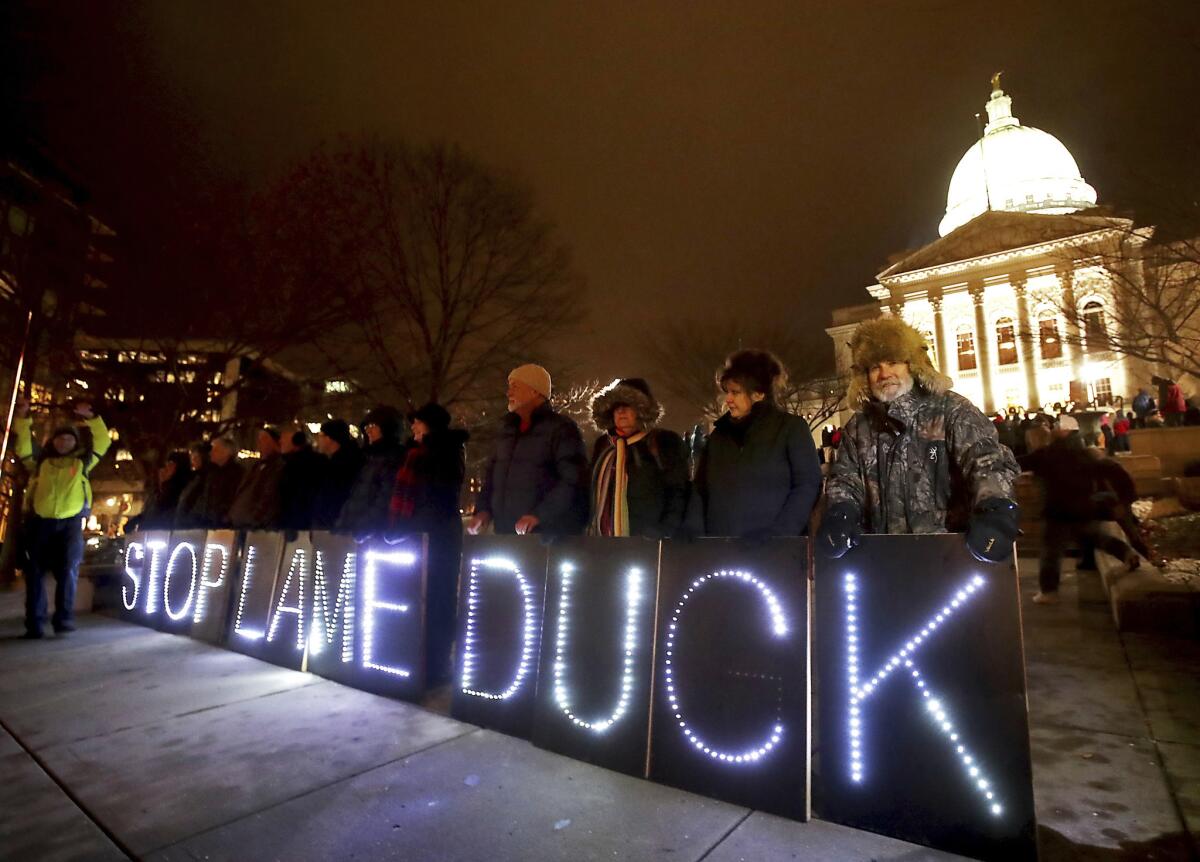
Talk about lame lame ducks.
Republicans lost control of gubernatorial and other statewide seats in Michigan and Wisconsin. But instead of graciously accepting the will of voters and handing over the keys to the new guys and gals, they decided to use their remaining days to plunder the prizes won by the rival party. Boo on them.
In Wisconsin, where Republican Gov. Scott Walker lost the top leadership job to Democrat Tony Evers on Nov. 6, the Republican-controlled Legislature is voting on last-minute legislation in a special session that would, among many, many other things, strip Evers of all sorts of authority his predecessor enjoyed.
Wisconsin legislators are also seeking limits on the power of the incoming Democratic attorney general, including by giving themselves the right to hire an outside attorney in certain cases such as those regarding redistricting. (The state’s gerrymandered districts that favor Republicans have been under legal attack). Walker, who is governor for a few more weeks, said he’s inclined to support the legislation.
The Michigan Legislature is on a similar track, rushing through laws to limit the power of the state’s incoming Democratic governor, attorney general and secretary of state. According to the Detroit News, it’s the first time Democrats have held all these seats since 1990.
(That’s not all the last-minute self-serving legislation apparently being rammed through the Michigan Legislature this month.)
If this seems like a familiar a story line it could be because North Carolina’s Republicans took similar action in 2016 before they had to hand the governor seat over to Democrat Roy Cooper.
As my colleague Michael McGough pointed out at the time, one of the last-minute changes — state Senate approval of cabinet members — is actually sensible. But even good ideas smell like sour grapes when they come as part of a figurative middle finger to an incoming, elected leader.
These are power grabs, pure and simple. And though this sore loser legislation is apparently legal, citizens of those states should make note of the legislators who vote for it — and hold them accountable.
A bit of this sore loser-ness has been focused on California as well. Republicans lost spectacularly in the Golden State on Nov. 6, seeing their already small contingent of congressional and state legislative seats diminished to historic lows. That’s got to hurt, but it doesn’t excuse Republican leaders such as outgoing House Speaker Paul Ryan for trying to sully the reputation of California’s voting system by suggesting there was something amiss in the counting. What happened is no mystery; the state made it easier to register and to cast ballots, which benefited traditionally disenfranchised voters who tend to be more left leaning.
Look, losing sucks for everyone. But when the losing team pushes over the prize table on the way off the field, they ought not be invited back for the next season.
- Share via
From Black Friday to Waste Wednesday

First there was Black Friday, the post-Thanksgiving shopping extravaganza that has become synonymous with huge deals, long lines and the occasional brawl.
Then there was Cyber Monday, because online retailers wanted in on the buying bonanza.
Then came Giving Tuesday, because nonprofits need money too. (It’s today, if you have somehow managed to avoid having your email inbox filled with appeals.)
Before marketers get their hands on Wednesday and cook up another campaign designed to part people from their cash, I’d like to claim it to highlight a byproduct of all this spending: trash.
Let us call this day Waste Wednesday. No one has to spend money to celebrate. Simply gather together all packaging material that came with stuff bought over the past few days, pile it up and contemplate its immensity and its future.
Each new television, blender or toy (and even the swag from your donation to public radio) comes swaddled in a considerable amount of disposable material — boxes, bags and every type of plastic you can imagine.
Most of this material is promptly discarded and sent on its way to landfills, though perhaps a bit might be diverted into recycling bins and come back to life as part of something put on sale next Black Friday. But some of it will probably end up in the environment, as trash has a nasty way of doing, released on purpose or by accident into gutters, storm drains, by the sides of the freeway and, increasingly, into the world’s oceans.
After gathering all of the single-use packaging material you received, you should commemorate the moment by posting a photo of the pile on social media with the hashtag #WasteWednesday. That’s it.
If this catches on, it might give retailers incentive to cut down on all the disposable packaging that gets bundled with their products in time for next year.
- Share via
If Trump wants to keep auto plants open, he should accelerate, not brake, the transition to electric vehicles
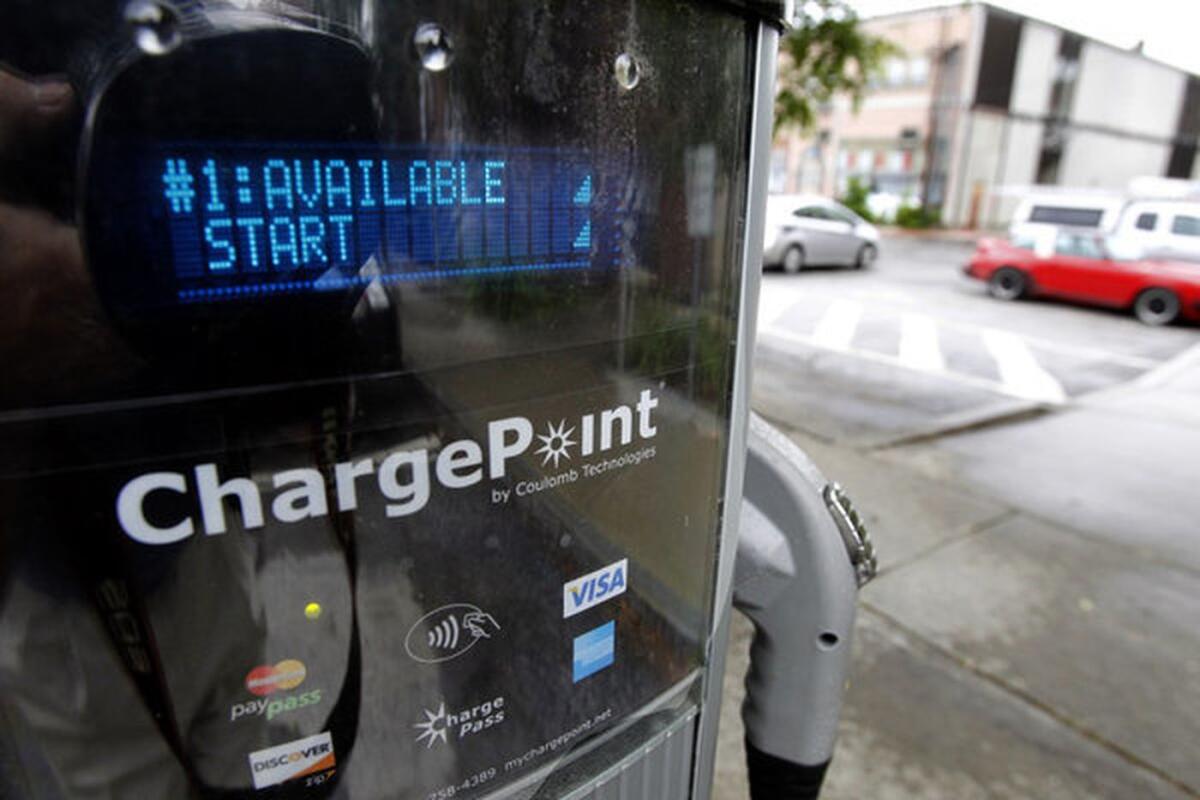
General Motors’ announcement that it is shutting down auto plants and laying off blue- and white-collar workers put President Trump in a predictable froth, which my colleague Jon Healey wrote about.
But if the president was really interested in helping GM, he’d be looking at supportive policies, not punitive (and likely illegal) threats to withhold subsidies. In fact, the president should be increasing subsidies for some of the lines GM plans to end: the Chevrolet Cruze and Volt lines.
GM’s announcement overlapped with a sprinkling of dire reports (which I wrote about) that the U.S. and the world are botching our chance to more directly confront greenhouse gas emissions.
One crucial step would be to reduce the number of gas-powered vehicles. But electric cars and hybrids are more expensive than their gas-powered counterparts, in part due to a lack of economies of scale. So instead of threatening to withhold EV subsidies to GM, Trump ought to look at increasing them across the industry, and finding other ways to make EVs more affordable for consumers (and no, EVs aren’t the complete fix, but they would help).
As the government’s own study on Friday pointed out, the U.S. faces a severe hit to its economy from climate change. So his drill-and-burn policies will just end up costing the nation more down the road, not to mention helping make the world less habitable for humans.
If the president would pull his head out of the oil well, he would see there is huge economic opportunity to be had by leading the global turn to renewable energy, and the U.S. could seize the pole position if the government did more to help build the market for electric vehicles.
More than a century ago, these newfangled toys for the middle class — automobiles — became integral to American society when the government invested in paved roads for the cars to travel on, and Henry Ford found a way to make those cars affordable to more people.
The government could do more now to build up the infrastructure for EVs, including charging stations, more and better consumer rebates for converting (and scrapping, not reselling, their used gas guzzlers), and other steps to send both a market signal and market support for products that serve a broader purpose than just getting us to work or the grocery store.
- Share via
Trump to GM: Drop dead
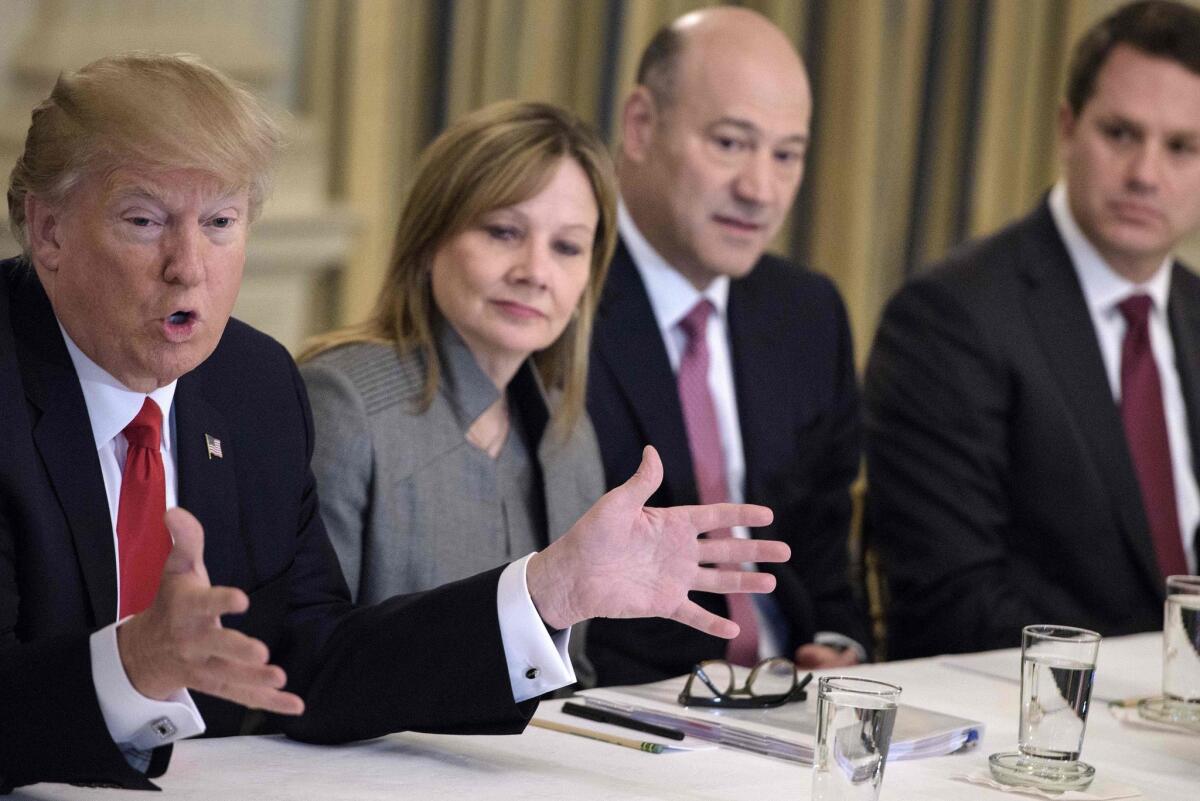
For someone who has pushed hard to free U.S. companies from federal interference, President Trump is unusually willing to tell U.S. companies how to run their businesses.
The latest example is General Motors, which announced plans Monday to cut thousands of jobs and potentially shutter a handful of factories in the face of softening car sales. Traditional Republicans might consider this sort of development a painful but necessary part of the business cycle. To Trump, though, it was a needless blow to an important constituency — autoworkers — in Ohio and Michigan, two blue-collar-heavy Midwestern states that were important parts of his winning coalition in 2016. (The company’s updated plans also envision plant shutdowns in Maryland and Canada, plus two unspecified plants outside of North America.)
So Trump hectored and threatened GM’s leadership, both directly and through the media. He raised the stakes Tuesday on Twitter:
You can insert your own thoughts here about the constitutionality of suddenly (and unilaterally) withholding subsidies from one company while providing them to its competitors. Also, note that the subsidy Trump specified is tied to one of the products GM CEO Mary Barra says is crucial to the company’s future.
Republicans may not object to Trump bullying world leaders in pursuit of this country’s priorities. But bullying the leader of a company in a globalized industry for having a global strategy? That should drive conservatives nuts.
Trump’s America First perspective seems to be making it hard for him to see the reality of GM’s situation. Like many multinational corporations, automakers have factories around the world not just to cut labor costs, but to put production closer to the demand its serving. And though sales dipped slightly in the U.S. last year, they continued growing robustly overseas, especially in China and other developing countries.
So while it might make sense to trim production in the United States, particularly of small cars that are making up a shrinking share of the local market, it makes no sense to roll back production in China — or in Mexico, a prime exporting location thanks to its many tariff-cutting trade agreements.
Whether GM’s bet in China pays off depends on a number of factors, including whether China allows GM to succeed. But Trump may be giving the company’s Chinese investments an unintended hand by piling hefty tariffs on Chinese goods imported into the U.S., which in turn have prompted China to slap tariffs on a growing number of U.S. exports. With those extra costs in place, it’s cheaper for a U.S. company to serve the Chinese market by producing goods there with non-U.S. parts than it would be to serve it with goods exported from a plant in, say, Ohio.
In fairness, Trump’s tariff policy aims to change truly bad behavior that the Chinese government has encouraged or even adopted as policy. The administration has the right goal, which is to stop the theft of intellectual property and eliminate the subsidies and trade barriers that violate international agreements. It’s just that the tactics it’s using — unilaterally imposing tariffs that raise prices for U.S. consumers and invite retaliatory tariffs that hurt U.S. exports — could cause a lot of unnecessary collateral damage.
That damage could increase if the president raises tariffs on $200 billion worth of Chinese goods on Jan. 1, as threatened, and slaps new tariffs on an additional $267 billion worth of Chinese imports. Tariffs are consumption taxes, and the larger and more unavoidable they become, the greater the downward pressure they place on the U.S. economy.
Just a reminder: U.S. automobile sales, like the overall U.S. economy, are cyclical. Industry analysts started predicting more than a year ago that sales were leveling off and would start to slide, and that’s what Barra is reacting to. In fact, the downturn in both automobile and home sales has some economists worried about a recession.
No one welcomes big layoffs — GM’s planned cuts would sacrifice about 8% of the company’s jobs. But Barra recognizes that consumers, not presidents, ultimately decide what happens to auto sales and each company’s market share. And company leaders, not presidents, have to decide how to compete and thrive over the long run.
- Share via
We can’t say we weren’t warned about climate change: Three grim new reports show we’re not doing enough

In the future, when the seas have risen along with global temperatures, and droughts, floods and heat waves have collapsed ecosystems and made sections of the Earth uninhabitable for humans, we won’t be able to say we didn’t see it coming.
Even the Trump administration, in a report released (fittingly enough) on Black Friday, now admits that climate change is here. In fact, another report released the same day says nearly one-quarter of U.S. carbon missions can be traced to oil and gas leases on federal land, so the culpability goes beyond inaction and bad policies to, at least minimally, earning revenues from extracting fossil fuels. Phasing out those leases would go a long way toward meeting national emissions goals.
But wait, there’s more: According to the annual United Nations Environment Program’s Emissions Gap Report released Tuesday in Paris, governments that agreed in 2015 to aggressively reduce their carbon emissions so far have achieved little.
In fact, the report says, promises made only three short years ago to hold temperature rise to less than 2 degrees Celsius above pre-Industrial Age levels, with a goal of limiting the rise to 1.5 degrees Celsius, “are inadequate to bridge the emissions gap in 2030. The U.N. said it was still technically possible to meet the temperature target, but if national “ambitions are not increased before 2030, exceeding the 1.5 degree Celsius goal can no longer be avoided.”
The U.N. report also said that, after three years of relative stability, carbon emissions went up last year despite mitigation efforts and that “global greenhouse gas emissions show no signs of peaking.”
Lovely.
California has famously led the way among what are called sub-national actors, and although such efforts are good, the report notes that they fall far short of the emissions reductions needed globally. It will take fuller national involvement.
Which brings us inevitably to President Trump, who has said, among other things, that he doesn’t believe human activity is affecting climate change. So it shouldn’t surprise anyone that Trump’s response to his own administration’s reports of dire consequences was to state simply, “I don’t believe it.”
Because if he did believe it, then he’d have to acknowledge that his policies to extract and burn ever more fossil fuel endangers the nation’s welfare. And to paraphrase scientist Neil deGrasse Tyson, the climate doesn’t care whether Trump believes it’s changing. It’s changing anyway. The challenge is whether the American people — and, for that matter, the global population — believe it and are willing to combat it with everything from changing consumer choices to changing recalcitrant governments.
There are a lot of phrases in the English language for what we’re doing. “Fiddling while Rome burns” comes to mind, a la Nero. There’s also “standing idly by” and “whistling past the graveyard.”
But no matter how you phrase it, we’re doing it to ourselves.
- Share via
Welcome to Black Friday. Where did that name come from, anyway?
For us non-material types (except for books. And music. And cooking utensils — you get the idea) Black Friday is the bleakest day of the year.
On Thanksgiving Thursday, we celebrate comity and family and take stock of our blessings.
On Black Friday, shoppers throng stores at ungodly hours, elbowing their way forward and swiping goods out from beneath each others’ noses just to save a few bucks on things that neither they nor the intended holiday gift recipient really need.
It’s like lemmings with wallets.
So where did this shopping orgy come from?
Blame Philadelphia. And football. And the Army and the Navy — well, at least their academies.
And, of course, marketers.
Researcher and amateur word sleuth Bonnie Taylor-Blake gets the credit for tracking this down a few years ago. As the New Yorker noted, the common explanations — it was the day retailers counted on for making their year profitable — never made sense to her, so she began digging.
It turns out that in the 1950s, thousands of people would descend on downtown Philadelphia for the annual Army-Navy football game on the Saturday after Thanksgiving. On the day before the game, out-of-towners would add to the throngs of locals who went downtown to shop. The crowds became so huge that all police vacations were canceled to make as many officers available as possible for crowd and traffic control.
The ticked-off cops began calling it Black Friday, and the name stuck.
Shop owners at first were displeased — Black Friday sounds closer to the Black Plague or a stock market rout (the original 1869 coinage referred to the collapse of the gold market after robber barons Jay Gould and James “Diamond Jim” Fisk tried to corner it) than it does to “come spend all your money.” So a movement developed to rebrand it as Big Friday.
Yeah, that didn’t last long.
So Black Friday it is. And in three days we’ll have Cyber Monday, another marketing ploy to separate consumers from their cash.
Who knew lemmings could use a mouse?
- Share via
John Roberts’ brushback pitch at Trump comes with a big old asterisk
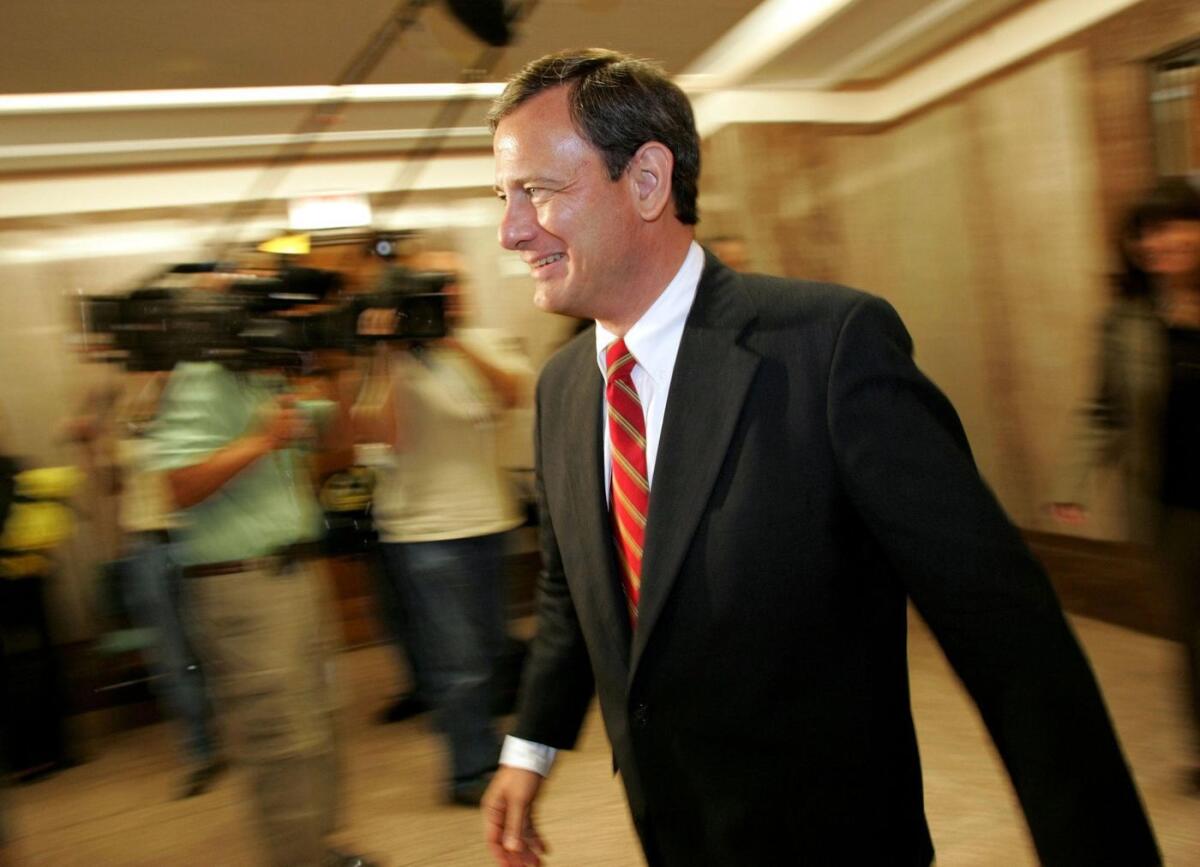
Chief Justice John G. Roberts Jr. deserves credit for pushing back — judiciously — against President Trump’s latest attack on the federal judiciary.
Trump had complained that “an Obama judge” in Northern California had ruled against the president’s attempt to restrict asylum applications. He ominously added: “I’ll tell you what, it’s not going to happen like this anymore.”
In a statement released by the Supreme Court, Roberts said: “We do not have Obama judges or Trump judges, Bush judges or Clinton judges. What we have is an extraordinary group of dedicated judges doing their level best to do equal right to those appearing before them.”
It was a point worth making, even though it wasn’t likely to have any influence on Trump. In fact, the president struck back right away on Twitter:
So, good for the chief justice, but his intervention inspires a few thoughts:
* I wonder how many people who will applaud Roberts for this statement think that the Republican Senate in 2016 “stole” a seat from Barack Obama by refusing to consider his nomination of Judge Merrick Garland to replace the late Antonin Scalia. Isn’t that just another way of saying that liberals were denied an “Obama judge”?
* Maybe Roberts should also aim his criticism at journalists, who routinely identify federal judges in terms of the president who appointed them, even when it’s not relevant. I wrote about that reflex here.
* Roberts knows that his assertion that judges aren’t partisan requires a large asterisk. In some politically charged cases, judges appointed by Democratic presidents can be expected to rule differently from judges appointed by Republicans. But that doesn’t make them partisan hacks. Trump needs to be reminded of that, but so do some Democrats.
* If Roberts is in a remonstrating mood, maybe he will quietly discourage his colleagues on the court from acting in ways that reinforce the “Obama judge”/” Trump judge” stereotype — such as attending events of ideologically defined groups such as the Federalist Society and the American Constitution Society.
* Roberts’ defense of a so-called Obama judge is a reminder that, as a senator, Obama voted against Roberts’ confirmation. Obama said he voted “no” because Roberts had “far more often used his formidable skills on behalf of the strong in opposition to the weak.” The cynical view, of course, is that he didn’t want the political baggage of having voted for a “Bush judge.”
Of course, despite being dissed by Obama, Roberts voted twice to uphold provisions of the Affordable Care Act, Obama’s signature legislative accomplishment, against legal challenges. Does that make him an honorary “Obama judge”? Some Republicans think so.
- Share via
One message Jerry Brown definitely shouldn’t send on his way out the door
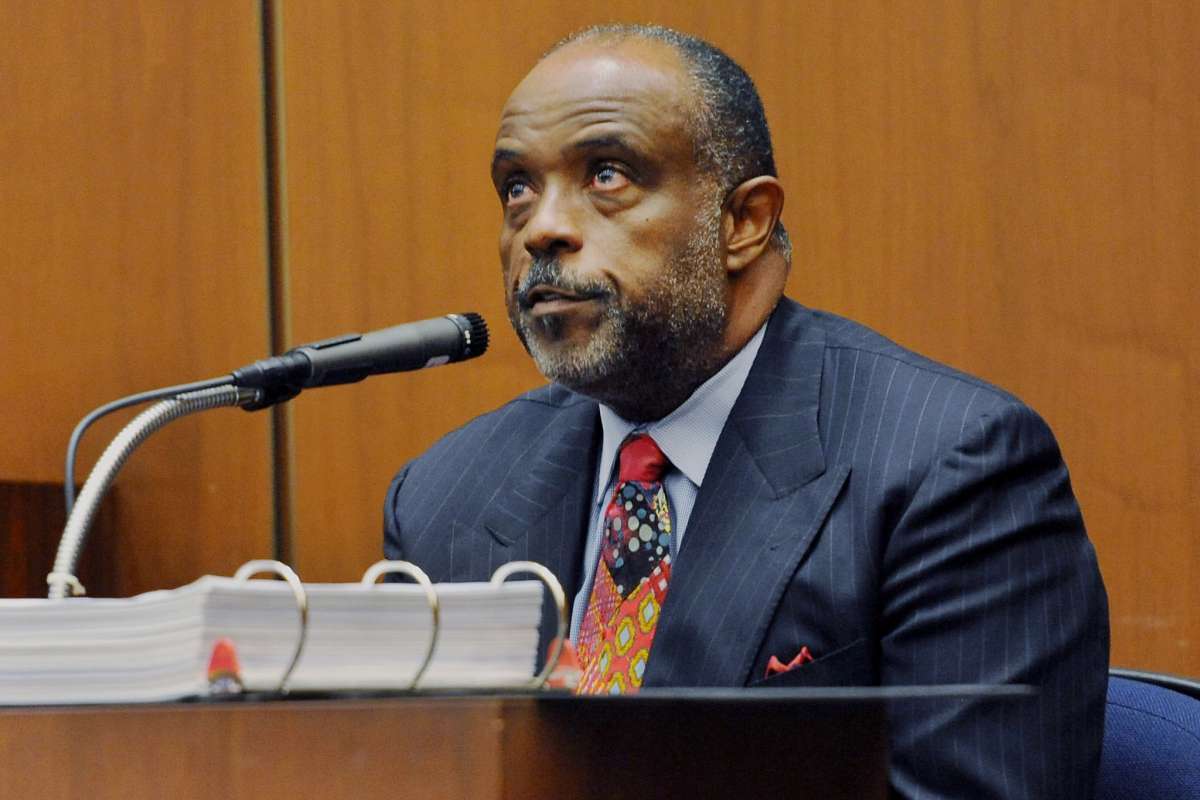
With the state Supreme Court having given its blessing, it seems all but certain that Gov. Jerry Brown will pardon former state Sen. Roderick Wright (D-Inglewood), who was convicted of voter fraud and perjury four years ago.
In fact, I would be surprised if he didn’t, and soon. Wright was a popular politician who many believed was unfairly targeted by the district attorney for simply misinterpreting the residency rules for state lawmakers. The law says state legislators must live in the district they seek to represent. But what does “live in” mean?
It’s actually a more complicated answer than you might think. California is a big state, and the job of a full-time legislator means they must spend a considerable amount of time in Sacramento. Many choose to maintain a home in that city, and even enroll their kids in school there. That seems reasonable.
Wright’s case, however, was not about spending time in Sacramento. He rented an apartment in a working-class neighborhood in his South Los Angeles district but was actually doing his real living at a nice home in a nearby community that was outside the district’s boundaries. The D.A. thought that was a violation of the trust of voters; so did the Los Angeles Times editorial board.
As part of his sentence, besides a very brief jail stay,Wright was forbidden from running for public office again. Nevertheless, he has continued to be a force in Sacramento, though now as a lobbyist.
Pardoning Wright will erase those felonies and, I fear, also the imperative for current and future legislators to live in their districts. SB 1250, passed earlier this year, pushes lawmakers in the same unwelcome direction. The bill, authored by the senator who replaced Wright in the South L.A. district, loosened the rules for legislators regarding maintaining homes outside their districts.
As a new class of legislators gets ready to take the oath of office next month, its members should also remember the pledge they made to voters during the campaign — that is, to be a true representative of their district. Not just an occasional visitor.
- Share via
Letting U.S. troops open fire on migrants would make the stupid decision to deploy them even worse

President Trump may be about to make a bad decision even worse.
In the run-up to the midterm election, Trump tried to turn the northward flow of a few thousand desperate Central Americans into a crisis of sovereignty, describing the parade of young men, mothers and children as an “assault” on the border, which he threatened to close.
So like any commander in chief who has no idea what he’s doing, Trump ordered active-duty troops to the border to augment the 6,600 federal agents already patrolling there. Under the Posse Comitatus Act, the military cannot be used for domestic law enforcement purposes on U.S. soil. So the Pentagon has deployed up to 7,000 troops, many of them unarmed, to aid in surveillance, build or mend fences, improve fortifications of border crossings, and other such non-military work.
Now it seems the Pentagon is considering changing directives to the troops to allow them to use their weapons to defend border agents from attack. That might thread the needle of the law, but it certainly violates the intent to limit U.S. armed forces’ domestic deployments and preserve them for defending the country from attacks and militarized threats abroad.
It’s hard to see where firing combat weapons at the unarmed and desperate fits in with a military mission. And it’s not like the Border Patrol has trouble defending itself — agents used their firearms 17 times last year, down from 55 incidents five years before.
But allowing active-duty troops to also use their weapons to protect the already armed Border Patrol escalates the risk that frustrated migrants throwing rocks might get shot, an egregiously out-of-balance response. And it’s not that the troops are trigger happy. It’s more a matter of training and purpose.
This reminds me of the end of the war in Kosovo two decades ago, where I watched a mob of ethnic Albanians on the south side of the Ibar River in the city of Mitrovica face off against ethnic Serbs who lived on the north side. French troops occupied the main bridge over the river and kept the two groups apart. But the Albanians kept trying to cross the bridge, a human tide the French troops had trouble countering because, as one officer told me, they were trained to kill in combat, not control unarmed and unruly mobs.
So a squadron of Italian police — who were trained in crowd control — was deployed to serve as a buffer between the crowd and the troops, and the confrontation slowly wound down.
It’s a good lesson to remember. Trump deployed the troops as a bit of political theater, and as playwright Anton Chekhov once observed, a gun introduced in the first act will get used in the third. That would turn the farce at the border into tragedy.
- Share via
At least Trump didn’t blame Jamal Khashoggi’s death on a 400-pound hacker

The killing of journalist Jamal Khashoggi and the U.S. intelligence community’s conclusion that Saudi Crown Prince Mohammed bin Salman is probably responsible would be a challenge to even the most judicious and thoughtful U.S. president. The U.S.-Saudi relationship is long-standing and important, yet the United States cannot be seen to condone the state-sponsored assassination of a journalist.
Of course, President Trump is far from being that ideal president, as is clear from the embarrassing statement about Khashoggi’s killing he released Tuesday.
Reading more like the transcript of a Twitter thread or a Fox News interview than a considered foreign-policy pronouncement, Trump’s statement opened with his “America First” campaign slogan — followed by an exclamation point — and the likewise exclamation-pointed observation that “The world is a very dangerous place!”
Then came an exercise in relativism, with Trump ticking off the sins of Iran (including responsibility “for a bloody proxy war against Saudi Arabia in Yemen”) and a reference to how much money Saudi Arabia spends and invests in the United States. (His estimates of the value of Saudi investment have been widely questioned.)
In the fifth paragraph, Trump finally got around to saying: “The crime against Jamal Khashoggi was a terrible one, and one that our country does not condone.” He then boasted of the sanctions the U.S. was imposing on 17 Saudis identified as being involved in Khashoggi’s killing in Turkey and the disposal of his body.
But what about the crown prince, the de facto leader of Saudi Arabia, whom the CIA reportedly has blamed as the author of the plot?
Trump said that “it could very well be that the crown prince had knowledge of this tragic event — maybe he did and maybe he didn’t!” (Or maybe the killing was ordered by somebody sitting on his bed who weighs 400 pounds.)
“That being said,” Trump continued, “we may never know all of the facts surrounding the murder of Mr. Jamal Khashoggi.” But he left the impression that it wouldn’t bother him that much if the crown prince was proved to be responsible.
“In any case,” he went on, “our relationship is with the Kingdom of Saudi Arabia. They have been a great ally in our very important fight against Iran.” (The notion that Iran is uniquely nefarious isn’t just Trump’s view; it’s the policy of his State Department.)
Toward the end of his statement Trump left the door open to approving additional sanctions pressed by Congress, which he referred to disparagingly as people motivated by “political or other reasons.”
But in its totality, the statement was a tone-deaf invocation of American interests narrowly defined and a cavalier rejection of any role in U.S. foreign policy for morality or human rights.
Again, framing a response to the apparent complicity of the Saudi leadership in Khashoggi’s death isn’t easy.
The Washington Post, for whom Khashoggi wrote opinion columns, suggested in an editorial Monday that the U.S. could “sanction and shun” the crown prince “while still doing business with the regime.”
Squaring that circle would be extraordinarily difficult. On Tuesday, though, Trump made it clear he’s not interested in even making the effort.
- Share via
Ivanka’s emails are an embarrassment, but she’s no Hillary Clinton

Supporters of Hillary Clinton in 2016 — and even a few non-supporters — are having a good laugh over the report that first daughter/senior advisor Ivanka Trump used a personal email account to transact official business.
On Twitter, John Dean (yes, that John Dean) opined: “Dems should run this to ground given her father thought a very big deal when it involved Hillary. So it’s got to be [a] big deal for Ivanka!” Newsweek in tweeting out its story used the inevitable teaser: “Lock her up?”
The mirth — and bitterness — are understandable. It’s an article of faith among Clinton supporters that the issue of her emails was overblown (including by the “liberal” media). And it’s hard not to chuckle at the irony of improper email traffic ensnaring the daughter of a president who claimed Hillary’s actions were “worse than Watergate.”
I don’t want to spoil anyone’s fun, but the differences between the Clinton and Ivanka email offenses are as noteworthy as the similarities.
First of all, Clinton was the secretary of State with access to sensitive information; Ivanka Trump has a vastly less important (and more amorphous) portfolio.
More important, the Washington Post, which broke this story, noted that the FBI eventually determined that 110 of Clinton’s emails contained classified information at the time they were sent or received. A spokesman for Ivanka Trump’s lawyer said that none of her emails contained classified information. If that’s true, it’s an important difference.
It’s possible to believe that Clinton was “extremely careless” in her handling of classified information (the quotation is from former FBI Director James B. Comey’s famous news conference) and that she a) shouldn’t have been prosecuted and b) should have been elected president rather than Donald Trump.
As the Los Angeles Times put it in a Nov. 2. 2016, editorial reiterating our endorsement of Clinton:
“There is no comparison between Clinton’s carelessness in corresponding with colleagues and the recklessness that Trump would bring to the conduct of actual foreign policy. And that is only one of a multitude of differences between the two nominees.”
Clinton shouldn’t have been “locked up” for her email infractions, and neither should Ivanka Trump based on what the Post has reported. That doesn’t mean the two situations are interchangeable, or that Democrats should see Ivanka’s indiscretions as somehow justifying Clinton’s carelessness with sensitive information or her penchant for secrecy.
It may not have been a crime — it shouldn’t have cost her the election — but it was a big deal.
- Share via
A federal judge tells Trump the obvious — he can’t ignore asylum law just because he doesn’t like it

It was clear from the start that President Trump didn’t have the legal authority under the Immigration and Naturalization Act to ban asylum requests at any place other than established ports of entry, but the administration went ahead with the order anyway.
Late Monday night a federal judge told the government to knock it off, at least for now.
“The rule barring asylum for immigrants who enter the country outside a port of entry irreconcilably conflicts with the INA and the expressed intent of Congress,” wrote Judge Jon S. Tigar in San Francisco. “Whatever the scope of the President’s authority, he may not rewrite the immigration laws to impose a condition that Congress has expressly forbidden.”
Hate to say we told him so, but ... actually, we don’t hate to say it at all. The president and the anti-immigration hard-liners among his advisors broke the law in denying asylum requests outside ports of entry. They also seem to be violating at least the spirit of asylum laws by throttling back the number of applications they are accepting at the border crossings each day, creating a growing backlog.
Yes, the law gives the president wide latitude in adopting and enforcing immigration regulations and policies, but it does not give him the power to rewrite or ignore fundamental aspects of the law. And the INA is explicit about how, where and when people may apply for asylum:
“Any alien who is physically present in the United States or who arrives in the United States (whether or not at a designated port of arrival and including an alien who is brought to the United States after having been interdicted in international or United States waters), irrespective of such alien’s status, may apply for asylum in accordance with this section or, where applicable, section 235(b). ”
I added the boldface to the text in case the White House counsel’s office reads this, because apparently the letter of the law wasn’t plain to the legal team the first time around.
Or maybe it was and the president just decided to forge ahead anyway and gamble that no one would stop him.
Presidents, of course, have the right to try to work through or even around laws and regulations as they feel necessary. President Obama did it when he crafted the Deferred Action for Childhood Arrivals program, granting reprieve to people who have been living here without permission since they arrived, usually with their parents, as children.
Congress repeatedly failed to devise a remedy for those folks, so Obama, while saying he couldn’t change immigration law, found a way to help the so-called Dreamers by invoking prosecutorial discretion. With 11 million people living in the U.S. illegally, the government must prioritize whom it removes, and Obama deemed Dreamers who met certain conditions safe from deportation until a permanent fix could be found.
Immigration hard-liners howled at the perceived abuse of executive power and sued, though courts so far have not found in their favor. But Obama’s move was framed within the latitude the law gives the president. Trump went further: The law does not give the president freedom to contradict Congress’ stated intention (see above) to, in this case, let asylum seekers make their requests once they reached U.S. soil, no matter where it might be.
That part of the law was based on the solid humanitarian idea that people fearing for their lives shouldn’t be turned away because they didn’t enter through a designated port.
Is the asylum system abused? Some people probably try to scam it, or make good-faith claims based on conditions that do not meet the stringent requirements of being likely to face death or persecution for their race, faith, nationality, political beliefs or membership in “a particular social group,” which has been subject to interpretation by the courts.
But we have a legal system for processing asylum requests and sifting out the false claims, and no presidential anti-immigration stance should compromise it.
The conditions at the border — a crush of desperate people seeking safety from dangerous conditions in their home countries — is a humanitarian crisis, not an immigration crisis. And it is heartless of the administration to respond to it with military deployments, blatant violation of asylum law, scapegoating and fear-mongering.
And it is distressing that so many Americans fall for it.
- Share via
Tobacco and alcohol companies have to post warnings about their products. Why do gun vendors get a pass?
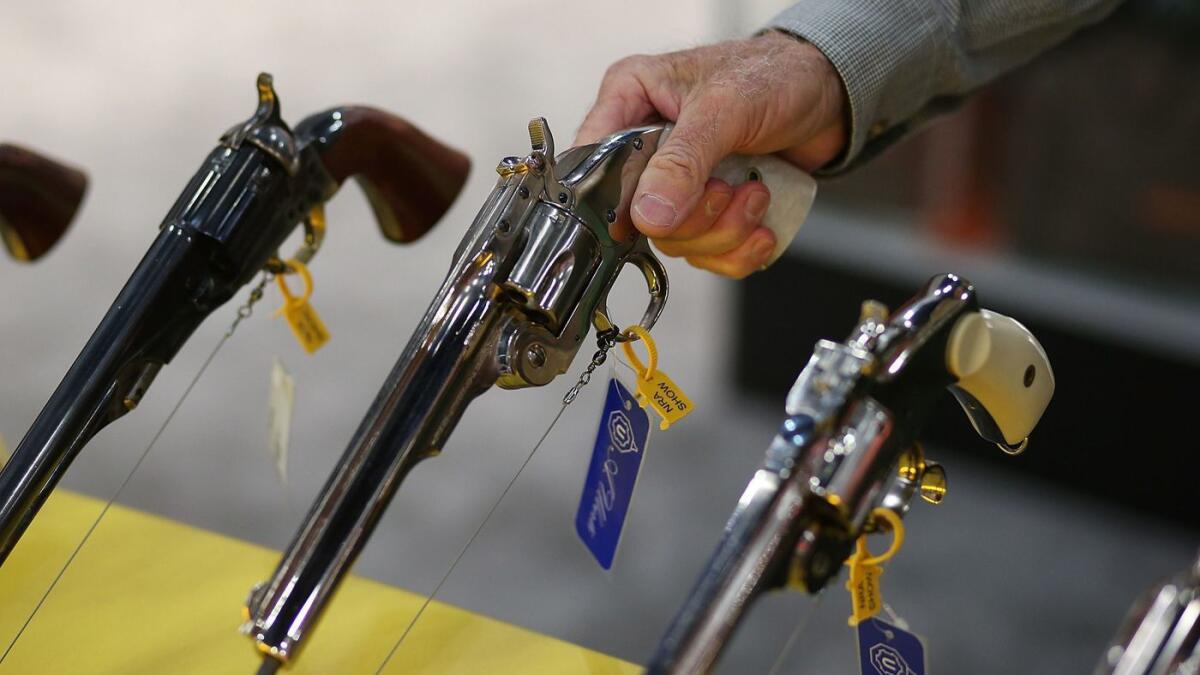
In California, businesses that sell products containing known carcinogens must post “clear and reasonable” warnings about the danger of exposure consumers face (remember that brouhaha about coffee?). Look at the side of a can of beer and you find a label warning that “drinking distilled spirits, beer, coolers, wine and other alcoholic beverages may increase cancer risk, and, during pregnancy, can cause birth defects.” Ditto for tobacco products.
But in Washington state, the King County Board of Health (think Seattle) has gone one better about a consumer product with a much more immediate risk of death. It recently ordered all gun vendors in the county to post signs warning of the increased risks of danger from possession of a firearm. The signs read: “Warning: The presence of a firearm in the home significantly increases the risk of suicide, homicide, death during domestic violence disputes and unintentional deaths to children, household members and others.”
As I noted recently, gun suicides far outpace gun homicides, and middle-aged white men are most prone to kill themselves with a gun.
Similarly, women in a house where a gun is kept have a significantly increased risk of getting shot to death during a domestic violence incident. (If they read this, I suspect fewer women would want to live in a house where a gun is present.)
The Everytown for Gun Safety group reported last year that a majority of mass shootings — four or more people shot dead, not counting the killer — from 2009-16 involved domestic violence.
Yes, we stand horrified if no longer shocked by the Thousand Oaks massacre, the Pittsburgh synagogue massacre, the Santa Fe High School massacre in Texas, the … well, here’s the list. Go revisit all the mass killings you’ve forgotten about.
But as a society, we also tend to ignore the routine carnage of one or two or three or four people shot and killed almost invariably by a father or husband or boyfriend who had easy access to a firearm.
In a dark irony, surveys on gun ownership find that where hunting once was the prime motivator for people buying guns, now it’s fear — a desire to own a gun for self-protection, even though violent crime has been in steady decline for a quarter century. And even though having a gun in the house increases the chances it will be used on a family member or acquaintance, such weapons are rarely used in self-defense.
People ought to know these things as they browse the gun cases, and the idea ought to spread far beyond King County. It’s a sane, if baby-step, approach to making sure that people who buy guns know what they’re getting themselves into.
- Share via
The White House just can’t stop making Jim Acosta look good
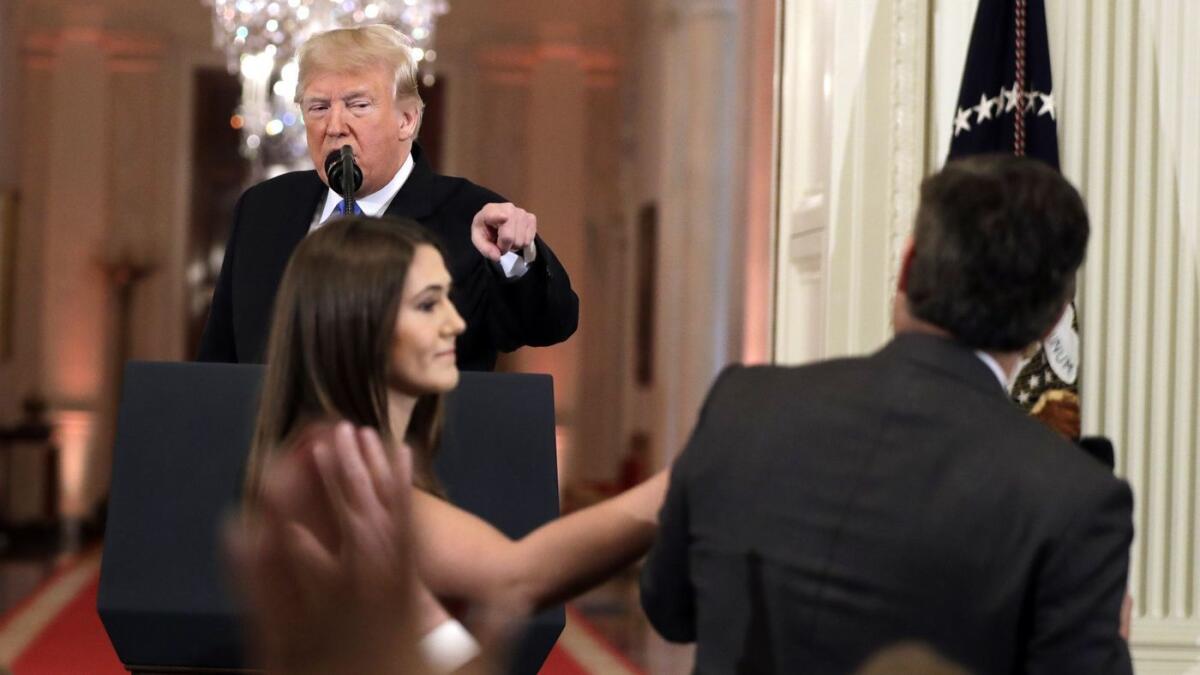
President Trump has a knack for elevating the people around him. Kind of like LeBron James — except, umm, different.
Take Trump’s ongoing feud with CNN White House correspondent Jim Acosta. For the second time this month, the president has turned Acosta into a sympathetic figure, which is remarkable to anyone who has seen Acosta ask a question in front of a live camera.
After a testy exchange during a press conference at the White House on Nov. 7, Trump’s press secretary, Sarah Huckabee Sanders, announced that Acosta’s security pass to the White House was being suspended. Sanders first accused Acosta of manhandling a female White House intern, then after CNN sued, she said Acosta had hogged the microphone in a disruptive way.
On Friday, a federal judge (who was a Trump appointee, no less) issued a temporary restraining order against the White House, saying the summary suspension had most likely violated Acosta’s right to due process. On Monday, however, CNN was asking for U.S. District Judge Timothy J. Kelly’s help again, saying the White House was trying to renew Acosta’s suspension before the parties were scheduled to return to court.
Kelly’s specific instruction — agreed to by attorneys for both CNN and the White House — was for the two sides to review his ruling and return to court Monday to discuss how to move forward, possibly with a mutually agreed upon schedule for the remaining court dates. The White House apparently had other ideas. What it did instead was try a do-over that would formally suspend Acosta’s pass by Monday afternoon, while still acknowledging that Acosta would retain his pass as long as Kelly’s temporary restraining order remained in place.
You can’t blame Sanders and her boss, White House Communications Director Bill Shine, for going through Kelly’s order and trying to correct the deficiencies the judge cited. On Friday they wrote Acosta a letter saying his pass was going to be suspended; the letter gave him a chance to respond and made clear who was deciding the issue (ultimately, Trump).
The problem is that it’s not really due process when you make up a rule and apply it ex post facto. That’s what the White House is doing here, by its own admission.
“We had not previously thought that a set of formal rules for journalists’ behavior at press conferences was necessary,” Sanders and Shine wrote. Instead, they said, there was a “widely shared understanding” that reporters would not hog the microphone. They would ask but a single question when called upon, unless the White House deigned to allow a follow-up or two, and then let someone else have a turn.
That’s a pretty good description of the decorum that is supposed to rule the press room, but it’s violated from time to time by reporters who can’t seem to get the president (whoever it happens to be, not just this one) to answer in the complete and forthcoming fashion they desire. Over the years, the decorum has been (more or less) maintained informally, by pressure from one’s peers and from White House staff.
Suddenly applying far more serious consequences to violating the informal rules of decorum is a sharp shift from past practice. Neither Acosta nor any other White House correspondent was given notice of that change; they all may be on notice now, but they certainly weren’t on Nov. 7.
That’s why what Sanders and Shine (and Trump) are doing to Acosta is fundamentally unfair. Here’s hoping that it will be seen as legally deficient as well.
Update, 1:21 p.m.: Apparently, even the White House recognized the inequity of cracking down on Acosta for violating rules that had not yet been written. The administration announced Monday afternoon that it was dropping its effort to lift Acosta’s press pass. Instead, it said, it was putting all correspondents on notice of the new rules it had sought to apply retroactively to the CNN reporter — reporters cannot ask more than one question (unless the White House chooses to permit follow-ups) and must “physically surrendering the microphone to White House staff” immediately thereafter, or risk losing their press pass — with “a more elaborate and comprehensive set of rules” threatened if reporters “unprofessional” conduct spreads to encounters outside formal press conferences.
Still, Sanders couldn’t resist getting in another dig: “We have created these rules with a degree of regret,” she said in a statement circulated through the press pool. “For years, members of the White House press corps have attended countless press events with the President and other officials without engaging in the behavior Mr. Acosta displayed at the November 7, 2018 press conference. We would have greatly preferred to continue hosting White House press conferences in reliance on a set of understood professional norms, and we believe the overwhelming majority of journalists covering the White House share that preference. But, given the position taken by CNN, we now feel obligated to replace previously shared practices with explicit rules.”
- Share via
Julian Assange was secretly brought up on charges we’re still unaware of. Talk about scary
The U.S. government has been after WikiLeaks maestro Julian Assange for eight years, ever since the site published a cache of classified documents it had obtained from U.S. Army intelligence analyst Chelsea (then Bradley) Manning. And now we learn, through some sloppy legal paperwork, that Assange has secretly been charged by federal prosecutors.
With what, however, we don’t know. And that’s crucial.
Assange remains ensconced in Ecuador’s embassy in London, so the likelihood of him actually being extradited and prosecuted remain slim for now. But that would change if he wears out his welcome there, as some news outlets have reported he’s doing.
As The Times’ editorial board observed in 2010, the risk is that the government would bring a case against Assange and WikiLeaks that could conceivably be used against newspaper reporters and publishers, to the detriment of press freedoms. Obtaining leaked material and exposing government secrets are key aspects of what the news media do.
“Penalties have been imposed in the past on government employees who have leaked confidential information, but not on the reporters or editors who published it,” we wrote. “Is Assange a journalist? Assuming that he received and published information rather than obtaining it on his own, the answer seems to us to be yes. In principle, we can’t see a difference between WikiLeaks and one of the newspapers that published the information.”
Some Democrats might want to cast Assange’s behavior two years ago in a sharply different light. WikiLeaks bedeviled Hillary Clinton’s campaign by publishing emails stolen from campaign officials and the Democratic Party. (That’s one reason then-candidate Donald Trump repeatedly professed his love for the site.) Assange didn’t disguise his antipathy toward Clinton, which raised questions about whether he knowingly participated in an effort by Russian agents to swing the election toward Trump.
It’s easy to imagine special counsel Robert S. Mueller III pursuing Assange along those lines, given that Mueller has already brought charges against a number of Russian agents for allegedly meddling in the 2016 election. And one might think that such a prosecution would pose little risk of criminalizing journalistic behavior. There’s a clear line between providing an outlet for newsworthy material leaked by government whistleblowers and deliberately acting as a conduit for foreign, state-sponsored hackers, isn’t there?
Maybe not. If material is newsworthy — that is, if the public would be better off with the information out in the open — it may not matter from a journalistic perspective where it’s coming from or what the source’s motives might be. If Russian hackers had obtained emails by Clinton secretly promising to seek to overturn the 2nd Amendment or to reduce Social Security benefits after the election, would a U.S. newspaper be wrong to publish them, even if the editor knew how the emails had been obtained and why they were being offered?
These are tough issues, and it’s admittedly self-serving for folks in my position to suggest that the government tread carefully around them. Regardless, we know now that Assange is facing federal charges. One can only hope that they won’t set a dangerous precedent.
- Share via
Annoying or not, Jim Acosta deserves a White House pass
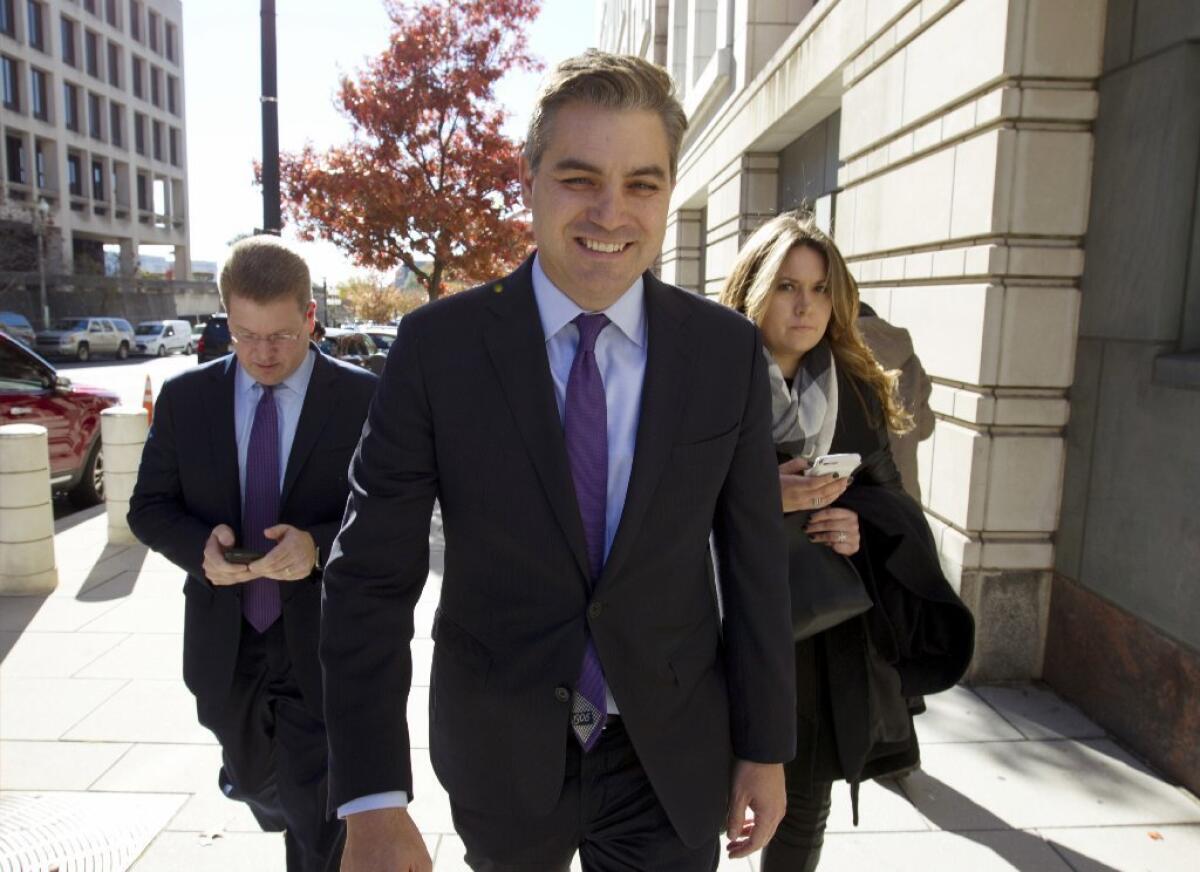
The Trump administration is putting a positive spin on a federal judge’s order that it restore the press credential of CNN’s Jim Acosta. But make no mistake: The temporary restraining order issued on Friday by U.S. District Judge Timothy J. Kelly (irony alert: a Trump appointee) is a defeat for the administration.
It should accept that defeat gracefully, and permanently restore Acosta’s “hard pass.”
Kelly’s order is a form of emergency relief, pending further action on the merits of CNN’s lawsuit. That’s why White House Press Secretary Sarah Sanders emphasized after the ruling that Acosta’s hard pass is being “temporarily” reinstated.
Sanders also made much — too much — of what she said was Kelly’s view that “there is no absolute 1st Amendment right to access to the White House.”
Actually, CNN’s 1st Amendment argument was a more nuanced one: that the decision to blackball Acosta was “a form of content- and viewpoint-based discrimination” and an act of retaliation for protected speech. And while it may not have figured in Kelly’s order, that argument can be addressed in further proceedings.
In issuing his order, Kelly focused on CNN’s other constitutional argument: that the White House violated Acosta’s due process rights under the 5th Amendment by not providing him with advance notice of the revocation or a way to challenge it. Kelly said that the way the White House decided to deprive Acosta of his credential was “so shrouded in mystery that the government could not tell me . . . who made the decision. “
Sanders said that her staff will “further develop rules and processes to ensure fair and orderly press conferences in the future. There must be decorum in the White House.” Trump echoed that call for civility in an exchange with reporters, saying: “You can’t take three questions and four questions. You can’t stand up and not sit down.”
Fair enough. It would be hard to object, for example, to a protocol that reporters surrender the microphone after one or two questions. But the White House can insist on decorum without casting Acosta or other reporters the president finds annoying into the wilderness.
- Share via
Orange County is blue and Richard Nixon is rolling in his grave
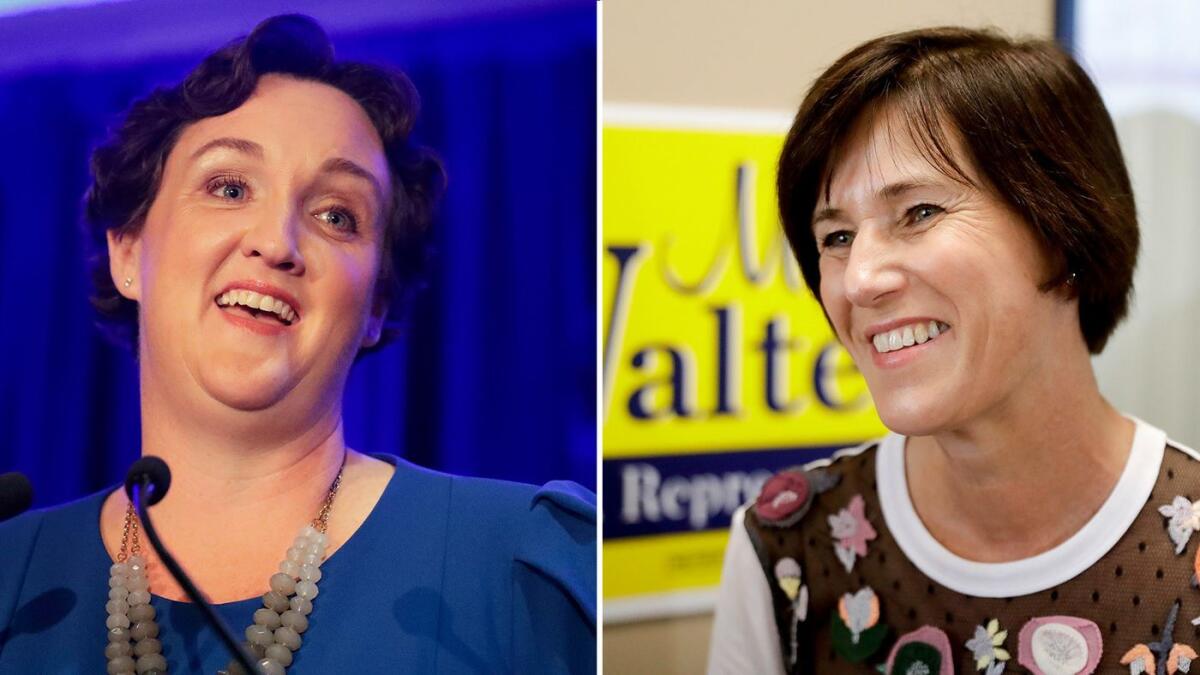
What a difference (checks calendar) eight days make.
The morning after election day, things looked grim for Orange County Democrats, who had entered the fall election full of hope and enthusiasm. Election night results showed county votes falling largely behind Republicans in the House and statewide races. Although Rep. Dana Rohrabacher of Huntington Beach, the most vulnerable of the Republican House incumbents, looked like he was headed for defeat in the coastal 48th District, Republicans were leading in other county-centric House races, and O.C. votes for statewide candidates were falling on the red side of the ledger even as Democrats were winning in the overall count.
“But wait!” activists said. “They’re still counting votes!”
And so they were, and are. As of the end of the counting day Thursday, the tide had turned.
In the 45th Congressional District, as reliably Republican as Pat Nixon’s cloth coat, incumbent Rep. Mimi Walters (R-Laguna Beach) now trails her Democratic challenger, UC Irvine law professor Katie Porter, and the math doesn’t favor a Walters recovery. The Associated Press projected Porter the victor Thursday afternoon; the official tabulation continues.
In the race to succeed Republican Ed Royce in the 39th District, which lies mostly in northern Orange County with some splash over into Los Angeles and San Bernardino counties, former Royce aide Young Kim had been edging Democrat Gil Cisneros. And though Kim still leads the O.C. vote, Cisneros has caught up enough that, combined with the votes in the neighboring counties, he has a slight lead.
Kim, parroting top Republican talking points and without offering evidence, has accused the Cisneros campaign of interfering in the count by “harassing and intimidating vote counters in Orange County. She also said her rival has earned a rebuke from the Los Angeles County registrar of voter for physical ballot tampering.” Except the registrar’s office says it did no such thing.
Walters similarly has impugned the integrity of the vote count, also without evidence. Thanks, President Trump, for injecting conspiracy-theory idiocy into the election process.
Anyway, the vote count has also turned blue for most of the statewide results in Orange County. The morning after election day, Republican gubernatorial candidate John Cox led Democrat Gavin Newsom, and other Republicans down the statewide ballot similarly were getting the love: Mark P. Meuser in the secretary of state race, and Konstantinos Roditis in the treasurer’s race.
Not so much any more. And that slight rumbling sound from Yorba Linda is Richard Nixon rolling in his grave.
- Share via
Facebook was built for marketers, not users. So of course it’s being used to manipulate the public
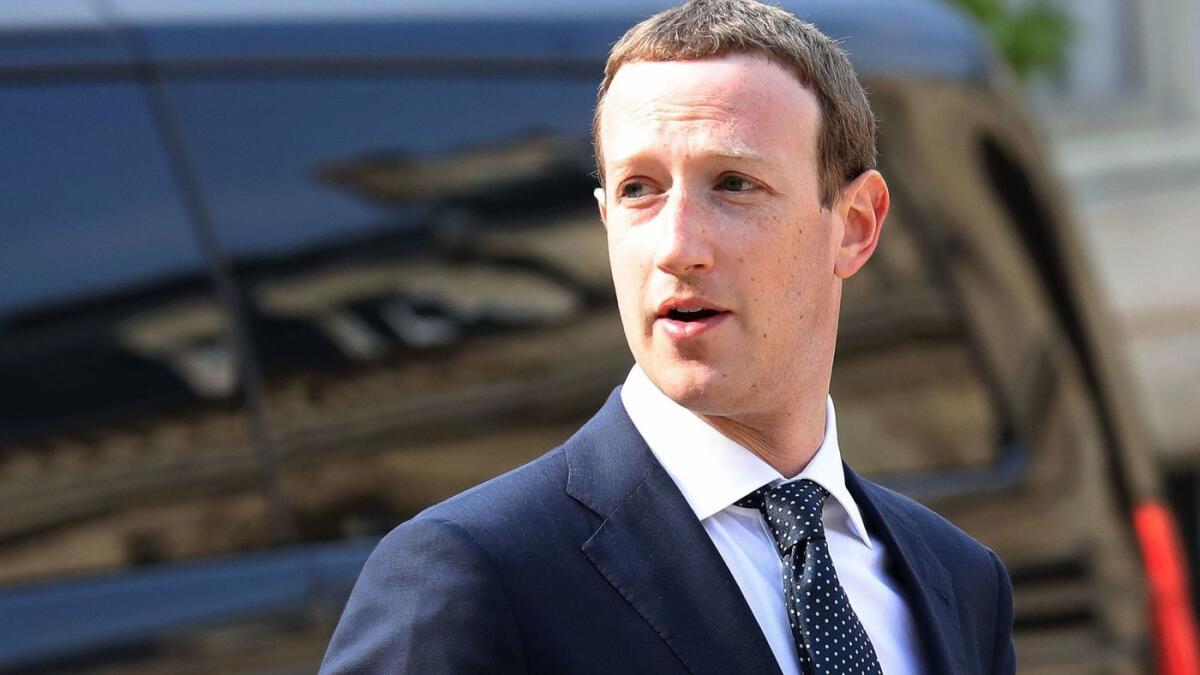
A few days after the 2016 election, I attended the Techonomy tech conference in Half Moon Bay where Facebook Chief Executive Mark Zuckerberg gave a rare interview. Reports were swirling at the time about people plying Facebook with fake news items in an effort to boost Donald Trump’s successful campaign, and Techonomy founder David Kirkpatrick asked whether Zuckerberg thought the social network had influenced the outcome. The youthful billionaire essentially laughed Kirkpatrick off:
We now know just how misguided Zuckerberg was about the uses of his company’s platform. Facebook has spent much of the Trump presidency dealing with revelations not just about fake news, but about foreign meddling in U.S. affairs and the mobilization of hate-fueled mobs around the world.
This week the New York Times triggered another wave of criticism with a lengthy investigation recounting how much effort Facebook put into denying its problems and attacking its critics. Responding to the Times’ tl;dr piece with one of his own, Zuckerberg unleashed a kajillion-word blog post outlining the steps Facebook has been and will be taking to minimize the amount of harmful content its users publish. He also dumped the right-of-center consultants who had defended the company too, umm, aggressively.
The third paragraph of Zuckerberg’s post lays out important questions about how to govern a social network with global reach and deep penetration: “What should be the limits to what people can express? What content should be distributed and what should be blocked? Who should decide these policies and make enforcement decisions? Who should hold those people accountable?”
But as important as those questions are, that paragraph ignores the whole reason Facebook exists, which is to create a compelling way for marketers — of products, services, ideas or anything else an entity with money wants to promote — to reach people who might respond to their messages. Advertisers are Facebook’s sole source of revenue; the company’s stock in trade is learning so much about its users that it can target an advertiser’s messages better than other platforms can. And in order to display more advertisements, the company tweaks the site’s core function — the distribution of users’ posts — to maximize the amount of time users spend on Facebook. The key piece of that equation is elevating content that’s popular within each user’s group of friends, and downplaying posts that are not.
In other words, Facebook is purpose built to funnel messages, particularly commercial ones, to the people most likely to respond to them. So of course it became a useful tool for people eager to manipulate the public for malign purposes. The same features that make Facebook ideal for the peddlers of goods make it ideal for the peddlers of rumors, lies and hate.
That’s why Facebook finds itself shifting uncomfortably into the mode of a content arbiter, not merely a content distributor. Zuckerberg went on at length (but not in much detail) about this effort, the most telling aspect of which was a new initiative to address content that’s objectionable even while complying with the company’s terms of service. This would be what Zuckerberg called “more sensationalist and provocative content,” which he said draws more comments and shares (“engagement”) than less red-meaty fare.
No surprise there — as we say in the newspaper biz, if it bleeds, it leads. In response, Facebook plans to use artificial intelligence to identify and downplay such items. Zuckerberg said the point was to remove the incentive to post such material; another way to look at it is an effort to make Facebook a less efficient pipeline for propagandists. Yet it won’t work unless the AI is exceptionally good at distinguishing the popular stuff that’s welcome from the popular stuff that’s not.
And even then, there remains the question of who should decide what should and shouldn’t be permitted or prioritized by the site. Free-marketers would argue that it’s a private company, so Facebook should govern itself as it wishes. If people don’t like the site’s choices, they don’t have to use it. But Republicans in Congress, who used to be free-marketers, have been suggesting that the government should have a role here because Facebook (and other big Silicon Valley companies) are not making those choices honestly, and instead are discriminating against right-of-center speakers.
Zuckerberg pledged to give users the ability to appeal when content is blocked (or not blocked), with such decisions eventually being handed over to an independent body. That could be a tremendous improvement in fairness and transparency. He also said he’d support some governmental regulations on internet companies, specifically a mandate “to report the prevalence of harmful content on their services and then work to reduce that prevalence.”
That might be helpful, although it could put Congress on a slippery slope toward regulating content online. Still, even the steps Zuckerberg outlined don’t get at the bigger and more important questions swirling around Facebook. Wrote Zuckerberg, “One of the most painful lessons I’ve learned is that when you connect two billion people, you will see all the beauty and the ugliness of humanity.” Facebook’s problem is not that it has surfaced ugliness, it’s that its network has been used to magnify it.
- Share via
California has some of the toughest gun laws in the country. They clearly don’t go far enough
It may be that California has temporarily exceeded its capacity for processing tragedy, and grief, after two major fires with horrific damage and death and the mass shooting at a Thousand Oaks country dance bar. But we can’t let ourselves become overwhelmed because, unfortunately, we’re likely to endure repetitions of both.
Devastating wildfires are not one-offs here. They are part of the natural cycle, though our insistence on building communities in places we know will burn overlays the grids of civilization on wild space, adding fuel to the fires and human losses to the natural toll. My colleagues on the editorial board have written eloquently about this, so I’ll leave it alone. But we know what needs to be done to lessen our exposure to the dangers.
Similarly, we know what needs to be done to reduce our risk of getting shot and killed as we go out dancing or visit a house of worship. We need stronger gun controls so fewer people have access to fewer firearms.
California has some of the toughest gun laws in the country, yet they clearly don’t go far enough, which most of us recognize. A recent Public Policy Institute of California poll found that as tough as our laws might be, 64% of us – nearly two of three people – think the gun laws should be stricter. Only 13% think they ought to be looser.
And that tracks generally with a recent national Gallup poll, which found that 61% of people think we needed tougher gun laws, and only 8% think they ought to be less restrictive.
It’s irrational to think that massive gun buyback programs, hard-line laws covering background checks and firearms transfers, or even limits on the numbers of guns one person may own will do much to sweep firearms off the streets. There are hundreds of millions of guns out there, yet because of the lobbying influence of the National Rifle Assn., the government doesn’t know how many. Still, large amounts of them are being bought and sold illegally, stolen from cars and homes, and moved across state lines from places with loose controls to places with tighter controls.
But toughening access to firearms is necessary nonetheless. This is a long-range fight. There is no legitimate reason for civilians to own firearms designed for military purposes. There is no legitimate reason not to insist that all gun buyers pass a background check. There is no legitimate reason for putting the sporting interests of target shooters ahead of the right of the rest of us to not get shot.
Most of us know this. Most of us know that the presence of a firearm in the house increases the risks of murders by intimate partners, of accidental shootings by curious youngsters, and of impulsive suicide by the gun owner or a close relative or friend.
We just need to keep pushing.
- Share via
Oceans are warming. Thankfully, not as fast as we thought two weeks ago
Well, that was unfortunate.
A study released a couple of weeks ago reporting that oceans were warming faster than previously anticipated turns out to have been off by a bit. By a large bit, in fact.
Short version: There was a problem with the math, as pointed out by a critic.
But the oceans are still warming.
This is the update that co-author Ralph Keeling posted the other day on the Scripps Institution of Oceanography website:
“I am working with my co-authors to address two problems that came to our attention since publication. These problems, related to incorrectly treating systematic errors in the O2 measurements and the use of a constant land O2:C exchange ratio of 1.1, do not invalidate the study’s methodology or the new insights into ocean biogeochemistry on which it is based. We expect the combined effect of these two corrections to have a small impact on our calculations of overall heat uptake, but with larger margins of error. We are redoing the calculations and preparing author corrections for submission to Nature.”
So, what does all that mean?
At heart, the researchers overstated the certainty of the findings. Statistics wonks can find more details here.
But even with the better-weighted certainty of the results, the cold, er, warm truth is that the atmosphere and the oceans are indeed getting hotter as a result of humans burning fossil fuels, adding heat-trapping gases to the air.
The phenomenon already is affecting climate and exacerbating extreme weather, and has helped convert our seasonal struggle here in California with wildfires into a year-round battle.
And the world is moving much too slowly to address it in meaningful ways. And focusing too much on a math error in one study misses the burning forest beyond.
- Share via
If Mitch McConnell wants bipartisanship, maybe he should be the one to give it a try
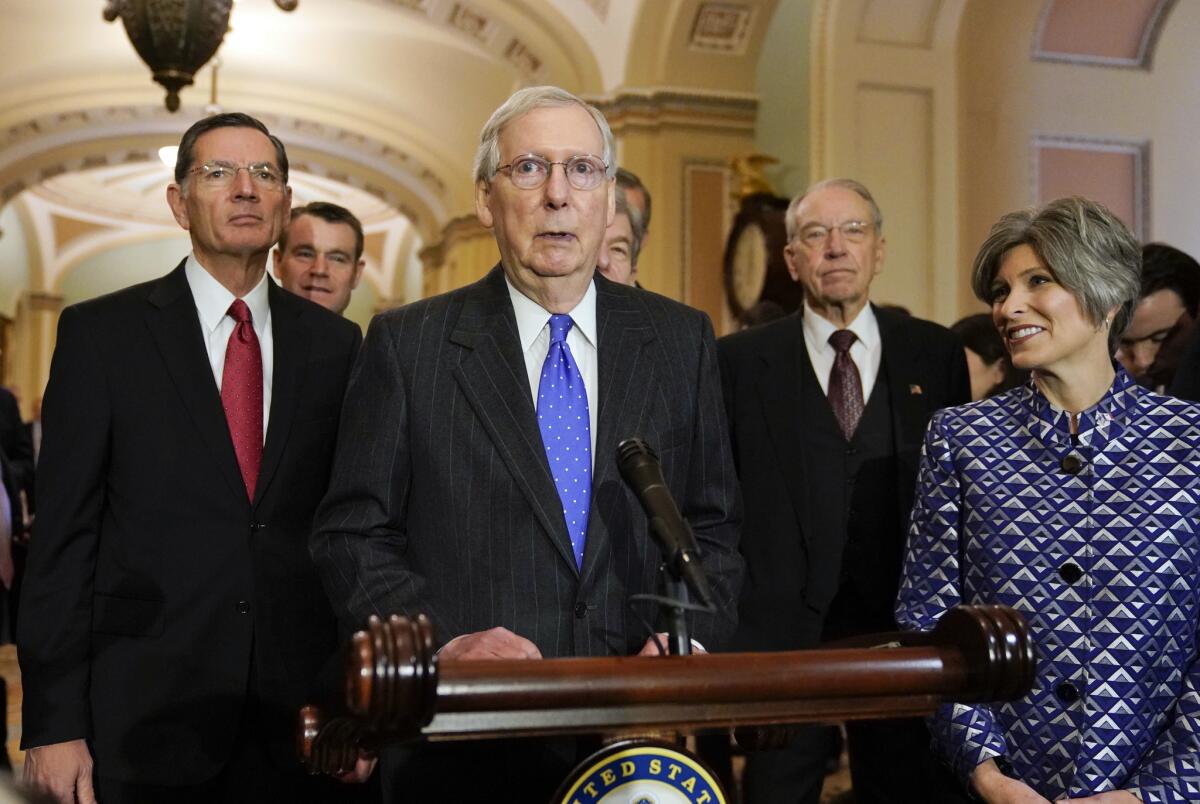
It’s too easy to mock Senate Majority Leader Mitch McConnell (R-Ky.) for writing a paean to bipartisanship … for Fox News’ website.
So I leave that task to others. Of whom there are many.
Instead, allow me to offer two critiques. First, when McConnell touted the achievements of the “unified Republican government,” he failed to mention how divisive all of those accomplishments were. So divisive, in fact, that none of the pieces of legislation he cited could have passed under ordinary Senate rules. Instead, the regulatory repeals, the tax cuts and the judicial confirmations all were made possible by procedural shortcuts that barred filibusters and deterred amendments.
Come to think of it, under McConnell’s leadership the Senate eliminated the filibuster for Supreme Court nominees, turning what had been a bipartisan exercise in advice and consent into a partisan one. (Not that Democrats have earned plaudits on that front either; it was their idea to eliminate the filibuster on lower court nominees, which set the unwelcome precedent.)
As long as the minority party has enough members to successfully filibuster, ordinary business in the Senate cannot be accomplished unless the two parties work together. That’s why Republicans and Democrats on the Senate Appropriations Committee, whose work McConnell lauded, have routinely worked collectively on the annual spending bills. Contrast that with the Budget Committee, whose annual budget resolutions are far more partisan in large part because they cannot be filibustered. (That is, when Congress bothers to pass a budget resolution, as required by law.)
My second critique is that it’s pointless for any senator to lecture the House on bipartisanship. Since seemingly forever, and certainly since former Rep. Newt Gingrich led a Republican takeover of the House in 1993, the chamber has operated under the tight grip of the majority party. Worse, it has frequently limited debate and amendments on bills under rules set by the majority, largely for the sake of blocking input from the minority (and dissident members of the majority).
Is it possible that McConnell has never heard of the Hastert rule? Disgraced former Republican Speaker Dennis Hastert of Illinois created that one in the mid-1990s, albeit just informally. It was a promise by the GOP leadership not to bring any bill to the House floor that wasn’t supported by a majority of the chamber’s Republican members. After Republicans retook control of the House in 2010, Speaker John Boehner of Ohio turned the pledge up a notch, promising not to bring any bill to the floor that couldn’t pass with Republican votes alone. He and Paul Ryan (R-Wis.), his successor, made a few exceptions, but the message was clear: No Democratic ideas welcome.
The most risible part of McConnell’s piece was when he wrote of the new House Democratic majority, “Will they choose to go it alone and simply make political points? Or will they choose to work together and actually make a difference?” Because the GOP House majority took the go-it-alone-and-make-political-points path for two entire sessions of Congress, from 2011 to 2015, while Democrats controlled the Senate.
House Democrats will certainly be pulled to the left by progressives who view centrism as a failure of political will. Yet McConnell’s caucus has its share of uncompromising legislators too, along with a Republican president who’s yet to prove himself capable of bringing divergent views together on a big issue.
There’s obviously no bipartisanship without concessions on both sides. If McConnell is willing to do his part, he should join Republican and Democratic leaders in both chambers in pushing their members to stop demonizing the other side and its ideas and start recognizing the need to find mutually acceptable paths. It’s impossible to reach consensus (or at least a reasonable amount of bipartisan buy-in) otherwise, and without that, policy whipsaws back and forth whenever majorities and administrations change — which they do in this country with startling regularity.
- Share via
Of course CNN should defend Jim Acosta. But don’t pretend that he was just ‘asking questions’
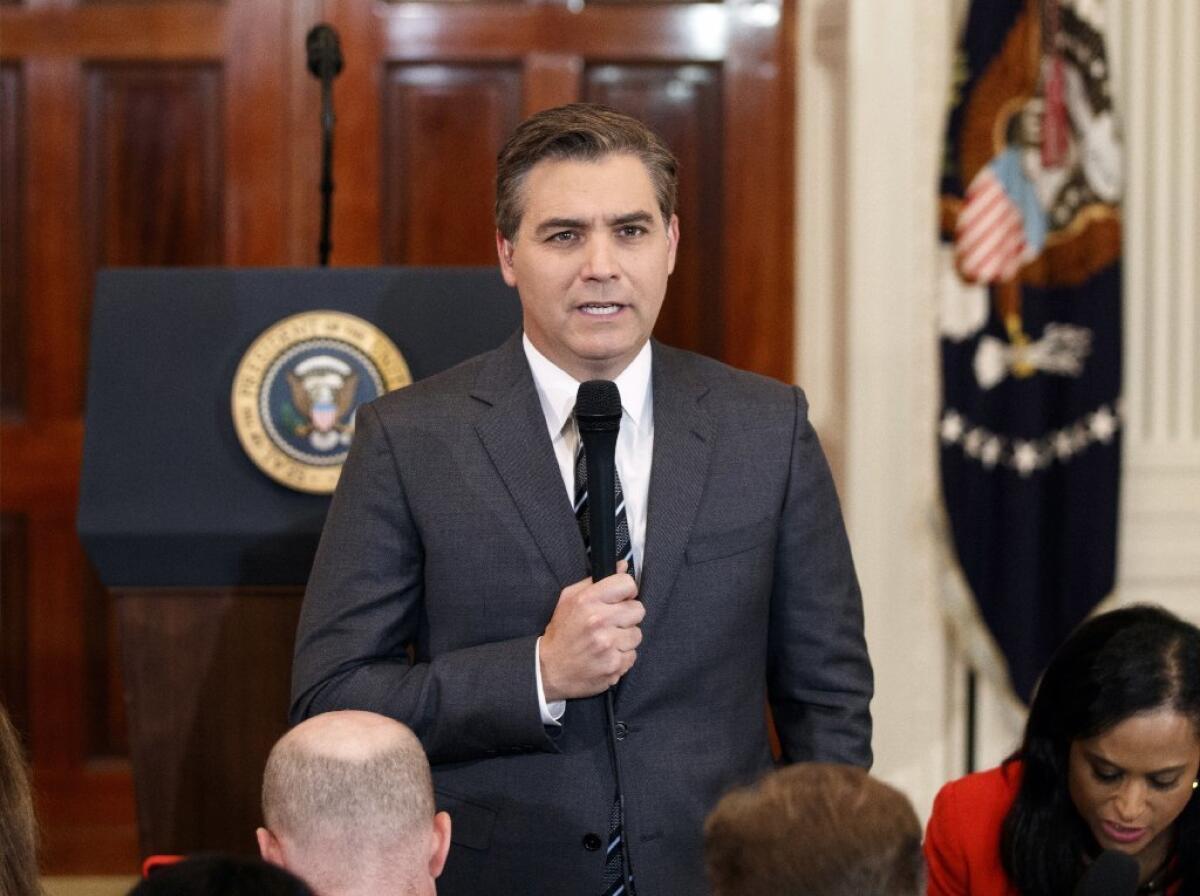
On Tuesday, CNN filed a lawsuit seeking to reverse the revocation of correspondent Jim Acosta’s White House press pass.
The complaint filed in federal court in Washington, makes a persuasive case that the administration‘s action was “the culmination of years of hostility by President Trump against CNN and Acosta based on the contents of their reporting — an unabashed attempt to censor the press and exclude reporters from the White House who challenge and dispute the president’s point of view.”
CNN is also correct in noting that the 1st Amendment has been interpreted by the Supreme Court as reflecting “a profound national commitment to the principle that debate on public issues should be uninhibited, robust, and wide-open, and that it may well include vehement, caustic, and sometimes unpleasantly sharp attacks on government and public officials.” The quotation is from the landmark 1964 libel case of New York Times vs. Sullivan.
What’s odd about CNN’s complaint is that it doesn’t acknowledge that engaging in an unpleasantly sharp attack on Trump is what Acosta was doing in the now famous Nov. 7 press conference that led to the revocation of his credentials.
The complaint says:
“Acosta asked a question about one of President Trump’s statements during the midterm campaign — namely, whether a caravan making its way to the United States from Central America constitutes ‘an invasion’ of the country, a significant feature of the President’s messaging during the just-ended campaign. The president declined to respond, instead remarking: ‘You know what? I think you should … I think you should let me run the country. You run CNN. And if you did it well, your ratings would be much better.’ “
This is misleading.
If you watch the video, you’ll discover that Acosta didn’t just ask whether the caravan constituted an invasion; he told Trump that “the caravan was not an invasion, it’s a group of migrants moving up from Central America towards the border with the U.S.” Then he asked: “Why did you characterize it as such?” Trump replied: “Because I consider it an invasion. You and I have a difference of opinion.”
Exactly. Acosta even prefaced his question by saying he wanted to “challenge you on one of the statements you made at the tail end of the campaign.”
The argument over the caravan got progressively nastier, with Acosta reminding Trump that the migrants were “hundreds and hundreds of miles away.” Then Acosta tried to ask a question about the Russia investigation, Trump told him, “That’s enough,” asked him to put down the microphone and called him a “rude, terrible person.” (Yes, it was an unpresidential comment.)
If you read the complaint closely, you’ll see that it does assert that Acosta and CNN are being punished for the “content and viewpoint” of their reporting. But the abiding impression is that Acosta was just asking questions.
To note that he in fact was debating the president doesn’t justify the yanking of his credentials or the White House’s suspiciously shifting explanations for that sanction. (The original explanation was that Acosta had manhandled an intern who tried to take the microphone from him; on Tuesday, Press Secretary Sarah Huckabee Sanders said the problem was that Acosta had “inappropriately refused to yield to other reporters.”)
Acosta isn’t unique in grandstanding at a presidential news conference. In 1974, after CBS’ Dan Rather received some applause when he stood up, President Nixon asked him: “Are you running for something?” Rather shot back: “No sir, Mr. President. Are you?”
Then and now, challenging the president shouldn’t be grounds for losing your credentials. But we shouldn’t pretend that Acosta was just “asking questions.”
- Share via
Who should police Jim Acosta and the White House press corps? Definitely not the president
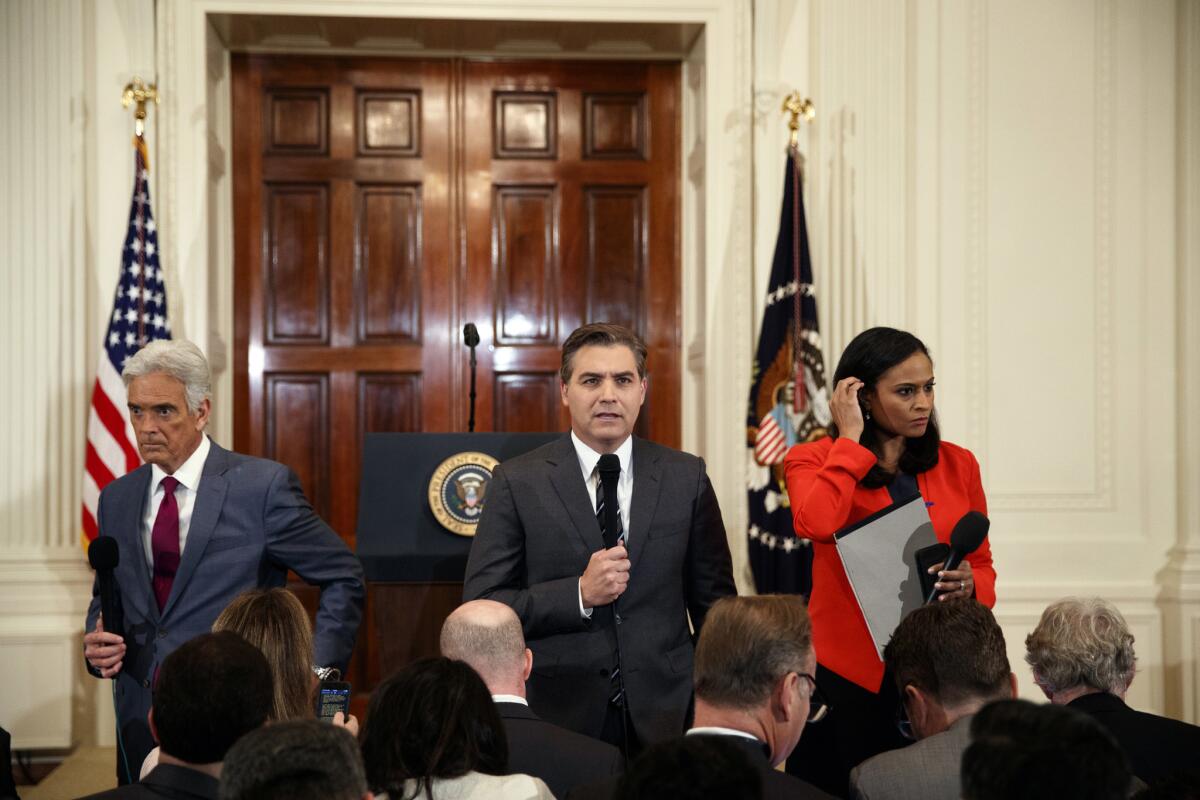
When the Trump administration yanked the White House press pass held by CNN’s Jim Acosta last week, Press Secretary Sarah Huckabee Sanders practically accused him of manhandling a female White House intern. On Tuesday, Sanders took a different tack, accusing him of manhandling the microphone he shares with dozens of other reporters in the White House press corps.
Responding to the lawsuit CNN filed against the suspension of Acosta’s press pass, Sanders said, “After Mr. Acosta asked the President two questions — each of which the President answered — he physically refused to surrender a White House microphone to an intern, so that other reporters might ask their questions.”
So much for the Acosta karate chop.
Sanders went on to argue that Acosta has been an unprofessional mic hog before, and that the constitutionally protected free press isn’t served when one reporter “attempts to monopolize the floor.” She concluded, “If there is no check on this type of behavior it impedes the ability of the President, the White House staff, and members of the media to conduct business.”
Amen, sister. There’s nothing worse than a reporter who is so inconsiderate of other journalists, he or she acts as if there’s no one else in the room with questions to ask and stories to write. I suspect that at least some of the other reporters at the press conference were secretly rooting for the intern in that struggle over the microphone.
That’s a far better argument than the one Sanders led with last week (although she did include a reference to it in her first statement, saying, “It is also completely disrespectful to the reporter’s colleagues not to allow them an opportunity to ask a question.”). It would still be a bad argument, however.
As someone who used to hold one of those coveted White House passes, the last thing I want is for the president — any president — to use a reporter’s apparent boorishness as an excuse to bounce him or her from the building.
First, it’s overkill. The White House already exerts a tremendous amount of control over reporters’ access to sources, which are the lifeblood of timely and accurate stories. (The Obama administration, for example, was notably antagonistic toward Fox News reporters.) It goes beyond the power to decide which reporters get called on to ask questions at press conferences. It’s deciding whose calls get returned, who gets briefed in advance, who benefits from strategic leaks, who stays one or more steps ahead of the pack.
Second, the process of obtaining a White House pass is designed to let journalists, not government officials, control eligibility. The main limits imposed by the White House are the security screenings it does to identify reporters who might pose security threats, and the locations it chooses for press briefings, which restrict the number of people who can attend.
If the president weeds out reporters he (or, someday, she) doesn’t like, that’s not respecting the 1st Amendment values Sanders claims the administration is championing. It’s hand-picking the people who get to report on the administration from a front-row seat.
If Trump doesn’t like the way Acosta asks questions, he doesn’t have to call on him. And if Acosta’s colleagues in the White House press corps believe he’s sucking all the oxygen out of the room — and they don’t seem to — they can lean on him privately to stop it. They have a trade association, after all; for the record, it issued a statement Tuesday supporting the goal of CNN’s lawsuit.
- Share via
Americans are so stubbornly inactive, public health advocates are getting desperate

Public heath advocates appear to be getting desperate over the state of Americans’ inactivity.
The U.S. Department of Health and Human Services on Monday released a new set of physical activity guidelines and they are...ah...interesting. Instead of prescribing the standard block of sustained physical activity — previously at least 10 minutes at a time — the government is now urging Americans to, you know, move around more during the day and sit less.
The reasoning is that any activity is better than none for people who spend most of their lives sitting down — in a car, on the train, in front of a computer, eating meals, watching television or surfing the internet — then they should do what they can to take breaks from the reclined life.
The guidelines continue to stress good old aerobic activity (150 minutes a week at least for adults) but say that all activity, even in short bursts, can count toward that goal.
But the reality is that the vast majority of people don’t get the currently recommended dose of exercise and these new “move around when you can” recommendations seem to be a resigned recognition by health officials Americans are spending too much time on their butts and that any exercise is better than none.
So, excuse me while I take a break and stroll over to the kitchen for a post-breakfast snack.
- Share via
Kirstjen Nielsen watch: How long before Trump bounces her from Homeland Security?
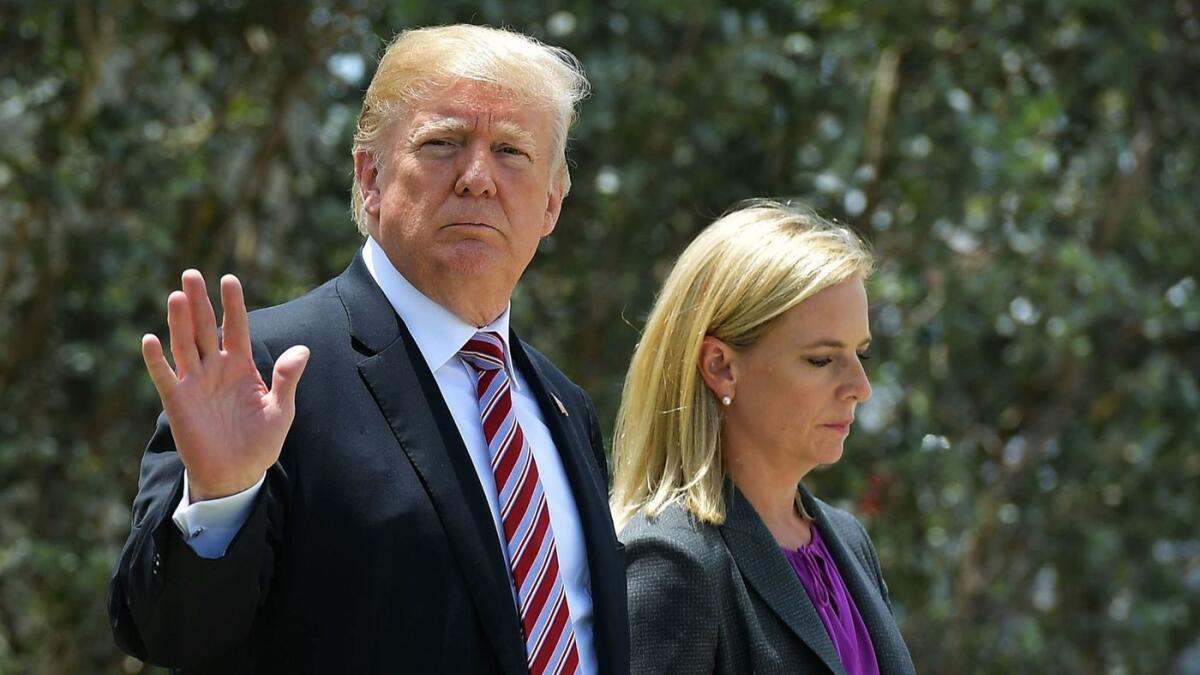
When we last dropped in on the soap opera that is the White House — call it “As the Trump Turns” — I speculated that President Trump would start axing top officials shortly after the election. I had the scandal-scarred Interior Secretary Ryan Zinke as the likeliest to go first, with Atty. Gen. Jeff Sessions probably second.
Sigh. Sessions went first, Zinke is still on the job, and now it looks like Homeland Security Secretary Kirstjen Nielsen may be the next to go. I had her at third on the list (with an asterisk for Sessions’ deputy, Rod Rosenstein, once Sessions left) so if this worked like March Madness, well, my bracket would be so busted.
Nielsen’s shortcomings in the eyes of her boss: She hasn’t been able to stop Central Americans from showing up at the United States’ southern border and requesting asylum. Trump’s displeasure boiled over in a Cabinet meeting in May, prompting news reports that Nielsen nearly quit then, though she and other top administration officials denied she had threatened to quit.
Note that Trump has never been particularly keen on Nielsen — he hired her at the urging of John Kelly, his chief of staff, for whom Nielsen had worked at Homeland Security. It didn’t matter that she had zero top management experience, and as Homeland Security secretary she has enacted policies seemingly drafted by the immigration hard-liners in the White House.
That includes moving to end temporary protected status for hundreds of thousands of people from Sudan, Nicaragua, Haiti and El Salvador who had been in the U.S. when crises in their home countries (hurricanes, earthquakes and war) made it too dangerous for them to go back there. Last month, though, a federal judge ordered the status be maintained while a lawsuit proceeded that accused the government of making a political decision to end the temporary protection, rather than making a fact-based decision that conditions had improved in the home countries.
Just the sort of behavior we’ve come to expect from this White House.
Anyway, if the reports are true, Nielsen will be the next to be tossed overboard/abandon ship. And that could cause even more chaos, since this dysfunctional White House never got around to appointing a deputy to work under Nielsen.
So unless Trump or his anti-immigration Svengali Stephen Miller have an interim appointee in mind, responsibility for running the department will fall to Claire M. Grady, undersecretary for management (and acting deputy secretary), whose expertise lies in budgeting, procurement and other management duties, not policy development and implementation, nor, for that matter, the care and feeding of Trump’s ego.
Of the nine Cabinet-level appointees, four have gone or announced they are leaving.
I’ve noted before that all presidents shuffle their top positions over the course of a term, but this administration has created and endured chaos like none other in recent memory. As a reminder, Trump was sworn in Jan. 20, 2017, just 22 months ago. Since then, at least 55 top administrators or White House officials have left, announced their departure or been fired – in the case of Anthony Scaramucci after only 10 days as White House communications director.
That includes five of the 15 Cabinet members – Sessions, Secretary of State Rex Tillerson, Veterans Affairs Secretary David Shulkin (whose first successor, Dr. Ronny L. Jackson, withdrew from consideration after revelations of his behavior as physician to the president), Health and Human Services Secretary Tom Price, and Homeland Security director John Kelly (to become Trump’s chief of staff).
Of the nine Cabinet-level appointees, four have gone or announced they are leaving – United Nations Ambassador Nikki Haley; Environmental Protection Agency director Scott Pruitt; Chief of Staff Reince Priebus; and Central Intelligence Director Mike Pompeo (to become secretary of State).
So for those keeping score at home, that’s nine of the 24 Cabinet or Cabinet-level positions — 38% of Trump’s upper tier of appointees — gone within two years, with more departures looming.
Given the way Trump treats many of his top appointees, and the infamous levels of backbiting and fiefdom-fighting, you have to wonder why anyone would take a job in that poisoned well in the first place.
- Share via
The new Democratic House will inherit an absolute mess of a federal budget
When Democrats take over the House of Representatives next year, they will most likely inherit a strong economy. That’s a good thing, given how messed up the federal budget is.
The federal deficit hit $779 billion in the fiscal year that ended Sept. 30, amounting to almost 4% of the U.S. economy. Although the budget gap isn’t nearly as large as it was in the depths of the last recession, it’s alarming to watch the red ink deepen at a time when the economy expands steadily.
The enormous tax cut Republicans approved in 2013 is partly to blame for that problem; it reduced tax revenues as a share of gross domestic product to 16.4%, while federal spending remained a little above 20% of GDP. And as the Committee for a Responsible Federal Budget pointed out, the tax cut didn’t cause a surge in federal receipts, as its supporters promised it would. Instead, the CFRB calculated, the change translated into a loss of 3.6% to 4.7% — and a more than 5% reduction in what the feds had been projected to take in prior to the tax cut.
A budget gap this large probably can’t be closed without some kind of boost in tax rates or collections. And if tax revenues were the only problem, the solution might very well be giving Democrats control over the tax-writing chamber of Congress.
But another big contributor to annual deficits is the projected growth in spending on healthcare programs, which presents a real challenge to the party that views itself as the last line of defense against benefit cuts.
The chart above, taken from the CBO’s latest long-term budget projections, shows how federal spending is expected to accelerate faster than revenues can keep up. While discretionary spending is expected to shrink, three other major budget categories are projected to grow, and grow rapidly: Social Security benefits, because of the rising number of retirees and the increasing size of benefits; Medicare, Medicaid, Obamacare insurance subsidies and the Children’s Health Insurance Program, in part because of a growing population of Medicare beneficiaries but in larger part because of higher treatment costs; and interest payments on the federal debt, mainly because the debt is growing.
The solution to larger debt payments is to pay down debt, which can’t happen until the budget gap is closed. And the gap won’t close unless Congress finds a way to slow the growth in healthcare spending.
Some readers might say Democrats have a solution to that too: Single payer! But (ahem!) Medicare, CHIP and Medicaid are already single-payer programs. And even when it comes to private insurance, it’s not clear that simply switching to single payer would slow the growth of treatment costs.
Instead, the challenge is multifaceted, starting with the higher amounts that Americans pay for medical services, devices and drugs. Then there’s the comparatively high incidence of costly chronic diseases, particularly those associated with obesity. One more factor is the continual development of new technologies and custom therapies that keep people alive longer — a great thing for humanity, but a bad thing for the federal budget.
Dealing with healthcare costs was never going to be easy, and Republicans made it that much harder by driving up the deficit — the exact opposite of what they should have been doing after the U.S. economy got back on its feet. Nevertheless, here we are. If Democrats want to be the party of fiscal responsibility, they have to do more than restore tax rates on high-income Americans to where they used to be before the GOP tax cuts. They have to try to tackle healthcare costs.
- Share via
Trump can’t figure out a lawful solution to deal with asylum seekers. That isn’t stopping him
There are two fundamental problems with President Trump’s latest attempt to throttle back the number of people — and particularly the number of Central Americans — trying to seek refuge in the U.S. In a proclamation issued Friday morning, Trump declared that asylum-seekers who crossed the border without permission — for example, by fording the Rio Grande instead of coming through an official point of entry — would be ineligible for consideration.
First, to shut the door to the desperate violates basic human decency and international norms of how asylum-seekers should be treated. Second, it is probably illegal, despite the contortions government lawyers have gone through to give it the veneer of lawfulness.
The government’s argument is that crossing the border without permission is illegal, and that is true as far as it goes. People caught crossing the border without permission can be charged with a misdemeanor and deported. If they are convicted and they get caught crossing without permission a second time, they can be charged with a felony.
But that doesn’t seem to apply to asylum-seekers. U.S. law (8 U.S. Code § 1158) clearly stakes out where and how people may seek asylum:
“Any alien who is physically present in the United States or who arrives in the United States (whether or not at a designated port of arrival and including an alien who is brought to the United States after having been interdicted in international or United States waters), irrespective of such alien’s status, may apply for asylum in accordance with this section or, where applicable, section 1225(b) of this title” (emphasis added).
The administration already faces one lawsuit from Central American asylum-seekers who argue that deploying the military to the border to preclude people from entering denies asylum-seekers due process to have their claim submitted and considered.
The new policy will draw legal challenges as well.
“U.S. law specifically allows individuals to apply for asylum whether or not they are at a port of entry,” said Omar Jadwat, director of the ACLU’s Immigrants’ Rights Project. “It is illegal to circumvent that by agency or presidential decree.”
The president’s proclamation doesn’t lay a persuasive legal foundation, but instead makes a political and administrative argument. Immigration law does give the president wide latitude in setting immigration policy, but the law he cites that grants authority to deny entry to people from a specific nation doesn’t seem to apply here.
The argument Trump lays out does not contend that the U.S. is being threatened by the nations from which the asylum-seekers are coming; instead, it says the threat is in how the asylum-seekers will arrive and ask for protection. In essence, the president says there are just too many applications to process and, besides, most of them won’t qualify, so they have to stay in Mexico and apply at the ports of entry, where a significant backup of folks seeking asylum has already amassed.
“The arrival of large numbers of aliens will contribute to the overloading of our immigration and asylum system and to the release of thousands of aliens into the interior of the United States,” the president wrote in his proclamation, then later: “The great number of aliens who cross unlawfully into the United States through the southern border consumes tremendous resources as the Government seeks to surveil, apprehend, screen, process, and detain them.”
That’s not likely to go far in court.
The solution here lies in expanding the capacity of the immigration court system to handle the demand it faces. And a few thousand more asylum-seekers won’t make much difference to a system that already has nearly 1.1 million deportation cases pending.
So the president once again is showing that neither he nor his top advisors have the capacity to figure out a lawful solution to a problem. People have the right under the law to ask for asylum and, if they present a credible fear that they will be persecuted or harmed over their political beliefs, faith or membership in an oppressed class of people, be granted a chance to make the case before an immigration judge.
The president can’t just say that law doesn’t exist. He also can’t suspend it or ignore it for the sake of his own political and administrative expediency.
Further, it’s remarkable that a president and an administration that places such a high priority on fighting illegal immigration has not, after 22 months in office, put forward or worked with Congress to draft comprehensive immigration reform.
- Share via
If our partisan Supreme Court terrifies you, fixed terms for justices is a safer bet than than #RibsForRuth

When the Supreme Court announced Thursday that Justice Ruth Bader Ginsburg had fractured three ribs in a fall at her office, there was predictable anxiety among her admirers, not only for her personal well-being but also for the future ideological composition of the court.
On Twitter, some admirers offered to donate ribs to the 85-year-old justice (#RibsForRuth).
But one well-wisher on Twitter added that Ginsburg “absolutely should have retired under Obama.”
This isn’t a new criticism. As Jonathan Turley observed in a column in the Hill last year, Ginsburg “ignored increasing calls for her retirement during the Obama administration to avoid the prospect of the flipping of her seat from a liberal to a conservative member.”
Some of the calls for her resignation came early in Obama’s tenure. In April 2011, Harvard law professor Randall Kennedy wrote in the New Republic that not only Ginsburg but fellow Bill Clinton appointee Justice Stephen G. Breyer “should soon retire” to protect their judicial legacies.
In the same article, Kennedy prophetically suggested that “Justice Antonin Scalia would be especially loath to retire during [Barack] Obama’s presidency.” Of course, Scalia did leave the bench in 2016 when he died, but Senate Republicans prevented Obama from replacing him with Judge Merrick Garland. The Scalia seat eventually went to Neil M. Gorsuch, nominated last year by President Trump.
Whether Ginsburg was right or wrong to remain on the court through the Obama administration, it was entirely her call because justices can serve for life.
But some reformers suggest that justices instead should be appointed to fixed terms. The group Fix the Court proposes single, staggered terms of 18 years, which seems long enough to safeguard judicial independence.
Fixed terms would discourage justices from gaming the timing of their retirements. Of course, a justice could decide to retire before the expiration of his or her term in order to influence the appointment of a successor. But fixed terms would prevent a justice from clinging to office indefinitely, perhaps past the point of impairment because of advanced age.
Fixed terms would have the additional advantage, proponents say, of lowering the political stakes of any single appointment to the court.
But doesn’t the Constitution say that Supreme Court justices should serve for life? Life tenure is certainly implied by language in Article III saying that “judges, both of the supreme and inferior courts, shall hold their offices during good behavior.”
The question is whether the lifetime “office” of a Supreme Court justice is membership on that court or status as a federal judge. Under current law, a justice who retires remains a federal judicial officer and can sit on federal appeals courts. Arguably Congress could provide by statute for a fixed term for service on the Supreme Court, after which a justice would have the status of an appeals court judge. (The proposal endorsed by Fix the Court would have retired justices serve as “senior justices.” In addition to sitting on lower courts, they could step in when the Supreme Court had a vacancy or a justice was recused.)
The opposing view is that, because the Supreme Court is the only federal court mandated by the Constitution, limiting the service of justices would require a constitutional amendment.
But put aside the question of how fixed terms for justices might be established. Would they be a good idea? Given the dysfunction of the current Supreme Court confirmation process, it’s worth discussing.
- Share via
Trump loses — again — on DACA. Democrats should hit him with a humane immigration bill
President Trump just lost another one in the courts, with a three-member panel of the 9th Circuit Court of Appeals rejecting the administration’s request to lift a nationwide injunction against his rescinding the Deferred Action for Childhood Arrivals program.
Get ready for a tweetstorm.
The decision was essentially an incremental step in the legal fight over the Obama-era DACA program, which grants protections and work permits to some 700,000 people living here illegally after having arrived as children. Obama crafted the policy after Congress failed to pass the Dream Act, which would have offered a reprieve from deportation and a path to citizenship for people who have been raised and educated as Americans, and whose arrival here was no fault of their own.
Granting relief to the so-called Dreamers (after the failed Dream Act, which passed the House in 2010 but received only 55 of the 60 Senate votes necessary to bring it to the floor) is widely popular with voters. But the congressional conservatives — including some Democrats — have been able to bottle it up. DACA status does not grant a path to citizenship, but it grants a renewable two-year deferral from deportation and a work permit.
Of course, such a good idea can’t last under Trump, who in September 2017 ordered the program rescinded, arguing a president does not have the authority under immigration laws to do what Obama had done. It’s an odd argument, a sitting president asking the courts to rule that he has less power than his predecessor had exercised, but that’s how Trump framed it. I suspect his decision had more to do with unrolling an Obama program than with any thought-out analysis of the limits of executive power.
But Trump also said he felt for the Dreamers’ predicament and wanted to do something good for them, and told Congress to fix the problem he created by ending the deferrals. Congress, of course, did not rise to the challenge, though in truth Trump sabotaged chances of advancing a bill by linking it to funding for his silly wall.
DACA recipients and others affected by the rescission – including California – sued and won a nationwide injunction after lower courts ruled that they were likely to succeed in their challenge that rescinding DACA was an arbitrary and capricious act by the administration.
So here we are, the injunction still in place, the legal challenge proceeding, and the DACA recipients still in limbo.
Which brings up an idea for the incoming Democratic majority in the House. Call the president’s bluff and as soon as you convene, pass a humane and pragmatic bill granting legal status and a path to citizenship for Dreamers who meet the general requirements, including a record clean of serious crimes. And then work with Trump to get it through the Senate.
It may not fly, but starting off the session by passing a popular measure might signal that the political class can actually get something done that is in the nation’s interest, rather than sitting around grinding axes.
- Share via
A Thousand Oaks bar is the latest battlefield in our war on ourselves
Numb. That’s the only word for it. California awoke this morning to reports of another mass shooting, this time in Thousand Oaks, a suburban community that prides itself on being among the safest cities in America. More than 100 people, many of them college kids, were in the Borderline Bar & Grill country dance bar when a man dressed in black walked in with some sort of smoke-generating device and opened fire with a .45-caliber Glock handgun, killing 11 people inside and Ventura County Sheriff’s Sgt. Ron Helus, one of the first law-enforcement officers to arrive, before dying of a gunshot himself.
Motive? Too soon to say. Was the gun bought legally? Again, that’s the kind of detail that will filter out in the coming hours and days. Preventable? That answer ranges from apparently not to who the hell knows?
Numb. The Gun Violence Archive reports that gunmen have shot and killed 26 people, including the Thousand Oaks victims, in California alone over just the last three days. Since the first of the year, gunmen nationwide have taken the lives of 133 people in 22 mass killings, defined as incidents in which at least four people are killed. No place seems safe. In recent years Americans have been gunned down en masse in schools and houses of worship, music venues and in their own homes. The shooters have been motivated by racism, by rage over politics, by mental illness; in some cases, their reasons remain inscrutable.
- Share via
Don’t placate women with talk of us ‘sweeping Congress.’ We’re not satisfied with your crumbs
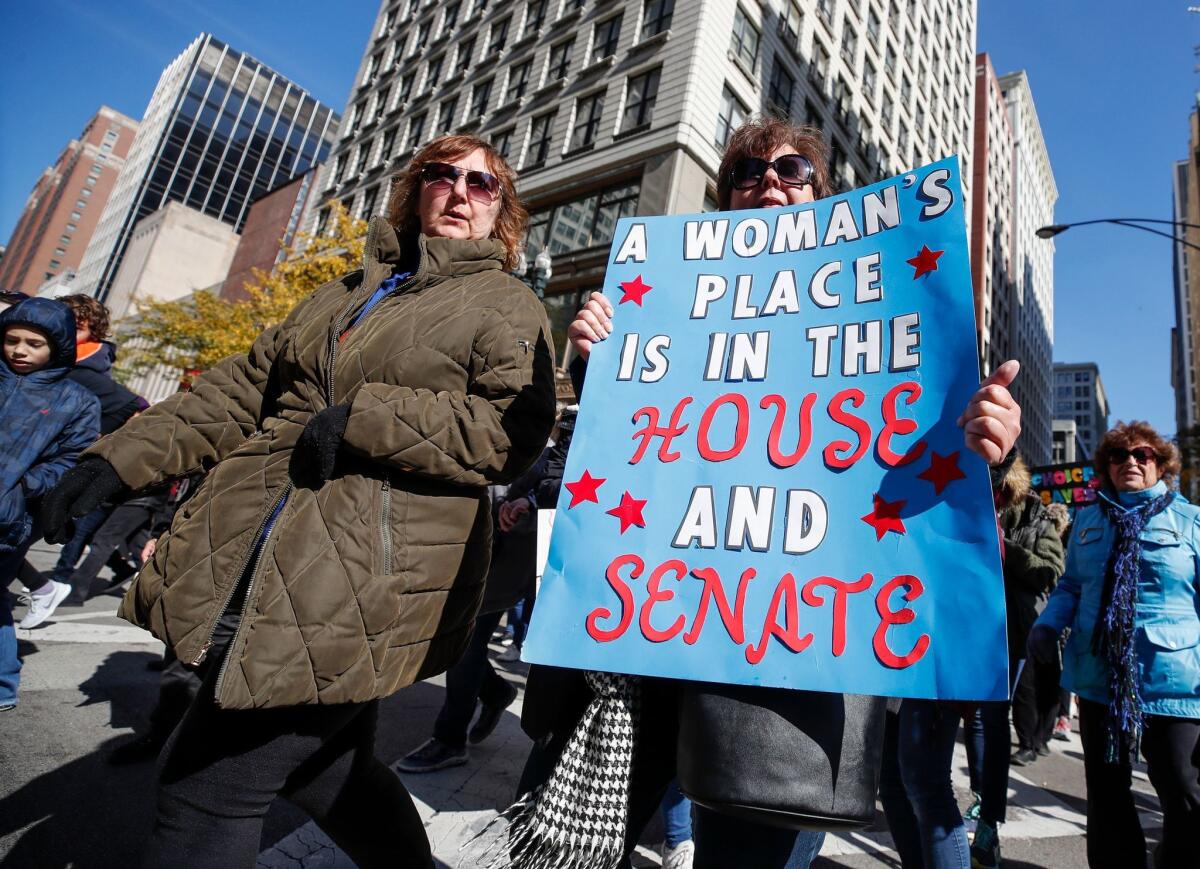
Pundits labeled 2018 the second “Year of the Woman,” a nod to the historic number of women that ran for office Tuesday. The first “Year of the Woman,” of course, was 1992, when Anita Hill was humiliated and ignored and five whole women were elected to the 100-person Senate. Twenty-six years later, the headlines are similarly rapturous. We elected more than 115 women, breaking a zillion records!
We owe these female candidates — and those who organized on their behalf — a debt of gratitude for expanding our vision, often at great personal risk.
But I’m not exactly running down the streets singing the “Star-Spangled Banner.” Since I simply cannot resist ruining a happy moment, dozens of women dotted across the country does not a revolution make. At press time, women had won 22% of the House seats, 12% of the Senate seats and 9% of the gubernatorial seats. We continue to make up 51% of the population.
The crumbs from your table are delicious. We gals are touched to have been allowed to eat them. Thank you, America!
Progress comes slowly, this we know. But this whole “women sweep Congress by gaining a proportionately tiny amount of power” narrative is suspect. Don’t try to placate us, bros. We’re coming for our rightful percentages. You are not safe.
- Share via
When it comes to elections, the new Orange County looks a lot like the old Orange County
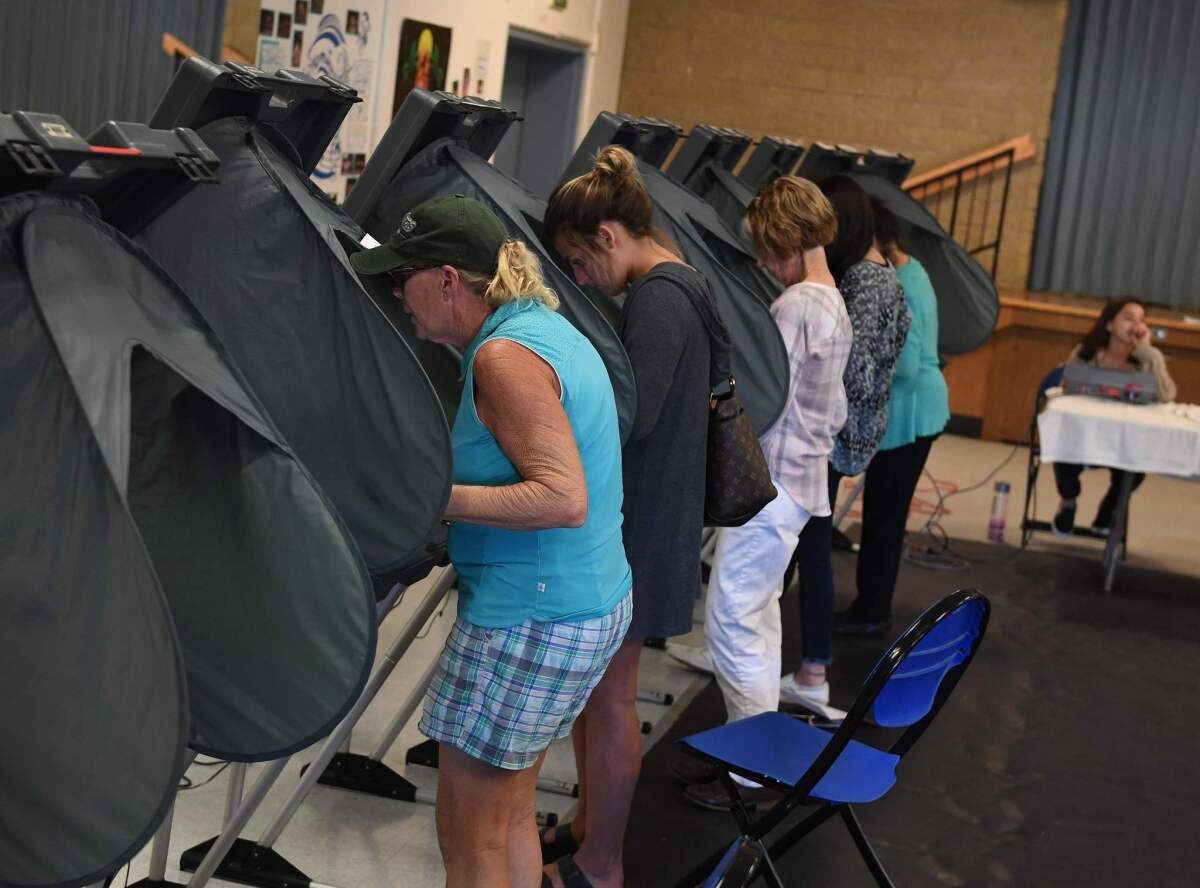
For all the recent talk about the demographic and political shifts underway in Orange County, Tuesday was a snap back to reality. Yes, Democrats have made strides, but Republicans still dominated election day.
While it looks like Rep. Dana Rohrabacher (R-Huntington Beach) may have lost his seat after three decades and a Democrat will replace Rep. Darrell Issa (R-Vista) in a district that spans Orange and San Diego counties, Republicans either held onto or won open seats that Democrats had hoped to take, including Mimi Walters (R-Laguna Beach) winning reelection and Young Kim taking the open seat currently held by Rep. Ed Royce (R-Fullerton).
And in statewide races, Orange County voters backed Republicans exclusively when they had the chance. John Cox carried the county in the governor’s race, 53.5% to 46.5% for Democrat (and now, Governor-elect) Gavin Newsom. The county also backed Republican Mark P. Meuser over statewide winner and Democratic incumbent Alex Padilla, 51.6% to 48.4%, in the race for secretary of state, and Republican and Anaheim businessman Konstantinos Roditis over incumbent Democrat Betty Yee for treasurer by a 50.7% to 49.3% vote.
The county has about 18,000 more registered Republicans than Democrats, and no-party preference is the third-largest group of registered voters. But those independent voters tend not to be all that independent, generally gravitating more toward one party than the other.
With Orange County’s history of conservative politics, it shouldn’t surprise that Republicans still held the edge on election day.
But it’s also inarguable that the county is changing, and relatively quickly. Non-Latino whites, who historically drove county-level politics, now account for about 42% of the population, down from 51.3% in the 2000 census. Much of the growth in diversity has come among the Asian and Latino communities.
And while the Democrats have maintained their proportion of the county electorate — registration since 1999 rose fewer than 2 points to 33.6% — the Republicans have been in a slow-motion collapse, dropping 14 points to 35.6% of registered voters.
Although the Republican Party backs the angry divisive politics of President Trump, it’s hard to see the president doing much to change the electoral fortunes of Orange County Republicans in the future. Democrats didn’t get what they wanted out of Orange County on Tuesday, but it seems like it might just be a matter of time — and continuing shifts in demographics — before they do.
- Share via
With the House in their pocket, Democrats need to ignore the Trump noise machine and get things done
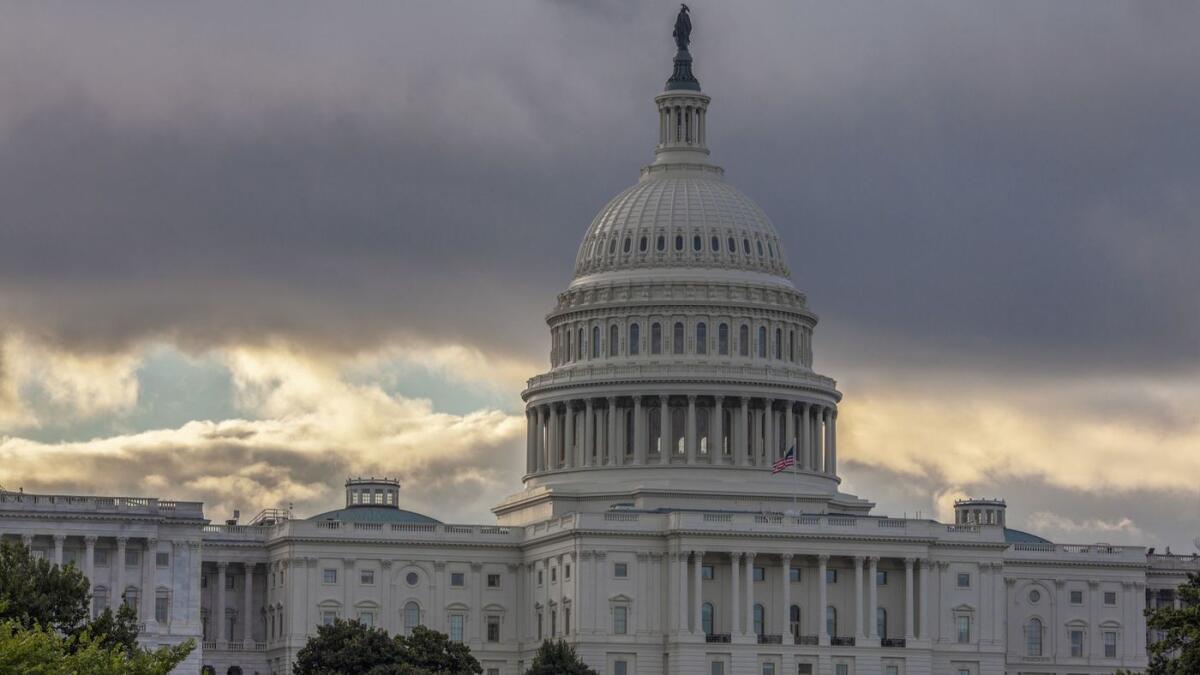
In the end Tuesday’s election results went about as expected, though not nearly as well for the Democrats as they had hoped. The took back control of the House, yes, but by a slim margin, and lost a couple more seats in the Senate. As waves go, well, it wasn’t exactly good for surfing.
So what now? The Democrats are in a position to effect change, but not necessarily in the manner they had hoped. With a split Congress, voters can expect little to get accomplished on significant issues. Immigration reform? Stalled. Repealing or adding tax cuts? Nothing doing. Changes to the Affordable Care Act? No prescriptions available.
So what can the House Democrats do now? Well, they can block whatever cockamamie ideas come out of the White House and President Trump’s acolytes across the aisle, but even with the GOP in control of Congress very little was getting done. In short, a dysfunctional Congress in which the nation’s business gets sidetracked by partisan intransigence will stay pretty much the same.
What the Democrats can do is hold hearings with some teeth, thanks to their newfound subpoena power. And if the Democrats decide to completely blow it — what are the odds? — they will embark on a whirling attack of investigations into all Trump transgressions, minor to major.
They shouldn’t. They need to separate dislike for inane White House policy positions from the true outrages and focus only on the things that matter. Rep. Adam Schiff (D-Burbank), if he becomes chairman of the House Intelligence Committee (which seems probable), can and should revive the committee’s investigation into Trump’s dealings with Russia, an investigation that under Rep. Devin Nunes (R-Tulare) was more of a coverup than a check on the executive branch.
Anticipating tougher congressional oversight, Trump took to Twitter Wednesday morning to preemptively threaten the Democrats.
The Democrats should shrug that off and call on the carpet top administration officials accused of misuse of tax dollars, hold oversight hearings on the dismantling of environmental regulations, and review the administration’s actions in immigration enforcement, from maintaining the world’s largest immigrant detention system (built under both parties) to apparent violations of migrants’ right to seek asylum at the border. And the Republicans should join them in reasserting the separation of powers and providing true oversight of the executive branch.
What the Democrats should not do, though, is use their new power to harass the White House, or to pursue petty grievances against the administration.
The Democrats have no more credibility with the nation than do the Republicans. In this era of team politics — approval/disapproval ratings are predetermined by party — most voters have a low opinion of Congress no matter who controls it. Years of showboating and stasis have soured Americans on the institution that is most supposed to be their voice in Washington.
And Tuesday’s results reinforced the reality that we are a deeply divided electorate. As a society, we’re in a dangerous place in which we can’t even agree on facts, let alone truth. We have split, or let ourselves be manipulated into divisions, based on race and gender, economic status, faith, and where we live. The rural-urban gap is remarkably wide, and seemingly unbridgeable.
This is where the Democrats can, if they don’t trip over themselves, try to pull the nation back together by not overplaying their House victory. They are in a position to begin the long slow climb to a better political discourse. That isn’t to say they should toss over principles. But they should recognize that they do not represent the entire nation, while they must govern as though they do. They should make their priority finding ways to work with Republicans to start actually governing,
This is their opportunity to be the adults in Washington. They should take it. Otherwise they will be complicit in the continuing death spiral of American democracy.
- Share via
Big Soda has big money riding on Trojan horse ballot measures in this election
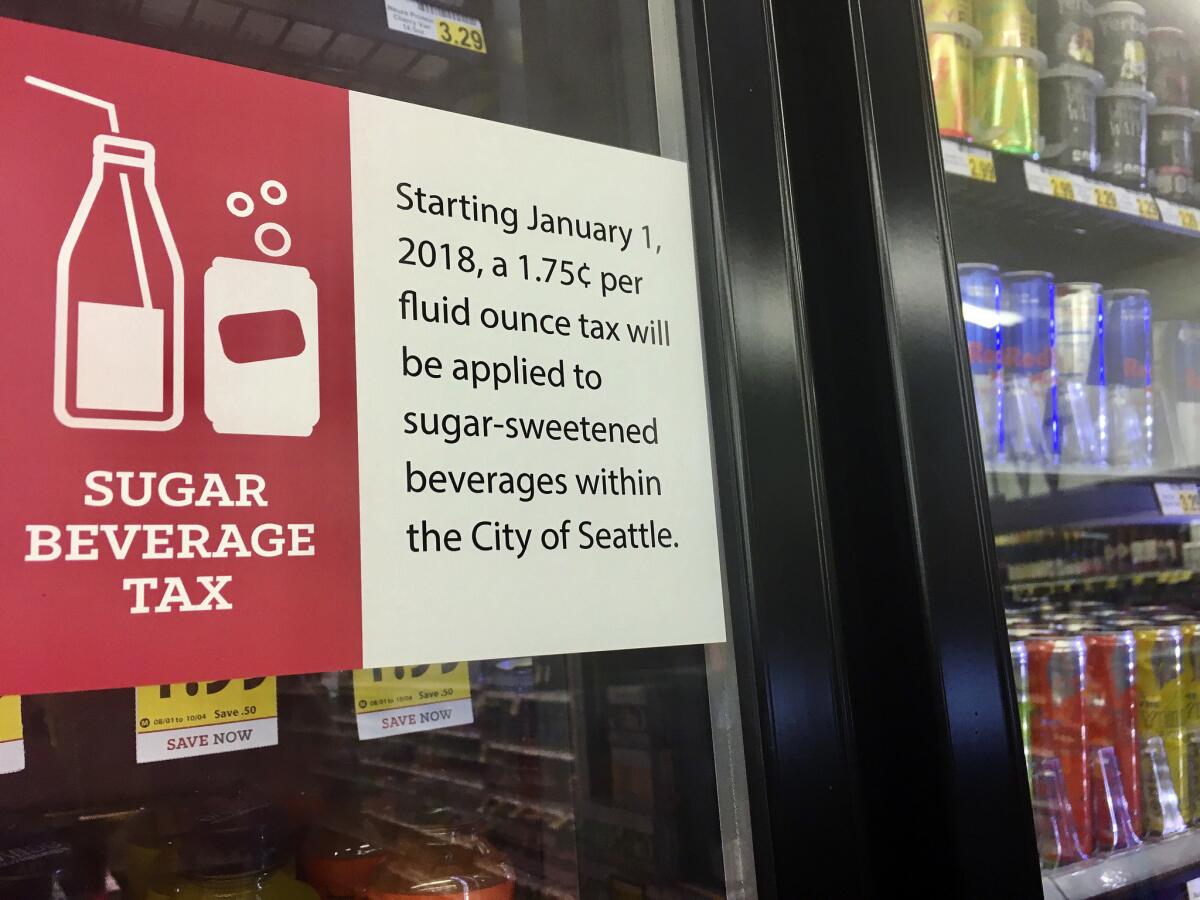
Voters in Oregon and Washington State will decide today whether they want to ban local soda taxes, such as the one that Seattle adopted in January.
Oh, some may not realize that’s what they are doing, given that the measures pretend to be about keeping greedy local governments from slapping taxes on food. But there’s a reason that soda companies have spent millions on these measures: the “groceries” that are protected from new taxes include sugary drinks like soda.
Local soda taxes have been bubbling up all over the country as studies trickle in from places like Berkeley indicating that soda taxes really do decrease soda consumption. That’s good for public health advocates hoping to curb the rising rates of obesity and diabetes.
But it’s bad for the bottom lines of Coca-Cola, PepsiCo and other makers of sugary beverages. So they’ve resorted to a time-tested tactic: urging state lawmakers to enact the sort of preemptive measures that Big Tobacco pioneered to protect itself against local anti-smoking laws. The plastics manufacturing industry has done the same in recent years, persuading legislatures in about a dozen states to ban plastic bag bans (though not in California, which has the nation’s only statewide plastic bag ban).
If the measures in Washington and Oregon pass, it will mean the entire West Coast will be a no-soda tax zone.
And Californians didn’t even get to vote on their ban. The California Legislature fell for another crafty beverage industry tactic earlier this year. Soda makers underwrote a ballot proposition that would have it made it harder for state and local government to raise a broad range of taxes. Once the measure qualified, Big Soda offered to remove it from the ballot — in exchange for a 12-year ban on local soda taxes. The Legislature caved, stunning public health groups that had been working on a number of local soda tax efforts.
If the voters in Oregon and Washington State give the soda industry victories, expect to see more soda tax preemption efforts in other states. And on other products and policies.
- Share via
You can’t just tell young people to go out and vote. You have to help them out

I spend a lot of time urging people to vote. But it occurred to me (on Monday) that I had never delivered that message to my niece, Elise Hall, who turned 18 in July. Was she even registered to vote?
Elise graduated from high school this past spring and now juggles a job and classes at a local college. I knew she was civic-minded; in high school, she volunteered her time and expertise doing hair and makeup for women in homeless shelters. But I had a feeling that voter registration might not have been on her to-do list.
Turns out that she had registered online — good for her! — or at least she tried to. She got back a form saying she still had to sign something. I looked her up on lavote.net and she wasn’t listed as registered. That didn’t surprise me. Maybe her name hadn’t made it into the system yet.
So I decided we should just go for it: Show up at the polls and see if they would let her vote — at least by provisional ballot. When she was 3, I had taken her trick-or-treating, along with her mother and brother, holding her hand as she climbed up stairs to houses, clutching her jack-o’-lantern bucket with her other hand. Now I wanted to take her voting. Hand-holding optional. She was game. She enlisted her lifelong friend, Sam Mizrahi-Powell, to come along.
When I showed up at her home in Palos Verdes Estates, it was sunny and breezy and the air was tinged with the smell of salt from the ocean. Good voting weather.
On the drive over to her polling place at a school district office, we talked of matters small and large. Elise had spent the entire weekend at a music festival in Long Beach, where every performer had told the audience to go vote. Yet she worried that “not everyone gets the opportunity to vote and use their voice.” She also struggled, as many voters do, with the feeling that she was a very small cog in a large machine. “I think my vote is important, but I am kind of discouraged that it won’t mean that much,” she said.
Gubernatorial candidate Gavin Newsom also came up in discussion. “He reminds me of a guy out of ‘Scandal,’” she mused. Come to think of it, he does look like a character on a soap opera.
Inside the tiny polling place, as we suspected, Elise was not on the rolls. But they offered her a provisional ballot and she took it into a booth. She knew how she wanted to vote (full disclosure: she went in armed with a list of L.A. Times endorsements), the only mystery being how to mark the foot-long ballot. I showed her how to slide it in the machine and anchor it down.
I stepped back and snapped a few pictures of her. “First election, huh?” a poll worker asked, chuckling. Good thing ballot selfies aren’t illegal in California, unlike 18 other states with irrational fears about voter fraud.
Sam, who is an intern at a movie production company, had already voted by mail. He was surprised by how long the voter pamphlet was. He had pored over it, reading the ballot analysis for both sides of every measure. “I wish we could have voted for certain parts of the propositions and not others,” he said. Don’t we all.
- Share via
Trump’s immigration court backlog has passed 1 million cases #WINNING
You have to give credit to the Trump administration when it’s due. The increased pace of arrests of people living in the country illegally, combined with the order to reopen suspended cases, has pushed the backlog of pending immigration court cases to nearly 1.1 million, according to the Transactional Records Access Clearinghouse at Syracuse University.
That’s more than double the backlog when Trump took office, and comes despite a 30% increase in the number of immigration judges.
No president in history has overseen such a huge buildup in cases. President Obama? The best he could do was 630,000 cases. Trump is so #WINNING when it comes to gumming up the immigration courts.
Oh, wait, that’s not a good thing.
Part of the increase stems from a hike in the number of deportation cases, which rose 49% to 768,257 during the fiscal year that ended Sept. 30.
But Atty. Gen. Jeff Sessions also ended the practice of suspending cases while the person facing deportation pursued other relief (such as an active application for a visa), which revived another 330,211 cases, bringing the total backlog to 1,098,468 cases.
With 395 judges on the immigration bench, that’s an average caseload of 2,781 cases per jurist.
Sessions also has adopted a quota system for the immigration courts, demanding each judge close at least 700 cases a year. At that pace, it would take the courts about four years to clear the backlog — but only if no new cases were added. At the current (slower) clearance rate, TRAC says, it would take the judges 5.1 years to work through the backlog, again if no new cases were added.
Never mind that speeding up case reviews increases the chances that due process rights will get compromised and that people will be deported despite having legitimate reasons to be allowed to stay, including credible fears that they might be persecuted or killed if returned to their home countries.
But when you think about it, this really is a remarkable achievement by Trump. He took a massively dysfunctional immigration system and made it worse.
Nobody’s ever seen anything like it. A lot of people are saying ...
- Share via
What kind of bipartisan cooperation can we expect after the election? How about none
President Trump has conducted the midterm election like a game of Wasteland Express Delivery Service, a post-apocalyptic vision of commerce in America.
In Wasteland Express, players buy and sell goods at various outposts to generate the profits they need to win. But once they sell something to any given outpost, they can’t go back with their next truckload of goods — the transaction was so acrimonious, the buyers won’t do business with them.
In recent weeks, the president has said things about individual Democrats and the Democratic Party in general that suggest he won’t be doing business with them next year. Take, for instance, these three tweets he made Saturday, then retweeted Tuesday morning:
“Raise your taxes” and “restore job-killing regulations” — totally fair. “Shut down your coal mines and timber mills” — hyperbolic, but at least there’s a grain of truth to the former. “Take away your healthcare, impose socialism and ERASE your borders” — that’s crazy talk, designed to make folks on the other side of the debate appear not just wrong, but evil. Ditto for what he says in this next tweet about Democratic Senate candidate Krysten Sinema in Arizona:
As bad as those tweets were, the next one may be worse. To boost embattled incumbent Joe Donnelly (D-Ind.), the Democratic Party in Indiana ran ads on Facebook attacking his Republican opponent, Mike Braun, a former Democrat, and promoting his Libertarian opponent, Lucy Brenton. This would have fallen into the dirty trick category had the ads not been clearly marked at the very top, “Sponsored • Paid for by the Indiana Democratic Party and authorized by Donnelly for Indiana.” So there was nothing secretive about the tactic; instead, it was a transparent attempt by Democrats to divide anti-tax conservatives. So what does Trump say about it?
Granted, saying Donnelly is trying to steal the election isn’t as bad as calling him a thief — the term Trump applied to the Democratic candidate for Florida’s governor, who happens to be African American. But Trump’s words lay the groundwork for Republicans to claim, if Donnelly wins, that his victory was illegitimate.
The tweets effectively capture the spirit of much of what the president has said at campaign rallies and impromptu press conferences in the weeks leading up to Tuesday’s vote. Trump has spent a certain amount of time touting the strong economy, low unemployment and rising wages. But the positive notes have been overshadowed by his appeals to the fears and suspicions of his base. Democrats aren’t merely a lousy alternative, Trump has been arguing; they’re ruin, corruption and chaos.
Voters have gotten incredibly worked up about this election, largely because of Trump. And those emotions have driven an incredible turnout, which is healthy and welcome.
But this country has to be governable after the election. Trump and congressional Democrats will have to work together, regardless of who controls the House and the Senate. Even if they’re in the minority, Senate Democrats will still have the power to frustrate Trump’s agenda.
In Wasteland Express, players mark the outposts they’ve tainted with a big red X. President Trump has left a lot of big red X’s across the political landscape.
- Share via
D.C. pols are too polarized to fight climate change. But Washington state voters might be up to it
With Washington, D.C., unlikely to act on climate change any time soon, voters in Washington state Tuesday are deciding whether to impose the nation’s first carbon tax.
Initiative 1631 would charge a “fee” (basically a tax) on large emitters of greenhouse gases, such as oil companies and electric utilities. The money raised from the fee would be used to develop renewable energy, electric vehicle infrastructure, energy efficiency programs and other projects designed to reduce carbon emissions. The state could eventually raise $1 billion a year by 2025 — money that could help transform the state’s infrastructure and economy.
This is the second time voters in Washington have considered a carbon tax. Voter rejected a 2016 initiative that would have levied a higher carbon tax on fossil fuels but refunded all the revenue through tax cuts and rebates.
It’s a big deal that Washington voters are even considering a carbon-pricing scheme again. Carbon taxes are often floated by both environmentalists and centrist Republicans as the ideal policy tool to slash greenhouse gas emissions and slow climate change. Putting a price on emissions makes it more expensive to burn fossil fuels, and that pushes manufacturers and consumers toward cleaner and, eventually, cheaper forms of energy.
There’s been a lot of talk but, so far, little action on carbon taxes in the U.S.
California is the outlier, having enacted a cap-and-trade system in which companies can install pollution-cutting equipment to meet carbon emissions limits or buy permits to exceed them. It’s not a carbon tax, but it has the same goal of prodding companies to cut greenhouse gas emissions.
More important, California’s experience has demonstrated that a state can adopt aggressive climate change regulations and still have a thriving economy. If voters approve Initiative 1631, the hope is that Washington, too, can become a proving ground for carbon taxes.
There is, of course, lots of skepticism in Washington. Oil industry groups argued that state-level action would have a negligible impact on global warming. The Seattle Times opposed the carbon tax, arguing that climate change warranted a “coordinated” response with other states, or a national carbon tax.
Yes, it would be better if the United States imposed a national carbon tax, or at least had a strategy to cut greenhouse gas emissions. That’s not going to happen under climate change denier President Trump, and the situation is too dire to wait.
Already the world is warming faster than previously believed. The recent Intergovernmental Panel of Climate Change warned that if greenhouse gas emissions continue unabated, the atmosphere will climb to 2.7 degrees Fahrenheit above pre-industrial levels by 2040, adding to rising seas and propelling more severe storms, wildfires, food shortages, heat waves, droughts and floods.
If the federal government won’t do it, states have to lead the effort to slow climate change. California is doing it. Washington can too.
- Share via
How long after the polls close until heads roll in the Trump administration?
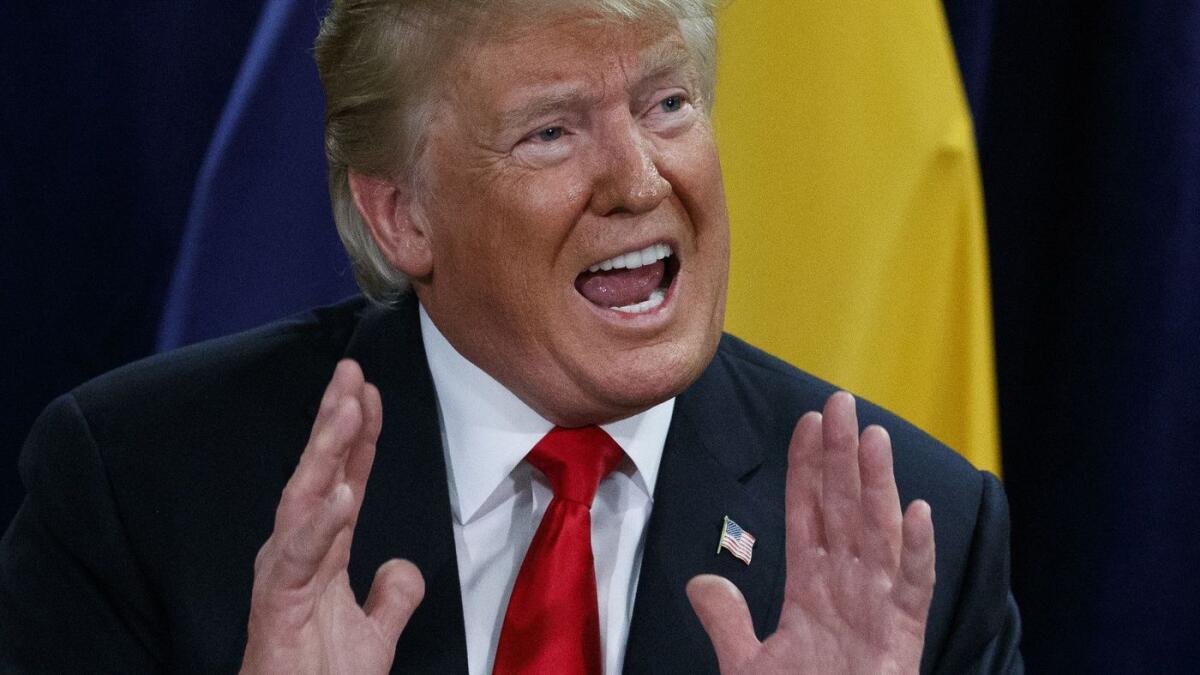
I tend not to make too many predictions about elections because it’s too easy to be wrong, too hard to be right, and in the end it doesn’t matter because the elections will turn out the way they’ll turn out (give or take a Russian thumb or two on the scale).
So let’s move to the second-most interesting thing tied to the election: who President Trump will fire, and when.
My guess is that several heads will roll, and roll soon. The news coverage of the fight for control of Congress will push Trump out of the news cycle, and nothing irks the president more than not being the center of attention. To paraphrase Alice Roosevelt Longworth’s jibe about her father, Teddy Roosevelt, Trump wants to be the corpse at every funeral, the bride at every wedding and the baby at every christening.
And a good way to turn the spotlight back on himself is to dust off “The Apprentice” playbook and start firing people.
The first to go? Probably Interior Secretary Ryan Zinke, who has been wracked by ethics investigations.
And then my money would be on Atty. Gen. Jeff Sessions, a frequent Trump punching bag, and possibly his deputy, Rod Rosenstein, who has been overseeing special counsel Robert S. Mueller III’s investigation into possible connections between Trump’s 2016 campaign and Russian meddlers, among other things.
Removing thorn-in-the-side Rosenstein would set the stage for Solicitor General Noel Francisco to handle oversight of Mueller whether Sessions stays or goes, since Sessions, who advised the Trump campaign, recused himself. And then if Francisco fires Mueller, well, that would certainly make Trump the center of attention again (though if the Democrats take the House, firing Mueller could well launch impeachment proceedings).
And let’s not forget Kirstjen Nielsen, the Homeland Security secretary Trump has berated over border enforcement. Even though illegal border crossings are way down, Trump has inflated the issue into a fake crisis to try to gin up votes in the midterms. But just because it’s fake doesn’t mean the president doesn’t think there is a crisis, and Nielsen tops the list of potential scapegoats. If Nielsen gets the ax, John Kelly — Trump’s chief of staff and a vocal Nielsen defender — may leave too.
Wilbur Ross at Commerce could be on thin ice as well, given his ethics troubles, though firing a fellow 1%er who lied about his wealth might be painful for the president.
James Mattis may leave his Defense post, too, though the sense out of Washington is that his departure would be his decision, not Trump’s.
Presidents often wait until after midterms to shuffle around the people in the top chairs, but this particular chief executive has been rearranging his Cabinet like it’s his hobby. So grab the popcorn and start the office pools.
- Share via
For all the hype about high turnout, it will be a near miracle if half of eligible Americans vote
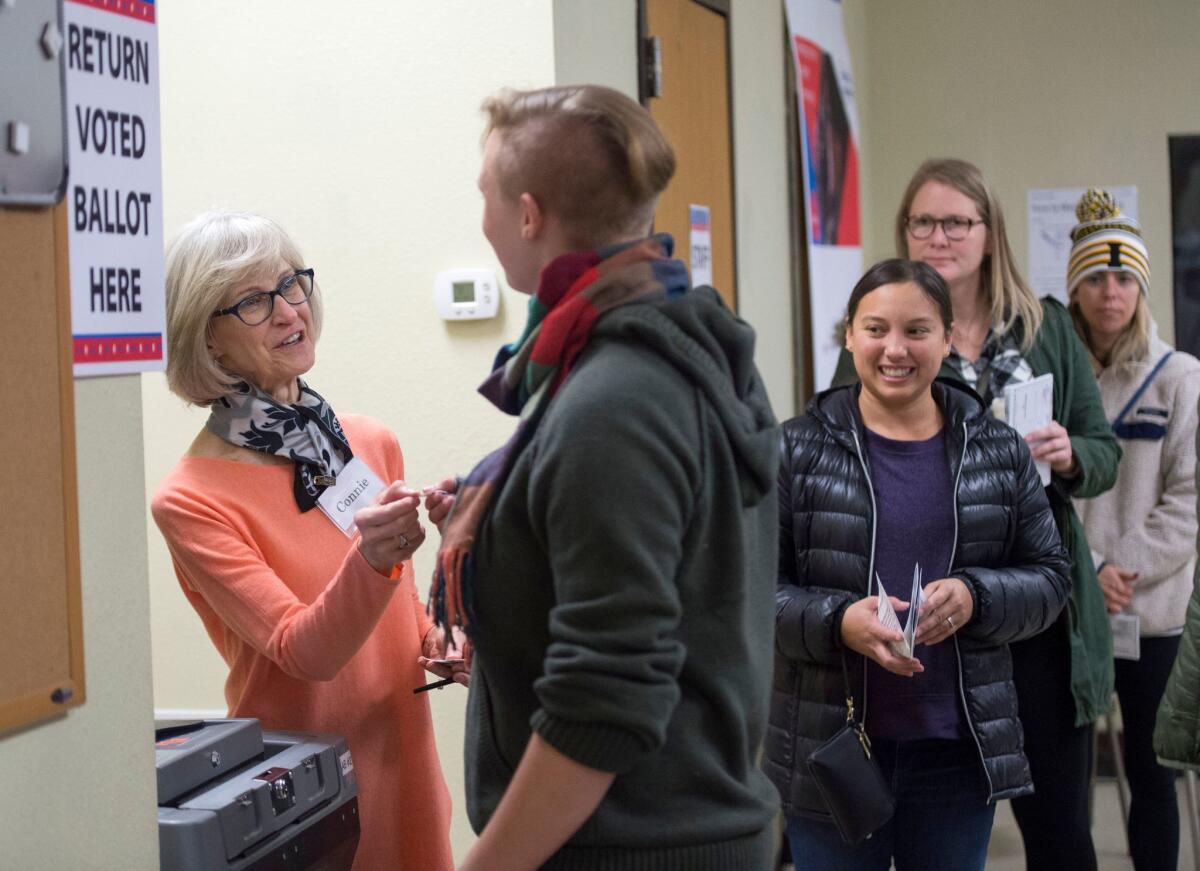
As I got out of the YMCA pool early Monday morning, the lifeguard — a young man most likely still in college — said he was still bothered by Sunday’s shift from daylight saving time to standard time. So, I asked, you’ll be voting for Proposition 7 tomorrow?
Evidently, this was the first time anyone had mentioned that proposition to him. From the look on his face, I wondered if he realized that Tuesday was election day.
Regardless, after I told him that the measure would let the Legislature vote to end the time changes and put us on daylight saving time permanently, with Congress’ approval, he had the zeal of the converted. As I dripped my way to the locker room, I heard him calling out to other swimmers getting out of their lanes, “Vote yes on Prop. 7! Vote yes on Prop. 7!”
There’s been a torrent of stories about how high the turnout in this year’s midterms will be. And much of the energy clearly is being driven by strong feelings about President Trump, who’s not actually on the ballot but has sought to make the midterms a referendum on him.
But there are plenty of voting-age Americans who aren’t motivated by the national political scrum. They may not see themselves having any stake in that fight, or they may be turned off by it. That’s one reason so many of those folks don’t bother to vote, particularly not in midterms, for which it would be a near miracle if half of those eligible to cast ballots actually did so.
What’s worse, in this West Coast hub of direct democracy, there will always be at least one thing on the ballot that should resonate with even the most disaffected or disinterested voter. Maybe it’s Proposition 7, which would strike a mostly symbolic blow against the scourge of semiannual time shifts. Maybe it’s Proposition 12, which would require more humane treatment of egg-laying hens and other animals raised to produce food. Or perhaps it’s Proposition 1, which would provide more state dollars for affordable housing.
So why is there a disconnect between Californians like my lifeguard and the ballot measures that they might care about enough to go vote? Part of the explanation, no doubt, is the campaign-ad carpet bombing done by candidates and special interests. It’s hard for proponents of smaller measures to be heard this year above the noise being generated by the fights over the gas-tax-increase repeal (Proposition 6), rent control (Proposition 10) and revenue caps on dialysis clinics (Proposition 8).
Overcoming the awareness gap, though, might take more money than proponents of a measure such as Proposition 7 could raise. That particular initiative was put on the ballot by the Legislature and seems to have no active campaign behind it — the California secretary of state’s office reports no money having been raised or spent on Proposition 7, pro or con. By way of comparison, backers of Proposition 1 have contributed $7 million and supporters of Proposition 12 $18 million; the two sides on Proposition 10 have contributed $102 million, and the dueling factions on Proposition 8 have kicked in $132 million.
That’s why the answer probably isn’t going to come from the campaigns. If we are really serious about raising turnout among voting-age Americans to the level seen in most other industrialized nations, it will be up to those of us who are paying attention to spread the word about what’s being decided by those who bother to vote. It’s a long ballot seemingly every year — there will be something for everyone.
- Share via
Jeff Sessions may be Trump’s punching bag, but he’s in lock step with the president on immigration
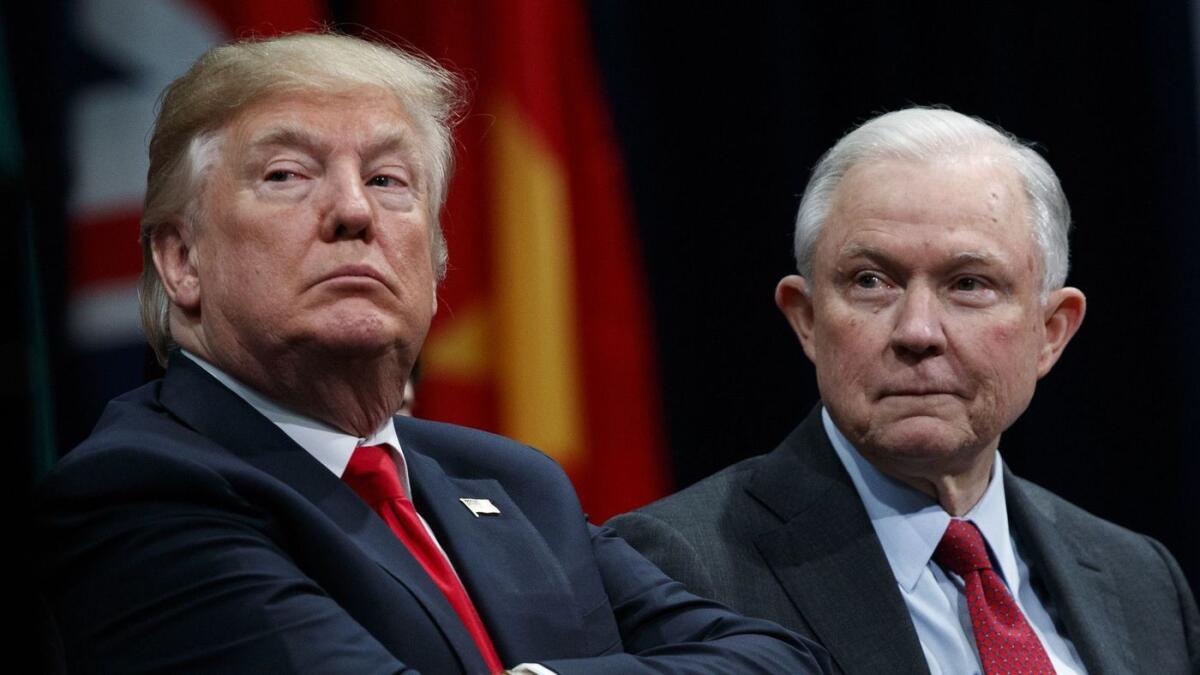
One of the more overlooked aspects of President Trump’s attacks on the government he was elected to run is the slow and steady reshaping of immigration courts by Atty.Gen. Jeff Sessions. That also points up one of many anomalies of this administration: Sessions has found himself in the odd position of being Trump’s punching bag for recusing himself from the Mueller probe, while simultaneously doing exactly what Trump wants in making it harder for people to fight deportation or seek asylum.
Trying to force more people out of the country plays directly into Trump’s anti-illegal-immigration campaign, including his fake caravan crisis at the southern border. But it also reflects Sessions’ long-held opposition to immigration of all stripes. As a member of the Senate, he was one of the sturdiest roadblocks to enacting comprehensive immigration reform while seeking to reduce legal immigration.
And he’s in a position to do more than he could as a single senator because the immigration courts now work for him; they are not part of the judicial branch, like federal district courts or the courts of appeal. Rather, they exist within the Justice Department as an administrative system, and all the judges — both hearing judges and those on the Board of Immigration Appeals — work for the attorney general, who has the authority to overrule decisions by the appeals panel. Sessions has done so more often than other recent attorneys general, and generally has ruled against the immigrants involved in the cases.
Sessions’ decisions have focused on overturning precedents he doesn’t like, and tend to constrain judicial flexibility and autonomy.
In one case he reversed an Obama-era decision that women facing domestic abuse in cultures in which law enforcement won’t protect them can receive asylum.
He also has stopped the practice of administrative closures, which judges were using often to suspend a deportation while the person involved sought a visa or other remedy. As a consequence, now people could be deported before they finish that process. And that will just add to the backlog of pending cases.
The one good thing Sessions has done: He has hired more immigration judges, increasing the number from 289 as of the end of September 2016 to 397, with even more planned. That is the best way to address the massive backlog that has built up over the years — increase the capacity of the system to handle cases — as long as those judges pay the proper respect to due process and the migrants’ rights.
How big is the backlog? Two years ago, it stood at 516,000 cases that had been pending an average of 672 days; now it stands at 765,000 cases that have been pending an average of 717 days.
Part of the growth stems from the administration’s stepped-up pace of arrests and detentions. So in an effort to speed up the handling of cases, Sessions established a quota and performance system for immigration judges, increasing the likelihood that rights will get trampled as judges struggle to keep up with the demands of a legal assembly line. He also has criticized immigration attorneys for doing their jobs — helping protect the legal rights and interests of people facing deportation.
The American Bar Assn. warned that the new approach will likely backfire. The attorney general is the top decision-maker within the immigration court framework, but even his decisions can be appealed in federal court, especially if there is a claim that rights have been violated. And a hurried-up immigration court process is likely to run afoul of due process protections.
Last month, Sessions took the first steps in further consolidating his power by proposing a rule that would allow the attorney general to intervene in a case before it reached the immigration appeals court, essentially circumventing decades of practice and undercutting what little independence the immigration courts have. Of course, it’s a betting proposition whether Sessions will survive long enough in his current job to exercise that power.
From a policy and good-governance standpoint, Sessions has been awful for the immigration courts. If the administration dislikes immigration law and how it is supposed to be enforced, then it should work with Congress to adjust the laws, not resort to this behind-curtains consolidation of authority.
The best solution here would be to make the immigration courts independent. Justice is not served when immigration judges work for an executive branch that seeks to deport people who may have a legal right to remain. That makes the process too easily politicized, as we’ve seen over the past few months.
- Share via
The midterms aren’t just a referendum on Trump. They’re a measure of how many lies Americans will swallow
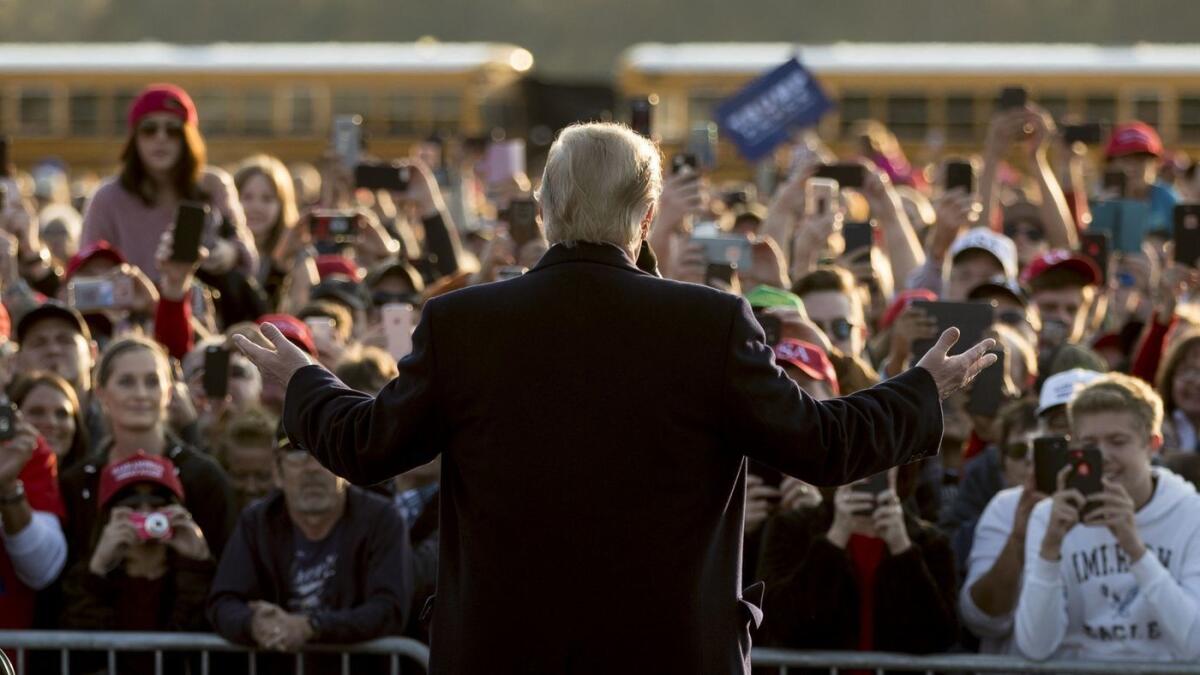
One of the more depressing aspects of President Trump’s flood of lies about the immigration system and immigrants themselves is that so many of his supporters are willing to believe what’s patently untrue.
The president was back at it Thursday, speaking from the Roosevelt Room in the White House, when he ranted against illegal immigration — it is a problem, but much less so than in the past — and characterized the northbound dwindling caravan in southern Mexico as full of “tough people” — the migrants pushed through Mexican police seeking to stop them — and obliquely suggested they included rapists, a persistent theme with Trump.
Here are a few places where fact-checkers tried to catch the lies in the speech, so I won’t rehash them. But it was undeniably laden with flat-out falsehoods, including blaming illegal immigration on “Democrat” laws and claiming that 97% of migrants released from custody disappear into the country: “By the time their trial comes, they’re gone, nobody knows where they are.”
An outright lie. The vast majority of released migrants show up for court dates.
The president repeatedly says at rallies for Republican candidates that Tuesday’s election is a referendum on him, and in many ways it is. All the House seats are on the ballot, and many of them are occupied by people who have failed in their constitutional mandate to serve as a check and balance on the president. So to vote for those candidates is to vote for the president.
But the election is more about the American people, and Trump supporters who either believe the lies or don’t care because they, too, fear or hate migrants.
And yes, our immigration system is broken. Congress — regardless of who has controlled it — has failed to fix it. It’s as though both parties want it to remain broken. The Democrats use it to rally support among its progressive, pro-immigrant base, while Republicans follow the Willie Horton example and use migrants here illegally — who commit crimes less frequently than native-born Americans — as a bogeyman to run against.
Thus, Trump has manufactured a crisis out of a couple of thousand people heading to the border to seek asylum. He says they must present themselves at border crossings to seek asylum, but the law says otherwise, and legal challenges will keep him from adopting that policy — but not until after the election. So he trots out a chimera of a policy to appear as though he’s acting forcefully to address a crisis that doesn’t exist.
Trump also is deploying active-duty military personnel to the border and, according to his Thursday statement, instructed the troops to treat thrown rocks as though someone had fired a rifle at them. The commander in chief didn’t specify what their response should be, but the implication is clear: Return fire.
This is pure demagoguery, a statement meant to portray the migrants as an invasion force to stoke fear among those susceptible to it. At the same time, the president has been relatively silent in the election lead-up on the real pressing issues for the nation, including his increasing destabilization of the world, his blatant disregard for the environment and the dangers of global warming, gun violence, divisive political rhetoric (which he exploits), and a massive federal deficit exacerbated by his tax cuts, leaving the economy little wriggle room when the inevitable recession arrives.
But the migrants!
So the question for voters is, do you accept this? Do you let our P.T. Barnum of a president dazzle you with lies? Do you reelect the people who should be calling him on this, but who instead aid and abet it? Do you let the current status continue down the path to more divisiveness, more violence — both physical and verbal — among us, to further erode the nation’s standing in the world?
Or do you stand up to this slide into authoritarianism and try to make America sane again?
- Share via
If elections are all about ‘the economy, stupid,’ the blue wave is in trouble
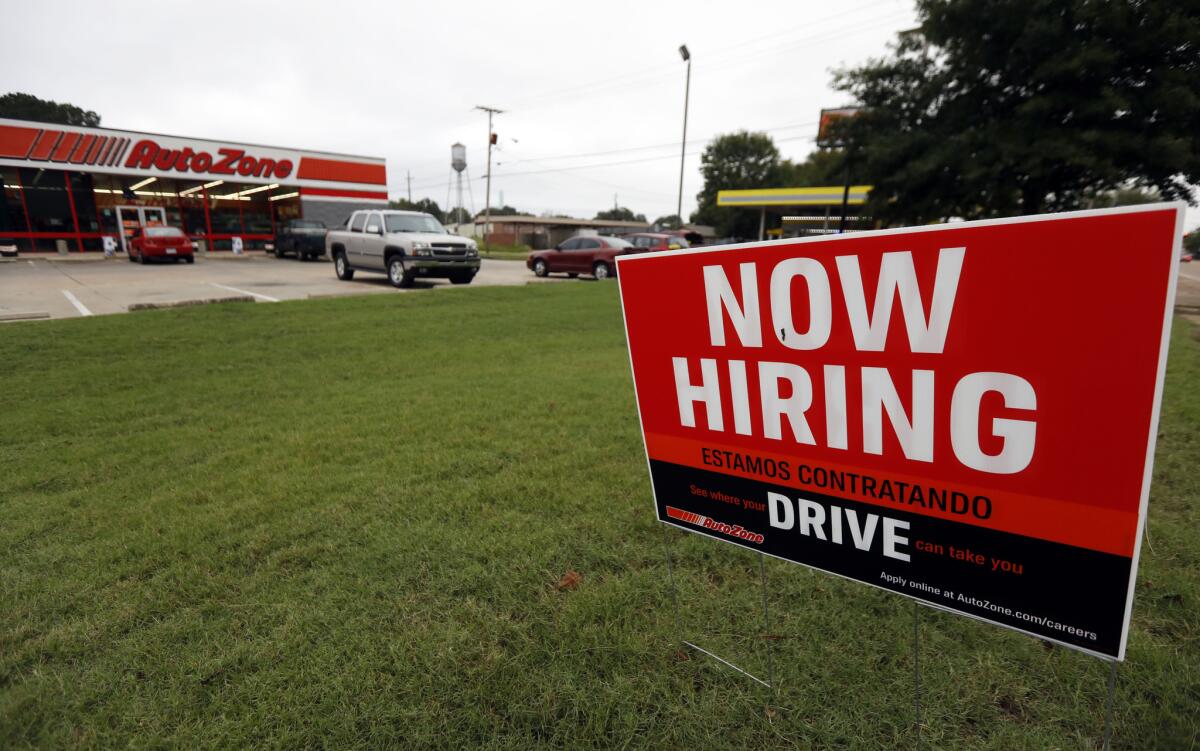
Nine of the last 13 U.S. elections have been “change” or “wave” elections, as voters threw out the party in charge of the White House, the House of Representatives or the Senate in search of a new direction in Washington.
The phenomenon has been especially pronounced in midterm elections, which flipped control of the House on three occasions since 1994 and the Senate three times since 2002.
Notably, however, none of those turnabouts came when the economy was performing as well as it is now. Friday’s strong jobs report, coming on the heels of last week’s encouraging advance estimate of third-quarter GDP, shows that the U.S. economy remains in something of a Goldilocks zone — not too hot, not too cold.
To break it down a bit, we’re seeing so much demand for labor that wages are increasing faster (for the first time since the last recession ended, average hourly wages were more than 3% higher than the year before) and more people joining or rejoining the workforce. Job growth was broad too, showing up in a wide range of industries.
Good times! But how will that show up in the election results? When James Carville advised Bill Clinton that the key to defeating President George H.W. Bush in 1992 was “the economy, stupid,” the United States was rebounding from a downturn in the middle of Bush’s first and only term. Economic discontent is a powerful motivator; will people stream to the polls when they feel good about the way things are going?
The question is important because, according to national polls, Americans really do feel good about their situation and their prospects. The Conference Board reported this week that its surveys found, in addition to the highest level of consumer confidence since the dot-com boom, an extremely high level of satisfaction with the current situation and plenty of optimism about the near-term future.
Those feelings aren’t universal; the rising tide has lifted some boats higher than others. And there certainly are dark clouds on the horizon, thanks to the intensifying trade war President Trump is waging with China, slowly rising interest rates, a volatile stock market, creeping inflation and the looming sanctions on Iran that could cause oil prices to surge again. Analysts say the next round of tariffs on Chinese goods will be felt much more directly by the average American because, for the first time, the levies will fall heavily on consumer products (e.g., athletic shoes and smartphones).
Nevertheless, the latest economic reports suggest that those threats aren’t yet moving the needle. The engine appears to be firing on all cylinders.
That’s probably why Democrats aren’t saying much about the economy, other than arguing that the big GOP tax cuts passed in 2017 help corporations and the wealthy more than the average American. Instead, they’re talking about things voters are worried about, most notably healthcare. And while many candidates are sticking to local issues, they’re counting on the visceral dislike for Trump among Democrats and some independent voters to help build a “blue wave.”
For his part, Trump has talked about the improving economy almost since the day he took office. As he’s campaigned for Republicans in the midterms, he’s asserted that putting Democrats in power would end the party in a hurry — they’d raise taxes, reimpose regulations and replace all American workers with cheaper Honduran immigrants. Or something like that.
That’s playing to people’s fears, which works only if the fears are credible. And it’s really hard to get people scared about the economy when it has been improving slowly but steadily for a decade, and things are going as well as they are today. Even Trump is hedging his bets by making other fear-based pitches — for example, migrant caravans, anchor babies and violent criminals who entered the country illegally.
Anyway, the economy is certainly good enough to quell voters’ eagerness for change. We’ll see next week if that translates into a strong turnout to preserve the status quo.
- Share via
Gun suicides far outpace gun homicides. Here’s why that statistic matters

About two-thirds of gun deaths in the U.S. each year are suicides, traumatic and desperate acts that often lie at the nexus of mental illness and ready access to a firearm. Yet a new study published in the Annals of Internal Medicine finds that only 13% of people know that gun suicides far outpace homicides, a likely function of regular news coverage of violent crimes and a tendency to not cover suicides.
Why does that matter?
As the study’s authors point out, people who buy firearms for self-protection from criminal attacks or home invasions — even though firearms offer more reassurance than actual protection — may not be aware of the other related risks.
“This research indicates that in the scope of violent death, the majority of U.S. adults don’t know how people are dying,” said Erin Morgan, the lead author and an epidemiology graduate student at the University of Washington School of Public Health. “Knowing that the presence of a firearm increases the risk for suicide, and that firearm suicide is substantially more common than firearm homicide, may lead people to think twice about whether or not firearm ownership and their storage practices are really the safest options for them and their household.”
Statistics on suicides and gun access are sobering. Since 1999, suicide rates have increased in every state except Nevada, and the rates have jumped by at least 30% in more than half of the states, according to the Centers for Disease Control and Prevention. Most suicides were by people without known mental illnesses at the time, and 55% of those deaths involved firearms.
So thousands of people with access to guns who hadn’t exhibited notable mental illness shot themselves to death.
Notably, among all suicides, only 22% involved people with underlying health issues, while 42% of those committing suicide had relationship problems, 29% had just experienced or knew of a pending personal crisis, and 28% had substance abuse problems. Suicide often, as experts warn, is an impulsive act, and having a lethal weapon at hand makes that impulse more likely to be deadly.
Other studies have found that state-level nonfirearm suicide rates are similar across the country, but the level of firearm suicides is higher in states with high levels of gun ownership. And firearms are much deadlier than other methods used by those attempting to kill themselves — about 93% of gun attempts result in death, according to CDC data, though it warns that it’s nonfatal injury data isn’t as rock-solid as one would like. But only a sliver of people who poisoned themselves in 2016 died — 6,698 deaths in 266,175 attempts, according to CDC data. Even those who sought to suffocate themselves (often by hanging) survived more than twice as often as those who used a gun — 4,091 survived and were treated at hospitals, while 22,642 died.
So the presence of a firearm in the home increases the chance that someone will kill himself — middle-aged white men are most prone — with a weapon often bought for self- protection.
That seems worth talking about.
- Share via
No shady super PACs or dog whistles required. Trump owns his Willie Horton moment
Trying to amp up the spooky Halloween vibe he’s projected onto the midterm elections, President Trump went to Twitter on Wednesday to introduce a new boogeyman: Luis Bracamontes, a convicted cop-killer now on California’s death row.
The tweet — still pinned to the top of Trump’s Twitter feed — has drawn criticism galore from the media and Democrats. But I’m not going to pick apart what it says; instead, I’m struck by how many people are outraged that Trump should be saying (err, tweeting) such things himself.
Here is a comprehensive comparison between Trump’s ad and the infamous Willie Horton ad that supported then-Vice President George H.W. Bush’s campaign against Michael Dukakis in 1988, which Bush’s campaign manager arranged but then denied any involvement in:
The implication is that it’s much, much worse for the president to engage in this kind of low-blow scaremongering out in the open, rather than doing it through proxies. To the contrary, we’re better off when politicians take ownership of everything done in their name — especially when it’s as scummy as this ad is. There’s no question about accountability here.
Trump doesn’t just employ a team of Lee Atwaters. He is Lee Atwater, minus whatever conscience Atwater developed later in life.
Think of it this way. On Saturday, an anti-Semitic gunman — apparently obsessed with the caravan that Trump has been hyping, and fueled by a crazy notion that refugee-friendly Jews were bringing people into the country who would commit genocide on white Americans — shot up a synagogue in Pittsburgh, killing 11 elderly worshipers. Four days later, Trump pushed an ad out to his 55.5 million followers stating that Democrats were inviting killers into this country, touting the caravan and asking who Democrats would bring into the country next.
Trump has made no secret about seizing on immigration and border security in his effort to help embattled Republicans in the midterms. He is doing it openly, as president. It’s the kind of transparency we want from politicians, right? Too bad it’s put to such horrible use.
- Share via
20 years after his murder, Matthew Shepard is still under attack
Last week, Matthew Shepard’s parents, Judy and Dennis, sat for a television interview. Their son, of course, had been beaten, pistol-whipped, tied to a fence post, and left to die near Laramie, Wyo., in 1998. Now, 20 years later, his ashes were being interred at the Washington National Cathedral.
In the television interview, the news anchor proceeded, in the tradition of many before her, to gently yet obviously try to make Matthew Shepard’s parents cry on camera.
The exchange went something like this: She asked them if they were moved. They were. She listed others who’d been buried there — Woodrow Wilson and Helen Keller, for instance. She asked them how they felt. They were honored. She was not getting what she wanted. They were not crying. The church, she told them, held Matthew Shepard in that level of esteem. He changed the world, she said. That must make them feel some kind of way. “To us, he was just Matthew,” his mother said. His mother was sad, had likely been sad for 20 years, but did not cave.
- Share via
Happy Halloween! Here’s a knife-wielding man in bandages and hospital scrubs wandering L.A.’s freeways
Well, here’s something for you from the nightmare factory, courtesy of the Instagram account of L.A. motorist Lisa Shields.
An obvious prank, pulled off by a fame-thirsty Logan Paul wannabe, you say?
Nope.
A spokesperson from the West Los Angeles branch of the California Highway Patrol says that “this was not a prank.” CHP responded to the incident in question Monday, and the knife-wielding man and his bandages were taken to a local hospital and put on a 72-hour mental health hold.
It remains unclear who this man is and how he wound up armed in hospital scrubs on the freeway. It’s probably worth noting that Los Angeles is facing a homelessness epidemic, of which severe mental illness is a leading contributor.
- Share via
The world isn’t even getting the easy fixes to combat climate change done
Last spring the International Maritime Organization, a United Nations body overseeing global shipping, came to a significant agreement: Its signatories would reduce greenhouse gas emissions from international shipping 50% by 2050, in keeping with the spirit of the 2015 Paris agreement. As The Times editorial board noted then, the devil would be in the details, which were to be hammered out at meeting in October.
Well, the meeting came and went, and so did hope that an industry that produces carbon missions on a par with the entire country of Germany would work quickly to reduce its carbon footprint. Rather than setting hard goals and ways to get there, the IMO adjourned the meeting without doing anything of note until the body meets again next year.
The timing of this comes with some irony: Scientists reported Wednesday that the oceans — plied by those carbon-spewing freighters — are warming faster than previously thought, which means the world is further along the path of global warning than was previously understood, reinforcing a conclusion reached earlier this month by the Intergovernmental Panel on Climate Change.
The reality is that the modern global economy — and many of the means by which humans travel, ship goods and maintain habitable housing (heated in the winter, cooled in the summer) — is turning the Earth into a hot box. The global temperature has risen 1 degree Celsius (roughly 1.7 degrees Fahrenheit) since the start of the industrial era, and as it continues to increase, more glaciers and polar ice sheets will melt, leading the oceans to swamp coastal areas and inundate low-lying islands, while weather patterns will continue to shift and the power and intensity of storms and droughts will increase.
The world needs radical and immediate action to confront this looming calamity, and we can’t get even the easy fixes done. For instance, the Clean Shipping Coalition, an advocacy group, argues that the IMO could have ordered a speed limit on freighters that would have made a significant immediate impact on emissions.
“As ship speed increases, the water resistance increases, not proportionally but exponentially,” said Bill Hemmings, aviation and shipping director for the Brussels-based organization Transport and Environment, which belongs to the Clean Shipping Coalition and advocates for sustainable transportation. “So increasing speed by 10% might increase resistance and thus the power needed to push through the water by 30% or more.”
Conversely, a 10% decrease could reduce carbon emissions by nearly 30%. Shippers like the higher speeds because time means money, and regulated speed limits can reduce flexibility in maintaining fleets and schedules. Those are understandable concerns, but if the world is to combat global warming, it needs to stop focusing on the short term and start making decisions based on the outcome the world needs: radically reduced emissions as quickly possible.
Meanwhile, the Trump administration continues on with its disastrous policies to increase the production and consumption of fossil fuels, putting the short-term financial interests of the gas and oil industry ahead of the world’s ability to sustain human life. Food insecurity, which had been dropping for a decade, increased last year, according to the World Food Program. The future looks even bleaker, with climate change already affecting weather patterns that have increased food insecurity in sub-Saharan Africa, helping propel a wave of human migration.
And some of the Central Americans traveling in the so-called caravan through Mexico are fleeing not just violence, but also poverty and starvation as agricultural areas in Honduras have been decimated by a prolonged drought — a condition believed to be exacerbated by global warming.
And the world can’t even set a speed limit on ships.
- Share via
Don’t worry, you’re not crazy. There is no Proposition 9 on California’s ballot. Here’s why
On California’s Nov. 6 ballot, there is a Proposition 8 (limits profits at kidney dialysis centers) and a Proposition 10 (repeals the Costa-Hawkins rent control ban). But, mysteriously, no Proposition 9.
Oops! Did some numerically challenged individual in the elections office goof?
Nope. There was a proposition that qualified for the November ballot in the No. 9 slot, but then the state Supreme Court ruled the measure unconstitutional and yanked it at the last minute. Evidently it was too late to rejigger all the other proposition numbers.
And thank heavens it won’t come before voters. The absent Proposition 9, known as Three Californias, was put on the ballot by a billionaire venture capitalist who thinks California is too big and wanted to break it up into three new states. It was a loony idea that would have cost the state a lot more than it gained.
Each California voter will still have to decide 11 other statewide propositions, eight statewide offices, a seat on the board of equalization, two state Supreme Court justices, multiple Court of Appeal justices, local Superior Court races, a member of the U.S. Senate and the House of Representatives, a state senator and assembly member, and any number of local races and/or measures.
We can help. Here’s a link to our complete endorsement list.
- Share via
Trump has become Chicken Little: ‘The caravan is coming! The caravan is coming!’

When future historians assess the Trump administration, it would come as no surprise if they look at his diatribes about the caravan of migrants moving through Mexico as his “Wag the Dog” moment.
You may remember that movie — a scandal-marred president facing a tough reelection battle hires a fixer to create a fake war as a distraction to help his campaign, and it worked. The truth revealed within that dark comedy is that voters who don’t mind being lied to are very easy to manipulate.
Yes, the caravan of migrants is real enough, but it’s not the crisis the president makes it out to be. And his mendacity on the subject is staggering. The border is under assault, he claimed. Gangbangers are mixed in with the desperate migrants, he tweeted Monday morning. He also asked the migrants to return home and warned: “[Y]ou will not be admitted into the United States unless you go through the legal process. This is an invasion of our Country and our Military is waiting for you!”
Actually, arriving at the border and asking for asylum is the legal process. People can apply for refugee status from their home countries, a long process that has all but ground to a halt under the Trump administration. Or they can present themselves at the border and ask for asylum. That is longstanding U.S. law. Seeking asylum through an established legal mechanism is as far from invading as one can get.
But that doesn’t work as an election cycle distraction, so Trump layers on the lies, describing the caravan of impoverished Central Americans as an “invasion.” Note that estimates of the size of the caravan vary, but the current estimate is 4,000 people, many of whom likely will not make it to the border. And Trump now wants to send 5,200 active military personnel to provide operational support to the Border Patrol to fortify the border.
By the way, well over 400,000 people each year legally enter the U.S. through ports of entry on the border with Mexico.
This nation faces a lot of problems. Murderous racism. Bombs mailed to public figures because of their political views. Gun violence at levels not seen in other advanced economies. Increasing income inequality, a generational crisis looming as Baby Boomers retire with insufficient means, and international relations in tatters because of the president’s ignorance of or blatant disregard for decades of diplomacy.
The president would rather the public not think about those issues, or about the drug crisis that kills 200 people a day, about 134 from opioids alone. Or the housing affordability crisis. Or the student loan crisis. Or the crippling cost of healthcare. Or the climate change that his disastrous environmental and economic policies exacerbate.
No, the president wants the nation to wring its collective hands over a relatively small number of people so fearful of remaining in their home neighborhoods that they find it reasonable to travel for weeks over land to reach the U.S. just so they can try to persuade skeptical border agents that they should be allowed to seek asylum.
Does that sound like an invasion to you?
- Share via
The Dodgers lost in the most L.A. way possible — swinging for the fences

There is no joy in Dodgerville, for mighty Manny has struck out. As have Cody, Chris, Justin, Joc, Max, Austin, Enrique, Yasmani, Matt and David.
The Dodgers went down on strikes 56 times in losing the relatively short five-game World Series to the Boston Red Sox, although in fairness it was the equivalent of six games in terms of innings played. The Sox weren’t much better, striking out 53 times.
But to me, that just makes the Dodgers more of an L.A. kind of team. They played high-risk, high-reward baseball, not small-ball and certainly not Moneyball (the payroll for their active roster was the 5th highest in the majors).
Sadly, the team that had the most home runs and the most extra-base hits in the National League this year was not the team that showed up in the playoffs. And the cooled-off Dodgers had the extra misfortune of meeting a team that was especially good at putting the ball in play and scoring runs.
But again, could there be a better avatar of Los Angeles’ self-image than this go-for-broke squad? This region, after all, is known for its showy successes and failures, with the latter inevitably outnumbering the former. The same studio that put out the blockbuster “Avengers: Inifinity War” also bombed with “A Wrinkle in Time.” Local tech enterpreneurs soared with Snap, crashed with Myspace. The chefs are still cooking at Spago, not at Spring or Au Fudge. Shaq and Kobe won championships with the Lakers while sharing a court with the lottery-drafting Clippers.
So the Dodgers swung for the fences. That’s what we do here. Would this city have it any other way?
- Share via
Not sold on Gavin Newsom? Well, John Cox wants to run California like Nebraska
When Republican John Cox met with the Los Angeles Times editorial board in April to make a pitch for our endorsement in the gubernatorial primary race, he was curiously cagey when thrown softball questions about policymakers and political figures he admired or who helped shape his political philosophy. He said he wasn’t ready to name any names.
After a bit of back and forth, Cox did finally offer up one tidbit when asked if there was a governor he’d like to emulate. “Yes,” he answered quickly. He’d gotten to know Nebraska Gov. Pete Ricketts and thought he had some excellent ideas and smart approaches to issues.
At the time, I didn’t think much of the comment. For one thing, there was so much else to talk about in his hourlong visit. For another, Cox was one of more than two dozen people running to succeed Gov. Jerry Brown. As is typical of someone who never held elective office, his platform was light on details and heavy on complaints about the current administration. If he should make it to the general election in November, I thought, surely the Chicago businessman seeking the job of running state with the fifth-largest economy in the world would start filling in some of the blanks.
- Share via
The killings in Pittsburgh weren’t an anomaly. Violence and prejudice define us
It will take some time before we get a full understanding of what transpired in Pittsburgh on Saturday morning, but by afternoon the alleged gunman was identified as a vocal anti-Semite who reportedly shouted, “All Jews must die!” We don’t need an awful lot more to understand what happened.
Another hate crime.
The Pittsburgh tragedy — eight dead at current count, with many more, including at least three police officers, wounded — is not a one-off act of violence. Three days earlier, a white man with a gun tried to enter a black church and, when he failed, went to a grocery store where he allegedly shot and killed two African Americans. After telling someone at the scene that “whites don’t shoot whites.”
The alleged Florida bomb-mailer sent his “infernal devices,” as they were once called, to target prominent critics of President Trump. The gunman who shot up the congressional baseball practice last year, gravely wounding House Majority Whip Steve Scalise, was distraught over Trump’s election, and similarly acted within the sphere of political views.
And we supposedly don’t have political violence in this country.
I’m not going to bring up the argument that too many Americans have too easy access to too many guns. It falls on deaf ears anyway. So let’s go to the counter-argument that guns don’t kill people, people kill people (actually, people with guns kill people, but for now I’ll stick with this).
So what do we do about the people?
The cold, hard reality is that we live in a racist, violent society. Jews killed as they worship in Pittsburgh. African Americans killed as they shop in Louisville, Ky. Politicians who are shot at or the recipients of mail bombs (and it doesn’t matter that the bombs didn’t detonate; they were sent). African Americans gunned down as they worshiped three years ago in Charlestown, S.C., targeted not because of their faith but because of their race.
All killed by Americans, not by a foreign Islamic extremist, nor by a desperate Central American who entered the U.S. via a caravan through Mexico.
These are Americans killing Americans just because they are a different color, a different religion, hold different political views.
There will be comments over the next few days that such violence does not reflect who we are as a people, and as a culture. But it does. We kill our lovers, friends, neighbors and even strangers at a pace that far exceeds those of other civilized nations. If we can even refer to ourselves as a civilized nation.
Civilized nations don’t countenance people walking around carrying — and using —– deadly weapons. Civilized nations aren’t composed of people who walk into schools, work sites, places of worship or the neighborhood grocery store and start killing the innocent and the unsuspecting just because they are different.
Terrorists do that. And we have way too many terrorists among us whom we dismiss as mentally ill, or who we try to compartmentalize as evidence of a failed system because no one reported escalating signs of violence, or managed to keep the killer away from firearms.
Jews killed because they are Jewish. Blacks killed because they are black. People targeted with violence because of their political beliefs.
By Americans.
This is who we are. And we not only won’t do anything about it, we can’t even acknowledge it.
[This post was updated with information about the shooting suspect that was released after the original post was published.]
- Share via
Trump can’t just throw on his emperor’s robe and shut down the border. We have laws about that
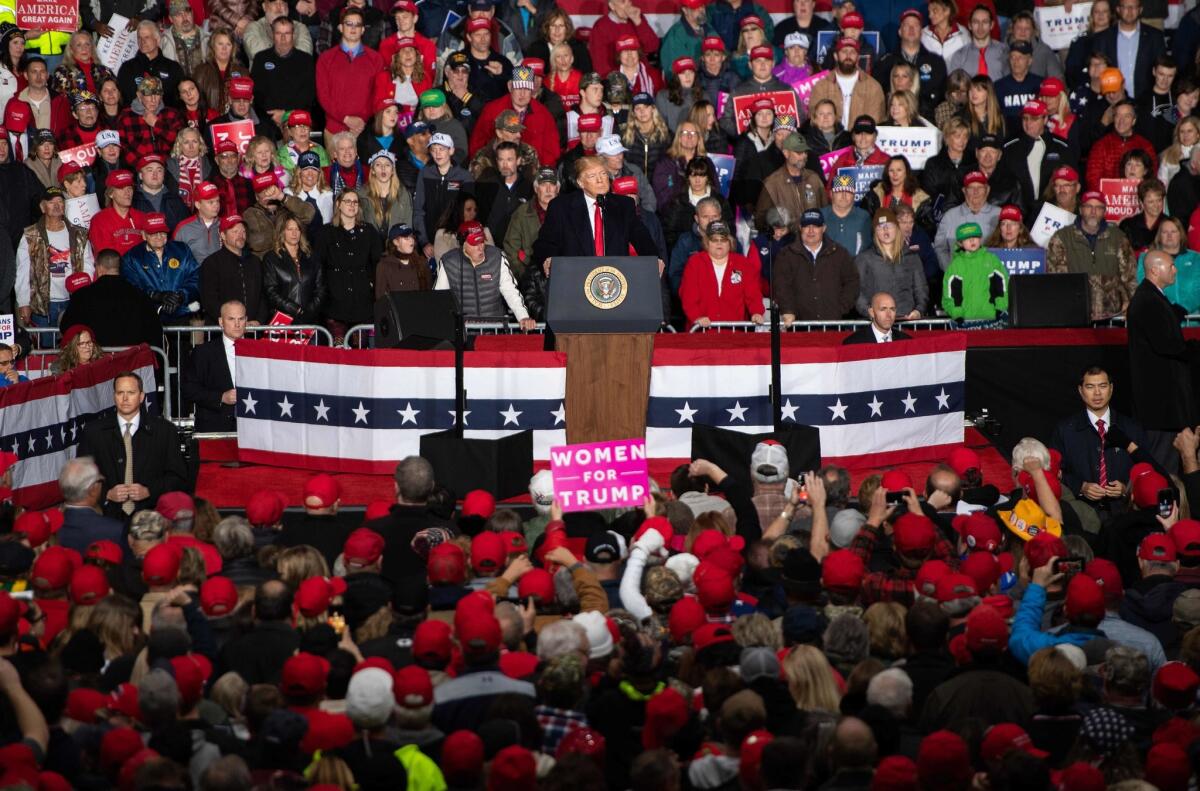
I wonder if President Trump ever looks in the mirror and sees himself morphing into President Obama.
Naw, probably not. But word that Trump, who excoriated Obama for governing via executive orders when he took such steps as creating the Deferred Action for Childhood Arrivals program after failing to get congressional cooperation, is again contemplating using the same mechanism.
Trump reportedly is looking at pushing fast-track regulations to deny or slow admissions to certain asylum-seekers, a move targeting the most-recent and dwindling caravan of Central Americans moving northward through Mexico. Trump also intends to send another 800 military troops to the border, a move that will do little — the military is barred by law from civilian law-enforcement activities, though it can provide logistical and other support — and is just political showboating ahead of the midterm elections, in which the Republicans are in trouble.
It’s unclear just how much federal money the president would waste in his new puppet show, and conservatives should be howling about misuse of the military and wasteful spending of tax dollars. But most of them won’t because they have by and large abandoned their principals and thrown their political lot in with a president who defies the law, disdains the institutions he’s in charge of, and sees the world not through the lens of national interest, but whether he can win the game in front of him. And, oh yeah, serve the interests of his family business along the way.
No one yet knows what the administration will roll out, and the American Civil Liberties Union, among other groups, is already warning that the administration is contemplating moves that contradict basic human decency, not to mention U.S. laws governing how those seeking asylum must be treated.
“It’s disgraceful the Trump administration would even consider what’s being reported,” Omar Jadwat, director of the ACLU’s Immigrants’ Rights Project, said Friday morning. “It would mean refusing to protect people who can prove they are fleeing persecution. That would be a huge moral failure and any plan along these lines will be subject to intense legal scrutiny.”
Asylum laws date to the post-World War II era, when the world recognized that it had botched how it handled refugees from an all-consuming war. Since then, the United States and other countries have adopted laws governing asylum, while also signing treaties pledging international cooperation and support for standards built on the idea of non-refoulement — the understanding that no government should return people to places where they are likely to be killed or persecuted.
Depending on how Trumpian Trump’s pending executive orders and regulations might be, they could violate various elements of the following laws and treaties:
* The 1951 Convention on Refugees, augmented by the 1967 Protocol Relating to the Status of Refugees. The United States didn’t sign the 1951 treaty but implicitly agreed to it when it signed the 1967 protocol expanding the 1951 treaty, which had applied to war-related events prior to 1951. It defined a refugee, enumerated rights to asylum and set governments’ responsibilities in dealing with such requests.
* The Immigration and Nationality Act, first enacted in 1952 and later amended multiple times, and the Refugee Act of 1980 put into U.S. law the right to asylum for people facing a credible fear of persecution in their home country based on race, religion, nationality, whether someone is part of a particular disfavored social group, or political beliefs.
* The 1984 Convention Against Torture, under which, following the principal of non-refoulement, countries agreed to not send people back to places where they would be subject to torture or inhumane treatment.
* The Victims of Trafficking and Violence Protection Act, initially enacted in 2000 and reauthorized and renamed in 2008 as the William Wilberforce Trafficking Victims Protection Reauthorization Act. This requires the government to take unaccompanied minors into protection to ensure their safety and refer to immigration court to determine whether they should be allowed to stay. The law treats unaccompanied minors from contiguous countries — Mexico was the focal point — differently by giving the government 48 hours to determine that the child was not a victim of trafficking, and thus can be sent home barring another claim to stay, such as refugee status.
Trump’s flailing about notwithstanding, the United States has systems in place for dealing with asylum-seekers, including those in the dreaded caravan of the desperate. People from other countries are, under federal law, allowed to show up anywhere along the border and ask for asylum. If they fail the initial step of persuading immigration officials that they have presented a credible fear of persecution, they can be deported. If they clear that first hurdle, they earn the right to make their case to an immigration judge.
The crisis here is not that so many people are seeking asylum. A nation of more than 300 million can handle a couple of thousand more people deserving of protection. In fact, on average 1,340 babies are born in California every day. The crisis here is that the Trump administration — which has already drastically throttled-back refugees admissions — doesn’t want to admit people seeking asylum, particularly from his famously described “shithole countries.”
We have laws and obligations governing this process; The president doesn’t like them, so he wants to throw on his emperor’s robe and rule by edict. That’s the crisis here: an unfettered, “America First” nationalist with no respect for the law or for the country he purportedly serves.
And leaders of Congress, the body that created the laws governing asylum, and the body now in the control of a party that previously condemned Obama for governing by executive order, will do nothing. That’s what voters should focus on.
- Share via
A criminal investigation against Julie Swetnick? And we wonder why more women don’t come forward
Some people, like our president, wonder why women don’t come forward to report sexual harassment and assault if it’s “really as bad as they say.”
Here’s why: Because, as Christine Blasey Ford’s experience illustrates, there’s just no upside. Not only do you have to relive one of perhaps the worst moments of your life, and in public, but there’s also a good possibility you’ll be told you are mistaken, crazy or conniving.
Ford knew her decision to come forward and recount her experience with a young Brett Kavanaugh would change her life — and not in a good way. And that’s exactly what happened — and continues to happen. She and her family continued to get death threats while Kavanaugh was awarded a seat on the high court.
You’d think that Republican senators would be happy enough with the downfall of one big-mouthed woman, especially after winning the round. Nope. On Wednesday Sen. Charles E. Grassley, chairman of the Senate Judiciary Committee, formally asked the Justice Department to investigate Julie Swetnick — the woman who signed a sworn statement that she saw Kavanaugh during his prep school years at parties where there was excessive drinking and women were raped — and her attorney, Michael Avenatti — also counsel of porn star Stormy Daniels, who says she was paid to keep quiet about a sexual tryst with Donald Trump — for submitting allegedly false statements to Congress.
Why bother at this point? As a lesson to other women, of course, to beware opening their mouth to accuse powerful men of misconduct. “Ignoring this behavior will just invite more of it in the future,” Grassley said.
- Share via
A memo to Prop. 6 backers: It’s totally legal to spend gas taxes on public transit. It’s also smart
The campaign to pass Proposition 6, which would repeal last year’s gas tax increase, has been filled with gross exaggerations and misleading claims.
One of the worst is the assertion that the state is maliciously misspending fuel tax and vehicle fee revenue on — gasp! — public transit.
Proposition 6 campaign chairman Carl DeMaio has complained that lawmakers have “diverted” fuel taxes to pay for transit. DeMaio argues that gas tax revenues should be spent solely on roads.
Here’s the problem with that argument: California voters have already committed gas tax money to public transit — in 1974. Proposition 5 on the June 1974 ballot was a constitutional amendment that allowed fuel excise tax revenue to be spent on building and maintaining mass transportation systems. It also allowed the money to be used for the environmental mitigation of highway and transit projects.
“While Californians take pride in having the finest highways in the world, we must concede that in many areas we’re nearly paralyzed because of congestion,” the supporters of Proposition 5 wrote in the ballot argument. “Unless we want to put much more of our State under an asphalt blanket, accompanied by increased taxes and a deteriorating environment, we have to begin moving in a new direction.”
Sound familiar? Proposition 5 was passed during the gas shortages of the 1970s. Los Angeles was smothering under a layer of smog and the state’s urban highways were increasingly clogged with cars. California voters made a decision to begin a transition toward more mass transit to cut air pollution, ease congestion and reduce reliance on oil.
It’s been slow going. The bulk of the state’s fuel taxes have still gone to highway projects and road maintenance. There’s never been enough money to build out urban mass transit systems, although that’s changing as more counties pass sales tax increases for transportation investments. It’s also harder to build mass transit to serve the state’s suburban sprawl and dispersed job centers. Again, that’s changing a bit as cities build more housing and jobs in their urban cores.
The decision in the 1970s to allow gas tax revenue to be spent on public transit remains the right one. California is still choking on unhealthy air and highways are still clogged. And the state is part of a worldwide race to slash carbon emissions to prevent climate change that will wreak havoc in California, including life-threatening heat waves and long periods of drought followed by destructive floods.
But to hear Proposition 6 supporters tell it, there’s no climate change threat and no need for change. There’s no recognition that Californians have already committed to expanding public transit, or that investing in buses, trains and bike infrastructure is about giving people more choices to get around so they don’t have to sit in traffic.
Instead, Proposition 6 backers are intent on trying to convince voters that it’s all a nefarious scheme. Like Republican Diane Harkey, who is running for the congressional seat being vacated by Darrell Issa and recently said this at a news conference:
“This is just fraud. It’s forcing you to take bikes, get on trains, hose off at the depot and try to get to work. That does not work. That does not work with my hair and heels. I cannot do that and I will not do that.”
There’s no fraud. There’s no forcing. And there should be no turning back from a future that Californians endorsed four decades ago, where people can choose to drive or choose to take the bus or choose to bike. No matter their hair or heels.
- Share via
The Trump administration takes a step that might - gasp! - help Obamacare
A day after announcing a rule change designed to undermine Obamacare and its protections for people with preexisting conditions, the Trump administration unveiled a proposal that just may strengthen Obamacare.
Wait, what?
Reversing a position taken by the Obama administration, the departments of Labor, Treasury and Health and Human Services proposed Tuesday to allow employers to give workers cash, tax-free, for healthcare insurance and expenses in lieu of providing a group insurance plan. Workers would have to combine their Health Reimbursement Accounts, however, with an insurance plan that complied with the requirements of the Affordable Care Act (with one important exception that I’ll explain in an update below).
They could conceivably get that coverage from their spouse’s health benefits at work. Or, more likely, they would find it in the individual market served by the state Obamacare exchanges.
There’s all sorts of risks here, foremost among them that employers with good group health plans will drop them and kick their workers into the exchanges. But critics of the ACA made the same dire warnings, and there’s been no such exodus. The percentage of small employers offering coverage is down slightly, while the percentage of large employers with health benefits has ticked up. Overall, it’s a wash.
What these gloomy predictions overlook is the reason employers offer health benefits: To attract good employees. The more competition there is for labor — and there’s a lot right now — the more incentive they have to offer something workers want, and there’s no question that a job with health insurance is more attractive than a job that requires you to find your own policy, then pays you back for it.
Another, more insidious risk is that employers will use HRAs to push sicker, costlier employees into the exchanges while keeping healthier ones on the company’s group plan. Acknowledging the risk and the threat posed to the exchanges, the administration’s proposal includes several safeguards. Among others, it would bar employers from offering both an HRA and a company plan to the same class of employees, and it would require HRAs to be offered on the same terms to all workers in a class.
Still, there’s room for quite a bit of maneuvering here. Different terms could be offered to full-time and part-time workers; union and nonunion employees; those in different geographic regions; newly arrived workers and veteran employees; and those under age 26 and older workers.
[Update: Gary Claxton, a health policy expert at the Kaiser Family Foundation, notes that the proposal appears to allow employers to use tax-free HRAs to reimburse workers for policies with limited benefits, such as dental and vision plans. But it could conceivably include short-term “junk” health insurance policies that don’t comply with the ACA’s protections for essential benefits and preexisting conditions. Whether that leads employers to abandon full-fledged insurance benefits, however, would depend on how hard they have to compete for labor. And companies with 50 or more full-time employees would still face stiff federal penalties if they don’t offer comprehensive insurance policies.]
It’s important to view the proposal in context with the other steps the administration has been taking to let younger, healthier people in the individual market pursue cheaper, thinner policies outside the exchanges. That’s what the guidance the administration unveiled Monday was all about: contorting a waiver provision in the ACA to let states permit insurers to offer less comprehensive coverage — including short-term “junk” plans that typically refuse to cover some preexisting conditions.
Health policy analyst David Kendall of the Third Way think tank argues that Tuesday’s proposed rule “would make it easier and create more political pressure to segment the employer and individual marketplaces by risk — sick vs. healthy, young vs. old.” The ACA had the opposite goal, seeking to help the large minority of Americans with preexisting conditions by grouping them into broader risk pools with healthier people.
“Even with good safeguards, there will be even greater political pressure to do cheap fixes like what the GOP has been trying to do with short term plans, etc.,” Kendall wrote in an email. “It is an easier legislative path for cheap fixes that segment risk than for expensive fixes that hold risk pools together. Even if something good does come from increasing individual choice and responsibility for coverage, we’re in for a lot more turmoil and danger in the meantime.”
The skepticism is understandable, considering this administration’s track record in healthcare and all the steps it has taken to reduce enrollment in the exchanges. Yet for small businesses, health insurance is an expensive, inefficient distraction. It’s better for all concerned when these workers join the bigger risk pools of the exchanges than when they are in small groups with few, if any, options for coverage. If the administration’s proposal leads more businesses with crummy health benefits or none at all to help their employees find comprehensive coverage on the exchanges that they can afford, that’s a win.
- Share via
Megyn Kelly endorsed blackface? What was she thinking?

Halloween is always getting people in trouble. There’s just something about feeling liberated to dress in costume that makes people stupid. (I hate to bring this up, but remember how now-beloved Prince Harry turned up as a Nazi at a costume party years ago?)
On Tuesday, Megyn Kelly, host of the third hour of the “Today” show on NBC, embraced blackface as a Halloween costume choice. No, she didn’t don it. (Thank God.) But she and her fellow chatters were grumbling about all the costumes deemed politically incorrect when she suddenly dropped this: “What is racist? You truly do get in trouble if you are a white person who puts on blackface at Halloween or a black person who puts on whiteface for Halloween. When I was a kid, that was OK as long as you were dressing up as, like, a character.”
Seriously? Whom did she dress up as when she was a kid? Al Jolson?
Do we really need to give her a history lesson in the racism of white minstrels slathering their faces with black shoe polish to appear like bug-eyed, big-lipped caricatures of black people? And I know of no black person who put on whiteface — except for Eddie Murphy in that classic 1980s “Saturday Night Live” skit in which he went undercover as a white person and discovered that white people get perks such as being served cocktails on a public bus.
Kelly couldn’t stop there. Here’s her reaction to Luann de Lesseps, one of the (white) Real Housewives of New York, dressing as Diana Ross and darkening her skin: “People said that was racist and, I don’t know, I felt like, who doesn’t love Diana Ross? … I don’t know how that got racist on Halloween.”
Well, here’s how: She darkened her skin! If she had just put on the clothes and the wig and called it a night, I don’t think anyone would have called it racist. A bad costume choice, maybe, but not racist.
Here’s the deal: it’s racist to imitate a long-disgraced and racist type of performing.
Next week is Halloween. The “Today” show cohosts revel in dressing up in elaborate costumes. Please, Megyn Kelly, do not come dressed as Diana Ross. Or any black person.
- Share via
Wave election or not, there will be more moderate voters in the water
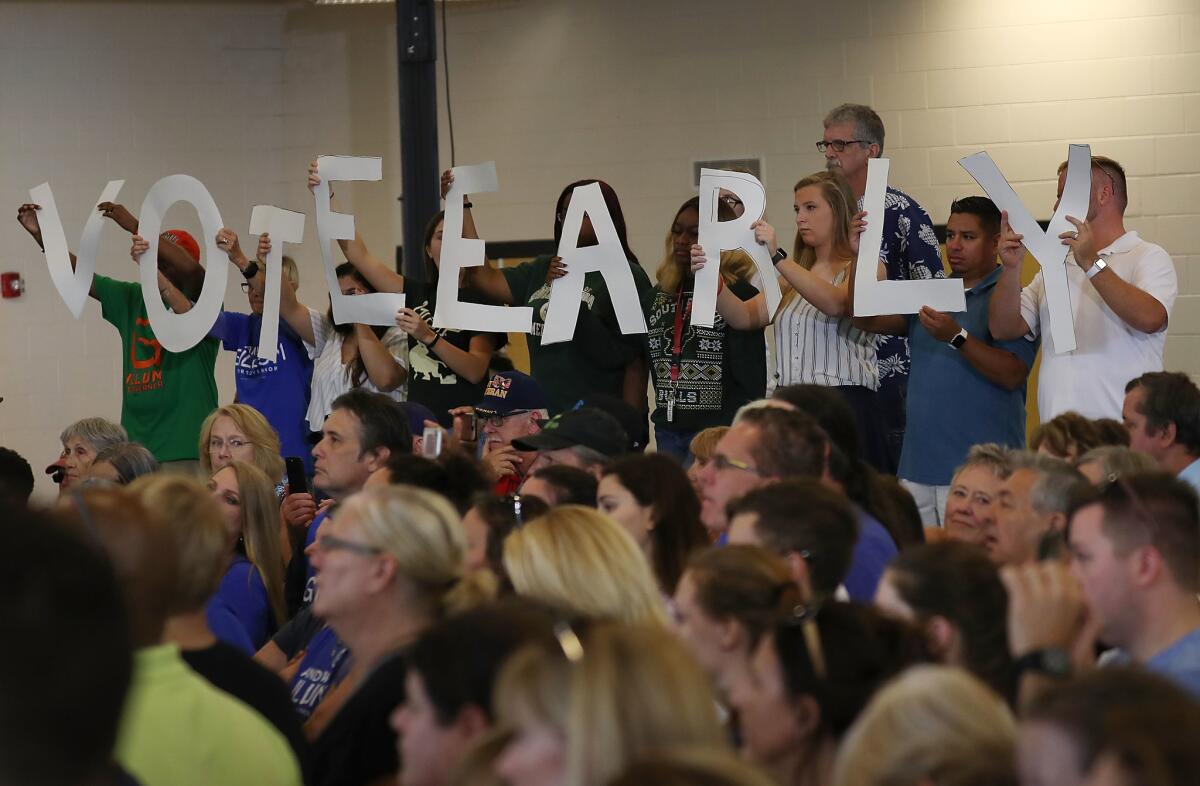
There are two consistent messages in recent national polls about the coming midterm election. One, as seen in the latest results from USC Dornsife/Los Angeles Times, is that significantly more Americans plan to vote for Democrats than Republicans. The other, as illustrated by this new NBC News/Wall Street Journal poll, is that surging voter enthusiasm in both parties could lead to a huge turnout.
National surveys about voter preference should be taken with a full shaker of salt. The Democrats who dominate the coastal cities don’t get to vote in the GOP-led states lying between them. Yes, every midterm election since 2006 has been a “wave” election of some sort, shifting power dramatically in one chamber or the other. But as the person selling you mutual funds is duty-bound to tell you, past performance is no guarantee of future results.
The turnout projections are more interesting, coming at a time when President Trump’s unusually low approval ratings are climbing. He’s close to being in net positive territory — more voters approving than disapproving — for the first time in his tenure. Given the unblinking support from his base and unwavering hostility from Democrats, Trump’s improved ratings could be coming only from less ideological voters in the middle.
You could make a good argument that the approaching election has prompted these Americans to take stock of their circumstances — among other encouraging signs, the economy is growing more rapidly, wages are rising faster than inflation (albeit not by much), and there are more job openings than job seekers for the first time in years.
But Trump isn’t on the ballot himself. And as turnout rises, it brings in a growing number of voters whose politics aren’t defined by their virulent support for or opposition to the president.
The British-based nonprofit More in Common recently released a study, “The Hidden Tribes of America,” that used surveys to break the U.S. population into seven groups across the ideological spectrum. The report found fundamental disagreements between the left and the right about important issues, but also said this: “The reason American society appears to be split 50/50 is that the loudest and most extreme viewpoints monopolize airtime and social media space.”
By More in Common’s count, the extreme viewpoints account for only a third of the population. In a low-turnout election — like most midterms — those forces have disproportionate clout because they are the most engaged. The higher the turnout, the more that voters in the middle show up and dilute the power of the extremes.
Granted, we don’t know why voters camped between the left and right wings are motivated this year; they may be fed up with the way Republicans are running Washington, or they may want to keep Democrats from spoiling what they see as a good thing. Most likely, it’s both of those reasons and others too. With a group this disparate, more than one factor is certainly at play.
Still, the implication of the high projected turnout is that the Americans who are most interested in compromise are planning to cast ballots in this election. Many are also skeptical about Washington’s ability to get things done in an era of polarized politics, so may be eager for a change in tone and approach.
It would be great if these voters in the middle could cast a ballot for the compromise, bipartisanship and good faith they really want out of Washington. They can’t, of course — they can only vote for candidates and hope those qualities will emerge. So their message may be lost, depending on how things turn out Nov. 6. But this time, at least, it looks like they’ll be showing up.
- Share via
The lies congressional Republicans are telling about their healthcare (voting)
Some congressional Republicans are apparently so desperate to hold on to their seats on Nov. 6 that they are willing to gamble that voters won’t notice their newfound affection for the popular parts of the Affordable Care Act that they tried to kill again and again.
From California to Pennsylvania, Republican candidates are claiming they support a popular consumer protection in the ACA that prohibits insurers from denying coverage to people with preexisting conditions, without mentioning they have voted dozens of times to repeal or undermine President Obama’s signature healthcare law and the provisions on preexisting conditions since it passed in 2010.
Orange County Rep. Dana Rohrabacher is among them. The Costa Mesa Republican is in a pitched battle against Democrat Harley Rouda, who is polling even with the incumbent.
Rohrabacher’s daughter Annika was diagnosed with leukemia when she was 8 (she’s 14 now) and in a campaign ad, her father links the experience to his appreciation for the nation’s healthcare system. “That’s why I’m taking on both parties, and fighting for those with preexisting conditions,” Rohrabacher says in the ad.
Oh please. Even after Annika got sick, Rohrabacher continued to vote, repeatedly, to flat-out repeal or defund the ACA. And just last year, Rohrabacher voted for the ACA replacement bill that would have allowed states to let insurers gouge people with preexisting conditions and, worse, drop coverage for the treatments many Americans may need.
So when did this conversion happen? Probably when the polls showed that his Democratic challenger just might win.
Look, it’s great if Republicans have finally come around on this important consumer protection. And if they had a true change of heart, then why not be straight with voters and say, “Hey, I was wrong about the ACA. It’s not all bad, and I think this part is pretty great even though the president I support is trying to undermine it.”
But that’s not what’s happening here. And voters shouldn’t let them get away with it.
- Share via
Trump is exactly the wrong leader we need to respond to the caravan heading to the U.S.

As the caravan of thousands of mostly desperate Hondurans makes its way north through southern Mexico, one thing has become abundantly clear: President Trump and his brain trust have absolutely no idea how to handle it.
Fuming and frothing, Trump urged the governments of Honduras, Guatemala and El Salvador to stop the caravan and announced Monday morning that he “will now begin cutting off, or substantially reducing, the massive foreign aid routinely given to them.”
Something about the barn door and the fleeing horse comes to mind.
Trump also went full-crazed about who is in the caravan, tweeting that “criminals and unknown Middle Easterners are mixed in.” He added, “I have alerted Border Patrol and Military that this is a National Emergy. Must change laws!”
Exactly what law change he refers to is unclear, as the president has yet to offer any proposals of his own and nothing is on the front burner in Congress. He’s just shaking the rattle here. Also, what law change would address the ginned-up issue of Middle Easterners (evidence, please?) intermixed with Central Americans? And why is the unsupported allegation that Middle Easterners are in the caravan a different or additional problem, as Trump implies, from Hondurans trying to reach the U.S.? Hint: That high-pitched tone is a dog whistle.
Any administration deserves some sympathy for trying to figure out how to handle illegal immigration into the U.S., a problem exacerbated for more than a decade by Congress’ abject abdication of its responsibility to reform the dysfunctional immigration system. The issue vexed the Obama administration as well as the George W. Bush administration that preceded it (Bush pushed for comprehensive reforms that failed to move). It’s a bipartisan failure, another victim of the nation’s seemingly unbridgeable political polarization.
Trump, of course, blames only Democrats, hoping to use the caravan story to boost the Republicans’ flagging chances of retaining control of the House in the midterm elections already underway in California and other states with early voting systems.
But as The Times editorial board pointed out the other day, Trump screaming “The caravans are coming! The caravans are coming!” is a willful misread of the state of illegal immigration. More and more people come legally and overstay visas; net migration from Mexico is in the other direction, and most of the folks making the difficult trip to the U.S. border do so with legitimate fears that to do otherwise would imperil their safety amid intractable violence and gang wars in the places they left behind.
This is a thorny issue with a lot of nuance, two elements that the Trump administration has proven to be bad at handling.
Broadly, the number of people living illegally in the U.S. has held steady in recent years at just over 11 million people, roughly a quarter of the nation’s total foreign-born population (at the highest level in a century). Illegal border crossings have steadily dropped over the last decade, but within that decrease has come an increase in numbers of unaccompanied minors and families with minor children – overwhelmingly people fleeing for their lives.
This is where some of the nuance comes in. Broadly speaking, the violence comes from two sources: Street gangs whose roots trace to Los Angeles and other U.S. cities that were home to Central American migrants during that region’s civil wars in the 1980s (where the U.S. backed hard-right forces against leftists), and patriarchies in which law enforcement rarely intervenes in domestic violence. The latter problem has been so bad that immigration judges ruled during the Obama administration that Guatemalan women abused by their intimate partners could be considered a social class eligible for asylum in the U.S.; Atty. Gen. Jeff Sessions overturned that ruling earlier this year.
The Obama administration, which also stumbled in trying to address the problem, at least properly viewed the arrivals of unaccompanied minors and families as a humanitarian crisis — especially for parents so desperate that they saw the best option for their children was to send them north and plead for sanctuary at the American border.
Trump views that flow of the desperate as an “assault on our country,” a cynical attempt to portray the poor, the fearful and the battered as some sort of invading force.
Do the battered women of Guatemala deserve asylum in the U.S.? Does fearing violent neighborhoods make one eligible for sanctuary? Does the U.S. have a moral duty to offer help to people victimized by gangs that were birthed here? Those are questions worthy of discussion, and legislative attention.
But sputtering and fuming by the president does nothing to move us toward a solution. If the president was truly interested in reforming the immigration system, he’d be offering ideas and solutions. He’d be convening power brokers on all sides of the issue to try to forge a compromise approach and a path forward.
To the contrary, he has no interest in fixing the problem. It is through exploiting such political divisions that he finds his political strength — rallying a hard-right base opposed to immigration in a political system where elections are won by a minority of eligible voters. Turnout in 2016 was 60% of the voting-eligible population; Trump received 63 million votes, or 27% of the voting eligible population, from Americans concentrated in enough states to win the election.
Our federal elections tend to get won in the margins. Most House seats are gerrymandered to favor one party over the other, so the number of seats truly up for grabs is limited. Senate races aren’t subject to gerrymandering but they do tend to break reliably Republican or Democratic, depending on the tilt of the individual states — only 13 of the 50 states have split delegations in the Senate (including two states that elected an independent as one of their senators). And in the presidential election, the fight is over slices of the electorate in a handful of states that either party might be able to win. That usually hinges on rallying bases while appealing to relatively small blocs of voters.
So in the Trump political landscape, a caravan of the desperate isn’t a humanitarian crisis or a problem to be solved, but a moment to exploit.
Some leadership.
- Share via
If progressives want women and people of color in office, they need to work harder to keep them safe
Last week, I received a series of texts from Verita Black Prothro, a woman I’d interviewed when I covered the women’s march in Reno nearly two years ago. Since then, Black Prothro decided to run for public administrator in Washoe County, the northwest Nevada district that contains Reno. Her speech at the women’s march animated the audience, which cheered and teared up as she spoke. “We pray that those who say they walk with Christ start acting like they walk with Christ,” she said of the Trump administration, which was just taking office. “In the Old Testament through the New, we’re told to care for the poor, the widows, and the orphans. This whole thing they call ‘tough love’ — that’s not mentioned in the Bible.”
So when I saw the first text — an image of a campaign sign with Black Prothro’s face covered in black spray paint except for her eyes and mouth and the “Black” in her name crossed out — I dropped my phone. It was such a degrading depiction of such a dignified woman that, for a moment, the whole thing did not compute.
But we live in a world where women and people of color are not safe and where women of color are exponentially less so. The Huffington Post has been keeping a running list of racist attacks on candidates of color. At the time of writing, twenty-three political candidates in this year’s elections were reported to have been victimized; three, including Black Prothro, are from Nevada. Black Prothro says that these experiences are more common than reported. For instance, when a Latino candidate in Nevada was shot at while campaigning in 2016, he didn’t talk about it until the election was over, worried it would negatively impact his chances.
And while a striking number of black candidates are running for office in November — including high-profile gubernatorial candidates Stacey Abrams, Ben Jealous and Andrew Gillum — some have pulled out of their races because of safety concerns.
“It’s hard enough to throw yourself out there to begin with,” Black Prothro says. “Then when you have the added layer of people either believing you don’t belong or that you don’t have any business running for office, it’s a scary experience.”
Seeing the sign — which was defaced at an intersection in Arrowcreek, one of Reno’s nicest neighborhoods — wasn’t the first time Black Prothro had felt afraid. When she was canvassing by herself in September, a man pulled his truck over, revved his engine and asked her what she was doing there. He was agitated, spitting mad. She lived in that neighborhood, as she had most of her life, she said, and she showed him her canvassing materials. “If I had been in a neighborhood that wasn’t mine, if I had run out of knock pieces…” she says, trailing off. It reminded Black Prothro of when someone called the cops on black politician Janelle Bynum while she was canvassing for re-election in her own Oregon neighborhood, claiming that she was acting suspicious.
So Black Prothro stopped canvassing alone. But even now, when she canvasses alongside a friend who’s running for state assembly, they divide up the streets. She’s skipped certain ones based on gut fears, fears that were amplified when her sign was defaced.
Because while progressives have celebrated the record number of female candidates and/or candidates of color running this year, they haven’t done enough to protect these challengers of the status quo. “People who are our allies, friends, and supporters need to understand that there is this added layer of risk,” Black Prothro says. “If we’re encouraging more women of color to run for office, we also need allies to do things like walk with us and make us feel safer.”
It’s a terrible catch-22; candidates of color need to work harder in order to reach out to constituents who would stereotype and devalue them, but they’re less safe when they do that outreach, particularly after work as it’s getting dark (which is when people are actually home) or in neighborhoods where they are less familiar (the exact neighborhoods they need to be doing outreach in).
For Black Prothro, the greatest strain has been on her family. “My mom saw it and said her chest felt tight. My kid didn’t want to go to school; he said, ‘I’ll stay home so I can protect you.’ People don’t think about the impact of these things on the people who love and care about you. They suffer this too,” she says. Black, Latino and otherwise marginalized candidates are putting themselves out there in a contentious environment where racists are feeling ever more emboldened. Many, considering these risks, may decide not to run at all.
Signs are tough to protect; they’re often put up outside homes, yes, but also in empty lots or along highways. But candidates are a different matter. After Black Prothro shared her experience on Facebook, a number of progressives reached out, offering to walk alongside her. They should be doing this proactively.
For decades, progressives have escorted women who need abortion care to clinics so that they feel protected from people who would do them harm. Now, it’s time for progressives to offer to walk alongside their candidates of color. Because it’s not enough for compelling progressive candidates like Black Prothro to throw their hats in the ring. They need to be able to get their message out in every nook and cranny of their districts if progressives actually want them to win.
- Share via
There is a cost to complicit silence on sexual abuse. For USC, $215 million is just a downpayment
It looks like USC has finally gotten the message.
Following a series of scandals on campus that were only made worse by the administration’s attempts to quietly bury the problems, the university announced Friday that it had reached an agreement to pay $215 million to patients treated by Dr. George Tyndall, the longtime campus gynecologist accused of abusing and sexually harassing patients.
The “agreement in principle” calls for the university to provide $2,500 to every student who ever saw Tyndall at the campus health clinic and up to $250,000 to students who provide a written claim of abuse and who agree to be interviewed by a psychologist. An independent evaluator appointed by the court will decide the individual award.
USC’s Board of Trustees supports the proposed settlement, which was developed with the plaintiffs’ attorneys.
The fact that USC reached such a large and sweeping settlement so quickly is significant. It shows that the university acknowledges its failure to protect students and is willing to pay the price in an attempt to repair the damage.Tyndall was repeatedly accused of improprieties over the course of decades. The administration forced him out in 2017, but his misconduct was not revealed to patients or the USC community until a Times investigation was published in May.
That prompted hundreds of women to come forward with their stories of abuse and mistreatment by Tyndall. A total of 463 women have sued USC over the matter, according to The Times.
The university put a priority on reaching “a fair and respectful resolution,” interim President Dr. Wanda Austin wrote in a statement. “By doing so, we hope that we can help our community move collectively toward reconciliation. I regret that any student ever felt uncomfortable, unsafe, or mistreated in any way as a result of the actions of a university employee.”
The settlement is the right thing to do. But USC leaders have to reckon with the fact that the $215 million won’t be the final tally. The university will still be on the hook for attorneys’ fees. The settlement resolves a federal class-action lawsuit, but there are still hundreds of claims filed in state court.
Then there is damage to USC’s reputation from the Tyndall investigation and other scandals that prompted President C.L. Max Nikias to step down earlier this year. For years USC has been on the rise, climbing the national rankings of colleges and universities and raising billions of dollars to expand its footprint. How many students decided to enroll at another university because of the scandals? How many professors and researchers took jobs elsewhere? How many donors walked away?
There is a cost to complicit silence. The $215-million settlement is just a down payment.
- Share via
Trump and the Democrats are waging midterm war over issues that affect only a tiny fraction of Americans

In the build-up for the midterm elections, Democrats are flailing Republicans over health insurance for people with preexisting conditions, and President Trump is flailing Democrats over a caravan of Central American migrants heading toward our southern border.
Both of these issues speak to deep-seated insecurities among overlapping groups of voters — the well-founded concern about rising healthcare costs, and less-well-founded fears about demographic and economic changes in this country. And both also shine a spotlight on what and whom Democrats and Republicans value.
But the two issues are being thrust at voters as if they were mountainous when, in terms of the number of people involved, they look a lot more like molehills.
Let’s start with preexisting conditions. Democrats have trained their fire on this issue because a number of GOP attorneys general, supported by the Trump administration, have filed suit in federal court arguing that Congress rendered the Affordable Care Act unconstitutional late in 2017 when it eliminated the tax penalty for people who don’t obtain insurance coverage. If they succeed, all the insurance reforms in the ACA — including those protecting people with preexisting conditions — will evaporate.
Like many in the GOP, Trump insists that Republicans would never, ever do anything to harm people with preexisting conditions:
That’s like saying all bosses support the employees they’re laying off. If Republicans really supported people with preexisting conditions, they wouldn’t be trying to repeal the legal provisions assuring that they can get coverage for those conditions without being gouged.
But here’s the thing. Most Americans have insurance coverage through large employer health plans or government programs, and under federal laws that predate the ACA, they are pretty well protected. If not barred by state law, a large employer plan could conceivably drop coverage for conditions or services needed by a worker. But for the coverage they do offer, they cannot exclude or charge higher premiums to workers because of their health.
The folks truly at risk here are those who buy insurance in the “individual market” served by the Obamacare exchanges. They make up about 7% of the population, or about 22 million people. And according to the nonpartisan Kaiser Family Foundation, a little more than a quarter of them have a preexisting condition that would have left them unable to obtain insurance before the ACA took effect. That’s about 6 million people — a big number in aggregate, but a very small share of the U.S. population.
So when the Democrats talk about people with preexisting conditions who are being threatened, chances are good that they’re not talking about you. The larger point buried in this issue, though, is that Democrats want to spread healthcare costs broadly across people with insurance, and Republicans don’t, preferring to let healthcare costs concentrate in smaller groups of people with expensive ailments (and then, possibly, subsidize those individuals — or not) so that healthier people pay less. That’s a fundamental difference between the two camps, and it’s the one we should be debating.
On the caravan, my colleagues on The Times editorial board pointed out how silly it is to get worked up about this marching band of migrants. The last time a supposedly giant caravan reached Mexico, in April, “government officials there dispersed most of the migrants and only about 150 reached the U.S. border,” the board wrote. “For comparison, so far this year, border agents have arrested an average of 42,651 migrants per month. The caravans are a drop in the immigration bucket and pose no significant risk to the United States.”
The dog whistle being blown here is that Central American immigrants represent the forces that are unquestionably reshaping the face and culture of this country. We can argue all day long about whether that’s a good or bad thing on any number of fronts, but Trump and his allies have painted a hyperbolically scary picture of people who cross the Mexican border illegally.
Again, just look at the numbers. By the time the latest caravan walks its way to the U.S. border, only a few dozen people are likely to be left in it. But even if all 2,000 arrived, backpacks in hand, they’d represent less than 5% of the people detained there every month. Put another way, almost four times as many Americans die every day as there are people in that caravan.
Trump is emphasizing the caravan because it puts into pictures what he sees is the failure of U.S. immigration policy. And because those pictures show low-income brown people, they feed the notion in the Trump Train’s xenophobic car that immigrants in the country illegally are takers, not givers.
Our immigration policy is well and truly broken, and Congress seems incapable of fixing it. But the folks now heading north from Central America are not just a vanishing small part of the problem, they’re the wrong symbol. As the editorial board noted, “New immigrants who are in the United States without authorization tend to be people from Asia who enter the country legally and then overstay their visas, not desperate border-crossers from Latin America.”
- Share via
Trump’s mixed signals on attacking journalists: Murder bad, body-slamming good
President Trump mouthed some of the right words Thursday when he said it appears that dissident Saudi journalist Jamal Khashoggi had probably been murdered and that the consequences would be “very severe” if blame is firmly tied to the Saudi government. But, hours later at a campaign rally, he praised Montana Rep. Greg Gianforte, who won a special election last year despite body-slamming a Guardian journalist to the ground — an act for which Gianforte later pleaded guilty to a misdemeanor assault charge.
“By the way, never wrestle him,” Trump said to laughter from the crowd. “Any guy who can do a body slam ... he’s my guy.”
Remember, this is the same Trump who has described some U.S. media — the ones reporting stories he doesn’t like — as “enemies of the people,” routinely makes cordoned-off press pools targets of his supporters’ wrath during campaign appearances, and has supported some of the most illiberal and repressive authoritarian heads of state around the world, from the Saudi royal family to Filipino President Rodrigo Duterte to Turkey’s Recep Tayyip Erdogan, who at last count had imprisoned 237 journalists.
The Committee to Protect Journalists reports that at least 44 journalists have been murdered for doing their jobs so far this year; Khashoggi would be the 45th. That list includes four American journalists — staffers of the Capital Gazette in Annapolis, Md., who were shot to death when a gunman opened fire on their office in June. A fifth newspaper employee, a sales assistant, also died.
Over the past decade, the committee reports, worldwide at least 632 journalists have been killed in connection with their work.
And our president makes light over a physical attack by a politician against a working journalist. That’s dangerous territory.
When the ostensible leader of the free world openly targets journalists with his words, and gives wink-and-nod approval for physical attacks against them, he gives cover to the despots of the world.
You have to wonder whether that’s his intent.
- Share via
Feinstein vs. De Leon was like watching a high school civics teacher debate an earnest infomercial salesman
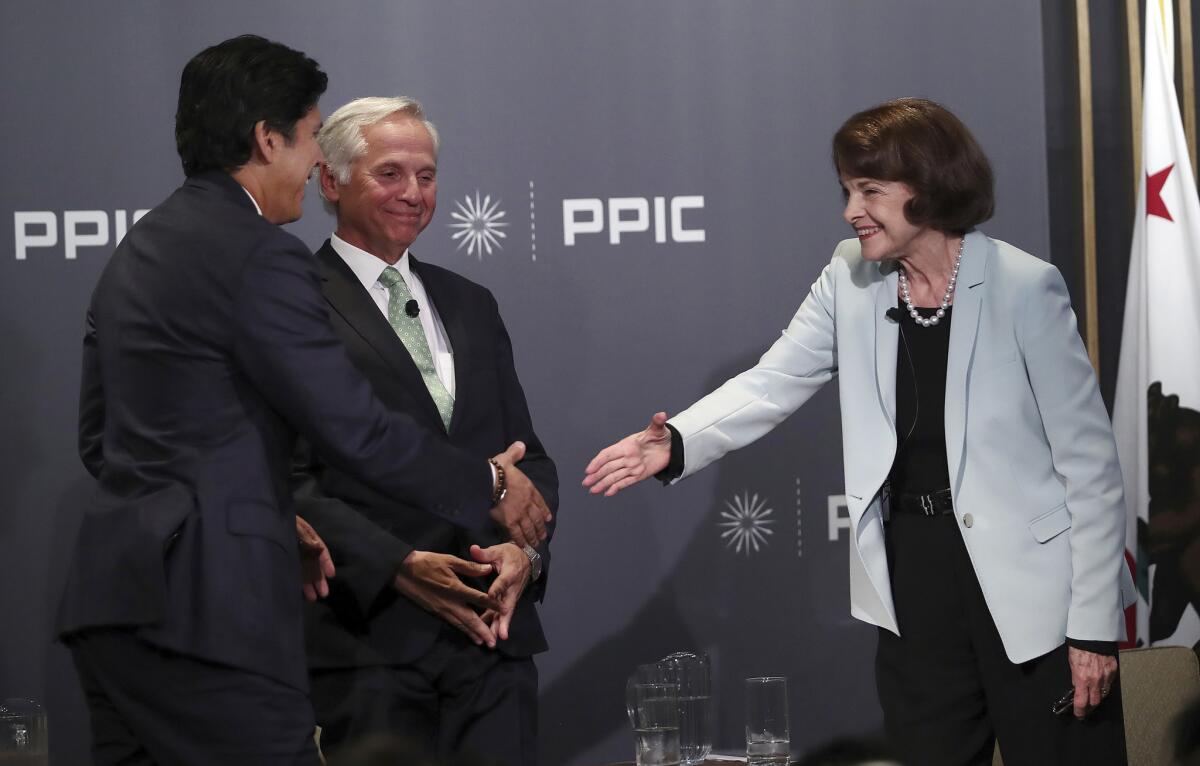
Watching the one and only debate between the two Democrats running for the U.S. Senate in California — incumbent Dianne Feinstein and her challenger, state Sen. Kevin de Leon of Los Angeles — I often found myself wondering what voters really wanted to hear from candidates. Was it their plans, or their ambitions?
Feinstein, whose been in the Senate long enough to have served in the majority and the minority twice, was all about plans. Incrementalism. Small ball.
De Leon, who enjoyed Democratic supermajorities during much of his time as president pro tem of the California Senate, was all about ambitions. Big, immediate change. Home-run swings.
Voters probably don’t want to be told how hard it is to get things done in the Senate. But like it or not, that’s the situation today. Routine use of the filibuster means that just about every piece of legislation requires 60 votes just to be considered on the Senate floor. And in recent years, the majority leader (both Republican and Democrat) has made it difficult even to offer amendments on the floor, for the sake of protecting vulnerable members of their party from having to cast votes on hot-button issues.
That left Feinstein explaining that she pushed only a temporary ban on assault weapons through the Senate in 1994 because the votes weren’t there for a permanent one. She also touted the lousy deal she struck with House Republicans on water legislation in 2016, saying, “It’s not perfect. It was the best we could do at the time.”
De Leon, on the other hand, argued that Democrats in Washington weren’t asking for enough. They’d shown a “lack of courage” and were “backpedaling all the time,” he complained; to De Leon, the better model was offered by Sen. Elizabeth Warren (D-Mass.), who might not prevail in legislative fights but who at least pushed her ideas out to a national audience.
In short, De Leon argued, the state’s representatives in Washington should be working harder to export California’s values and priorities to the rest of the nation, rather than battling to prevent Washington from imposing its values and priorities on California. In his view, that means pushing for such things as obtaining all U.S. power from renewable energy sources and adopting “Medicare for all, not Medicare for some.”
I suspect voters want to have it both ways. They want candidates with big goals who can get things done. I also suspect that voters want candidates who embrace both of those things while acknowledging the difference.
They didn’t get that from Wednesday’s debate at the San Francisco offices of the Public Policy Institute of California (whose chief executive, Mark Baldassare, moderated). De Leon came off as the earnest infomercial salesman promising a product too good to be true, and Feinstein as the civics teacher you ignored in high school.
“You can march, you can filibuster,” Feinstein said in response to De Leon’s call for greater militancy. “It doesn’t change anything. What changes things is elections.”
That may very well be true, but it’s a buzzkill of a message.
- Share via
Two more fox-in-the-henhouse appointments by Trump spell big trouble for our wildlife and national parks
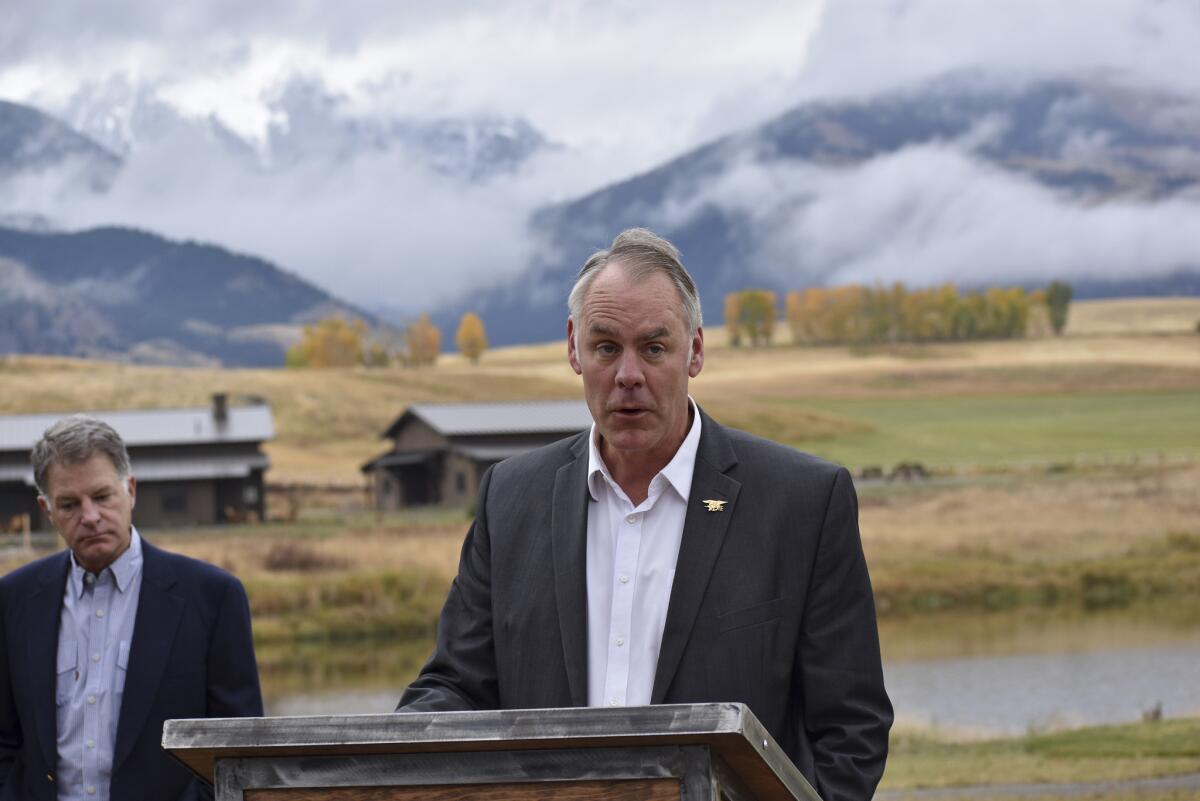
Two recent high-level personnel moves in the Trump administration’s Interior Department could well spell trouble for fish, wildlife and national parks, and raise serious questions about the credibility of the department’s multiple investigations into Secretary Ryan Zinke’s conduct and possible conflicts of interest.
First, the Trump administration has hired Wyoming attorney Karen Budd-Falen, who has made a career of criticizing and filing lawsuits over Interior Department policies, to be deputy solicitor for the Interior Department, where she will be involved in shaping legal opinions over fish, wildlife and parks.
Yes, the fox-in-the-henhouse scenario comes to mind.
Note that this is similar to Trump’s appointment of Scott Pruitt to run the Environmental Protection Agency, which as Oklahoma attorney general Pruitt had repeatedly sued over policy decisions. Before Pruitt was run out in an ethics scandal — OK, several ethics scandals — he sought a massive rollback of environmental regulations, many of which have fortunately been stalled by legal challenges.
Budd-Falen, who once represented Cliven Bundy, the Nevada rancher whose supporters waged an armed showdown with federal agents in 2014, has been aligned with the Sagebrush Rebellion, Westerners actively working to reduce federal control of public lands.
Environmental groups are, as one might imagine, concerned.
“Karen Budd-Falen is too extreme to be trusted with our national heritage,” Western Values director Chris Saeger said. “Someone who sides with armed militia groups and anti-public land zealots should not have a high-level job at the Department of Interior.”
The Wilderness Society’s Nada Culver said Budd-Falen’s “record with the law, her attempt to place an exaggerated version of private property rights over the public interest and her support of anti-public lands extremists like the Bundys — who were responsible for trashing the Malheur National Wildlife Refuge and intimidating public employees in 2016 — calls into serious question whether she can be trusted to apply the law on behalf of the Department of the Interior. Her appointment to this position is abysmal for the protection of wildlife, respect for sacred tribal lands and conservation of wild places that Interior is supposed to safeguard.”
A second personnel move threatens the integrity of Interior’s Office of Inspector General, which has open investigations into Zinke’s conduct and his wife’s travels on the taxpayers’ tab. The Trump administration shifted Suzanne Israel Tufts, a political appointee at the Department of Housing and Urban Development, to serve as acting inspector general at the Interior. She notably has no experience either in the department’s issues or in running investigations.
The issues currently being looked at by the inspector general’s office include: a Montana investment deal that involves the chairman of federal contractor Halliburton and property owned by a foundation connected to the Zinkes; Zinke’s decision, after a private meeting with MGM Resorts lobbyists opposed to the project, to overrule a departmental decision that would have allowed expansion of a Native American casino in Connecticut; and how Zinke and subordinates redrew Utah’s Grand Staircase-Escalante National Monument boundaries in a way that may have benefited a state representative who owns affected lands.
I’ll leave it as an open question whether Tufts is the perfect pick if the administration is trying to derail investigations, and just say that an inexperienced political appointee overseeing sensitive investigations does not instill much public confidence in the investigations themselves.
But then, what should voters expect from an administration that sees conflicts of interest as something of a birthright?
-------------
FOR THE RECORD
9:10 a.m.: An earlier version of this article identified Cliven Bundy as a Texas rancher. Bundy is from Nevada.
- Share via
Grammar matters
Was the president feeling especially truthful today? Or does he just not understand how commas work?
Raise your hand when you see it.
- Share via
Trump hasn’t come close to ‘draining the swamp.’ Can Democrats hijack his message?

How many stories about politics these days open with an anecdote about some new line being crossed?
At a televised debate Monday night between two Arizona congresswomen running to replace Sen. Jeff Flake (R-Ariz.), Republican Rep. Martha McSally accused Democratic Rep. Kyrsten Sinema of supporting treason — a federal crime that carries the death penalty. Sinema’s offense? When appearing on a libertarian’s radio show 15 years ago, Sinema did not object when her host asked her how she’d feel if he joined the Taliban.
The striking thing is that McSally and Sinema are far apart on a wide range of real issues that matter to every Arizonan, including taxes, healthcare and immigration. They don’t need to mud wrestle; the contrast between the two couldn’t be more clear — McSally is campaigning as a Trumpist, and Sinema as a moderate Democrat.
So why are we here? Scarcely a day goes by without some new low being reached. In fact, Michael Avenatti, the spotlight-seeking attorney for porn actress Stormy Daniels (real name: Stephanie Clifford), argues that this sort of ugly, antagonistic politics is the only way to play the game today. “You’ve got to engage in smash-mouth politics if you’re going to beat Donald Trump,” Avenatti said Monday in an interview with the Hill.
I know that plenty of readers blame us in the news media for the slide in discourse, given how we pounce on each new outrage. But right back atcha people — candidates go negative because the attacks get results. If they didn’t, and if voters instead punished candidates who engaged in (or whose allies engaged in) personal attacks on the campaign trail, then we’d see a lot more positive, issue-based races.
Nevertheless, the public is not happy with the state of politics today. The intense polarization seems to rankle everyone who’s not a die-hard partisan. And that discontent may very well fuel the fourth “wave” election in 12 years. Every midterm election since 2006 has led to a sweeping change of control in one or both houses of Congress, a sure sign that something is fundamentally wrong in the system.
Rep. John Sarbanes (D-Md.), chairman of the Democrats’ Democracy Reform Task Force, argues that the waves have been powered by a widespread sense among ordinary citizens that they are being ignored by their government. “In some ways, [President] Trump is the piece of driftwood that came in on this wave of anger,” Sarbanes said. “He was a message.”
In Sarbanes’ view, the public remains deeply skeptical about the ability to change what’s perceived as a rigged system. That was Sen. Bernie Sanders’ message in 2016 too as well as Trump’s, so clearly it resonates with voters on both sides of the political aisle.
That’s why Democrats have floated a blueprint for political and governing reforms they would pass if they regained the majority. In essence, it’s an Augean Stables agenda: tighten conflict-of-interest rules for government officials and the limits on lobbyists’ campaign contributions; attack gerrymandering and strengthen voting rights; and clean up campaign finance.
In other words, it’s the House Democrats’ version of “drain the swamp,” translated into weedy policy details.
Sexy, it’s not. This isn’t a manifesto about Democratic Party values like the House GOP’s “Contract With America” in 1994. Nevertheless, Sarbanes said, passing these bills would show Democrats’ willingness to take on the “special interests that have been rigging the system,” boosting their credibility on other priorities such as healthcare, climate change and taxes.
Not that the blueprint is merely an appetizer before the main legislative course. The issues involved are important ones, including how much leeway states should have over who can vote, what limits there should be on political speech by interest groups, and whether the public should offer tax dollars to help candidates who eschew big-dollar donors.
I’m not persuaded, though, that the public honestly wants to drain the swamp. It’s clear that Trump and his allies use that phrase simply to mean replacing Democrats in Washington with Republicans. With Trump in power and his favorability rating still low by historical standards, will voters now be content just to swap majorities? Or does the public really want to change the process itself?
- Share via
It could take Earth ‘millions of years’ to recover from the extinctions we’re causing. That’s ... not good
As bad as human-powered climate change might be — and it’s very bad — we often lose sight of the other sins our species has committed against the Earth. Plastics in oceans acidifying from pollution. Human overpopulation and an overdraw of natural resources. Habitat destruction. Fools hunting for animal trophies (how hard can it be to stop that?).
Last year, a peer-reviewed study published in the Proceedings of the National Academies of Sciences described human impact on global flora and fauna as “biological annihilation.”
Now a new report in the same journal warns that the annihilation is progressing faster than evolution can handle, and that “without coordinated conservation, it will likely take millions of years for mammals to naturally recover from the biodiversity losses they are predicted to endure over the next 50 years.”
Most vulnerable are large and complex organisms with few relatives on the evolutionary tree.
“Large mammals, or megafauna, such as giant sloths and saber-toothed tigers, which became extinct about 10,000 years ago, were highly evolutionarily distinct. Since they had few close relatives, their extinctions meant that entire branches of Earth’s evolutionary tree were chopped off,” paleontologist Matt Davis from Germany’s Aarhus University, who led the study, said in a news release.
“There are hundreds of species of shrew, so they can weather a few extinctions,” he said. “There were only four species of saber-toothed tiger; they all went extinct.”
But the extinctions of smaller creatures are a risk as well. In many ways, insects’ role in agriculture feeds us, and they form a foundation for the food chain. In fact, extinctions of insects influence the fate of larger creatures.
Scientists in recent years have noted that life on Earth has undergone five “great extinctions,” in which biodiversity collapsed and species disappeared. That’s what felled the dinosaurs 65 million years ago or more, which had the silver lining of opening space for mammals (you know, us) to evolve. National Geographic has a succinct overview of these waves here, but the causes have ranged from asteroid impacts to submarine lava flows destroying ocean life to massive glaciation.
Scientists believe that Earth is in the throes of a sixth great extinction. Humans are causing it. Ultimately, we could become the victim of our own excesses (there’s an interesting bit of mathematical prognosis here).
The good news? Well, there really isn’t any. Authors of the new extinction study say that concerted efforts to prioritize conservation to ensure the survival of endangered large mammals could lead to the survival of more species and shore up biodiversity.
That’s optimistic, to say the least. We can’t even get ourselves to wage a meaningful fight against global warming, which is already having significant effects on how humans live. What are the odds we’ll work to save other species when we don’t seem to be able to save ourselves?
- Share via
Your tax dollars at work: The U.S. vows to keep stopping Canadian pot-smokers from crossing the border

Here’s another example of how the U.S. government’s failure to acknowledge the shifting politics and public opinion on marijuana is creating a mess: On Wednesday, Canada will legalize recreational pot nationwide. But Canadians who admit to using this now-legal product could be banned from entering the United States.
That’s right — one lawfully purchased pot brownie could get a Canadian traveler blocked at the border.
That’s because the U.S. government continues to treat marijuana as a Schedule 1 drug, just like heroin. Last month the U.S. Customs and Border Protection Agency announced it would not adjust its border entry policies in response to Canada’s decision to liberalize its drug laws.
Instead, the agency will continue its stringent enforcement of the Immigration and Nationality Act, which bans entrance to travelers who admit to working in the marijuana industry, investing in a marijuana business or just using marijuana.
Such hard-line enforcement has already resulted in Canadians getting barred from entering the U.S., including a 57-year-old construction worker who made the mistake of telling agents the truth when they asked if he had smoked pot before he got his official medical marijuana license in 2010.
CBP officials said last month that agents are not planning to interrogate every Canadian traveler about marijuana use. But border agents do have broad discretion to ask questions of people seeking entry to the U.S., and they retain the authority to turn away noncitizens who admit to having used a controlled substance, ever.
This puts Canadian pot users in an impossible situation. If they admit to using a product that is legal in their country, they could be banned from coming into the U.S. If they lie about using marijuana and get caught, they also face a travel ban.
What’s even more crazy is that eight states in the U.S. have made it legal under their laws to use marijuana recreationally, and 30 states allow the medicinal use of marijuana. A traveler could visit, say, Seattle and legally smoke marijuana, then return to his home country. If on his next trip to Washington state he honestly answers a border agent’s inquiry on marijuana use, he could be banned from the U.S. In other words, travelers could be barred from visiting because of something they’d done legally in this country.
Excluded travelers can apply for a waiver from a lifetime ban. It costs about $600 to apply, plus legal fees.
The purpose of the law is to prevent drug trafficking, but the way it’s being applied could mean that many law-abiding Canadians get blocked from traveling to the U.S. for tourism, business or to visit family. That makes no sense.
States and now nations continue to liberalize their marijuana laws. How much longer can federal lawmakers bury their heads in the sand?
- Share via
Is Trump pacifying yet another dictator? Or is there a method to his madness in handling the Saudi prince?

According to President Trump, the Saudi Arabian consulate in Istanbul is even more dangerous than a country run by Democrats.
Talking to reporters on the White House grounds Monday, Trump said he’d spoken to Saudi King Salman about the disappearance of Saudi journalist and dissident Jamal Khashoggi, who was last seen entering the aforementioned consulate on Oct. 2.
“The king told me that Turkey and Saudi Arabia are working hand-in-hand, very closely, on getting to the bottom of what happened” to Khashoggi, Trump said. “Maybe — I don’t want to get into his mind — but it sounded to me like maybe these could have been rogue killers.”
Yikes! The thought of trigger-happy (or possibly bone saw-happy) assassins doing their business inside what is supposed to be the safest place for a Saudi Arabian citizen in Istanbul is chilling.
But of course Trump didn’t mean that. Instead, he was offering what my colleague Mike McGough referred to as the “Henry II defense”: the idea that some Saudis took it upon themselves to get rid of Khashoggi after hearing the king or his son, Crown Prince Mohammed bin Salman, complain about what a pain he’d become.
Even the Saudis are poised to admit that Khashoggi was killed in the consulate by mal-intended government officials, according to CNN:
Which is why the “rogue killers” story line is a thing. Sen. Chris Murphy (D-Conn.) suggested on Twitter that the Saudis had been shopping around for someone to embrace this theory, and Trump complied:
The president is the perfect candidate for this role, given how little interest he shows in the facts before weighing in on an issue. But Trump may also have made a strategic choice reflecting his experience as a dealmaker.
Trump haters will no doubt recoil at the thought of cutting the president any slack on this issue, but Khashoggi’s disappearance puts him in a tough spot. The Saudis are crucial allies on a number of fronts, often acting as a restraining force against OPEC’s worst impulses, resisting Iran’s ambitions in the region and helping to preserve much of the Arab world’s grudging peace with Israel. They play that role not because they share many of our values, but because they share many of our objectives. Oh, and yes, while the kingdom may not be able to trigger a recession with an oil embargo, it could certainly put a real dent into U.S. growth. So there’s that.
At the same time, the crown prince has behaved like an iron fist in a velvet glove. He has supported reforms, albeit haltingly, as he has sought to attract foreign investment and reduce the kingdom’s dependence on oil, but he has also cracked down on political rivals and opponents while pushing a risky, destabilizing and, for Yemenis, calamitous foreign policy.
By uttering the “rogue killers” line, Trump may have been looking for a way for Mohammed bin Salman to preserve face, holding Saudis — but not the top leadership — responsible for Khashoggi’s fate. That smacks of realpolitik, but as noted above, the Saudis aren’t just any ally.
But if that’s the strategy, it’s awfully cynical. A more straightforward — and braver — approach would be to level with the public about the calculation being made. On one side is the importance of U.S. moral leadership and its longstanding defense of the right to free speech; on the other is the value of Saudi Arabia as an ally. We’ll be able to see eventually which way the scales tip for the Trump administration, but it would help to understand why.
Perhaps “rogue killers” was just another spontaneous utterance from a president who does that sort of thing continually, and the White House will eventually walk it back. Or maybe it was just another bit of groundwork being laid, like the tweet Friday from Donald Trump Jr. suggesting that Khashoggi was a terrorist sympathizer, and the president himself pointing out that Khashoggi is (was?) “not a United States citizen.”
At the end of the day, the question is whether the president will hold the Saudi leadership responsible for the accumulation of outrages and try to persuade them to rein it in. His comments Monday morning about his chat with King Salman — “His denial to me could not have been stronger that he had no knowledge. And it sounded like he, and also the Crown Prince, had no knowledge” — weren’t encouraging on that front, but we don’t know what exactly what was said.
And it’s always possible that Trump has been quietly gathering evidence of Saudi misbehavior that he could use to make a persuasive case for change. Kind of like Dean Wormer.
- Share via
There’s only one word for Americans who go on trophy hunting sprees in foreign lands: Depraved
The multiple photos of the wild animals in Africa that were slaughtered by one of Idaho’s top wildlife officials are almost too horrific to believe. Did Fish and Game Commissioner Blake Fischer kill them legally in Namibia? Yes, apparently. (Disgusting.) Of course, hunters do this all the time in African countries that are willing to sell them licenses to kill in exchange for huge sums of money.
So, what Fischer got — and we got, because he proudly emailed them around — were photos of him grinning over the bodies of numerous animals, including a family of four baboons. He knelt, triumphantly, behind the baboons, their dead bodies clustered together. The smallest one was in front, with its head thrown back, blood on its chest.
There’s only one word for this: depraved. It doesn’t matter if it was legal. It doesn’t matter if he thinks he can justify it — as hunters have told me — as some primal urge to shoot things that move really fast, as some sport challenge. In the end, this guy did nothing less than massacre more than a dozen animals to amuse himself (and, apparently, his wife). Like I said, that’s depraved.
The fact that he’s also supposed to be a steward of wildlife in Idaho says not much good about how the Idaho governor picks fish and game commissioners. Oh, I’ve heard the explanation for this too — that state wildlife commissioners are supposed to protect wildlife for observing as well as hunting. All that together is supposed to be part of conservation.
But in fact, if you look at conservation from a holistic point of view — in terms of conserving the resources of the planet overall — then if you do hunt an animal, you should do it for food, for sustenance. I guarantee you that Fischer did not kill a family of baboons to eat them. Nor did he kill a giraffe, leopard, impala, sable antelope, waterbuck, kudu, warthog, gemsbok and eland — as reported by the Idaho Statesman — to eat them. He killed them to make trophies of them.
The Idaho Statesman has followed this story closely, reporting that the trip occurred last month and that “Fischer and his wife shot at least 14 animals in Namibia, according to the photos and descriptions included in the email he sent to more than 100 recipients.”
The response back in Idaho, at least from some former fish and game commissioners, has been alarm and consternation, according to the Statesman. One or two have decried what he did. But others have been upset only that he sent so many photos around, essentially saying, “Dude, if you’re gonna do this, don’t email the photos all over the place! Non-hunters will be unhappy and try to ruin things for all the rest of us hunters!”
This reminds me of the situation in 2012 when former California Fish and Game Commission President Dan Richards went to Idaho (yes, the state that spawned this Fischer guy) to shoot a mountain lion — legally — then posed triumphantly with it in a photo. That triggered an avalanche of outrage in California (where killing mountain lions has been outlawed for more than two decades) from state lawmakers and animal welfare advocates alike, who called for his resignation. (Didn’t happen. He just faded off the scene at the end of his term.)
One way to curb this kind of repulsive killing is for the U.S. government not to allow these hunters to bring their trophies back into the country. In most cases, hunters need import permits for their animal trophies. The U.S. should just stop granting them.
Another way is for the airlines to step in — and they have. When a Minnesota dentist killed the beloved lion, Cecil, in Africa in 2015 and sparked international outrage, several American airlines joined other European and Asian airlines in refusing to carry big-game trophies on their planes. So forget about putting your animal heads in those cargo holds or under the seat in front of you.
After hearing about this disturbing story, I saw another story that is, practically, the counter to this one. On Sunday night, “60 Minutes” did a profile of photographer Joel Sartore and his quest to photograph all animal species on the planet. Sounds wild and improbable. The piece showed how funny and difficult and, ultimately, doable his goal is. He too “shoots” animals — with a camera under uncomfortable, occasionally dangerous conditions. So far he has snapped 8,255 species. His portraits are captivating, otherworldly and, unlike the photos the Fischers sent around, the utter embodiment of life.
- Share via
Trump’s Commerce Secretary Wilbur Ross lied to Congress. Will they do anything about it? Stop giggling
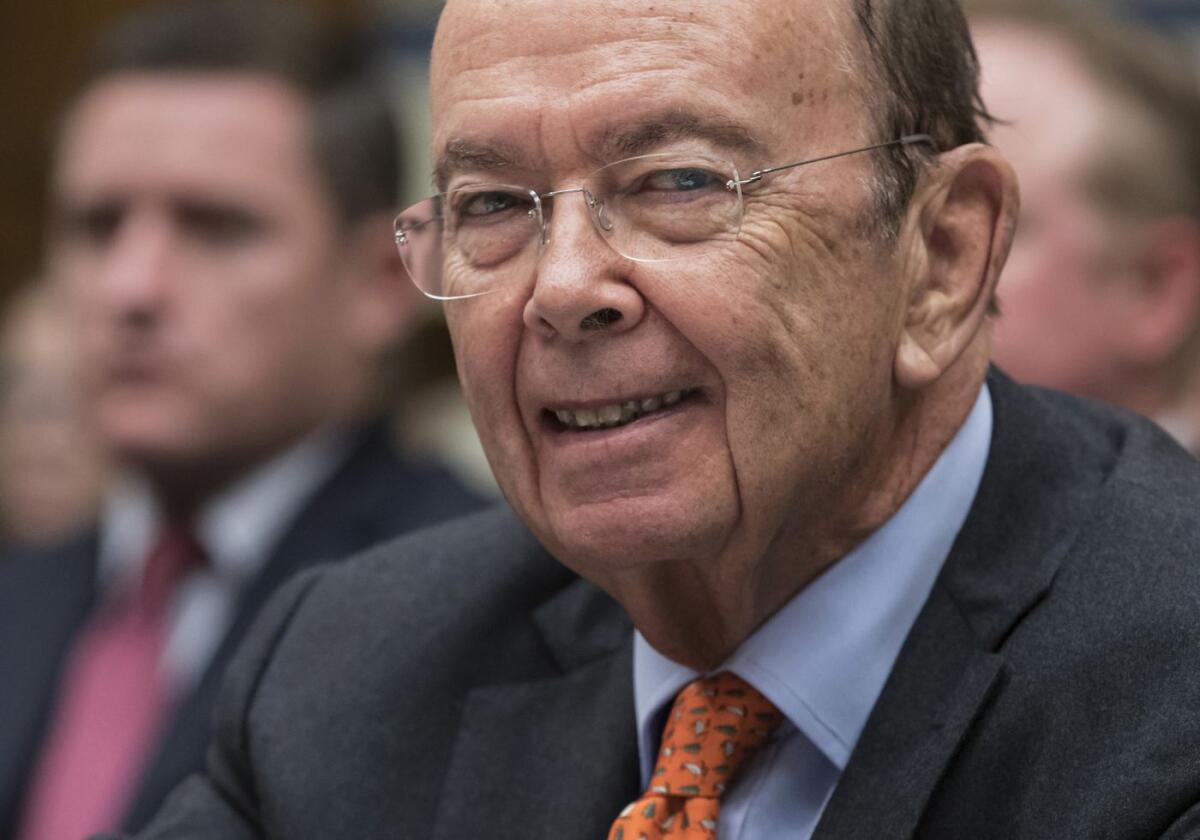
So it looks like Wilbur Ross was being, how do I put this, less than truthful when he explained to Congress earlier this year how he came to add a citizenship question to the 2020 census.
Big shrug, you say? Well, it’s true that lies from this administration come as regularly as the sunrise.
But a cabinet officer offering false or intentionally misleading information in testimony to Congress isn’t the kind of thing that ought to be shrugged off.
Especially when it comes in service of an effort to cook the census by scaring immigrants fearful of government contacts into not participating, likely leading to an undercount that could water down political representation in blue states and urban areas that are inclined to support Democratic candidates and liberal policies.
Now that the nation knows Ross wasn’t telling the truth, the question is whether Congress will do something about it.
No, wait, let me change my own bit of testimony. It’s perfectly clear that this Congress will do nothing, even though the executive branch appears to have told it a bald-faced lie. Again.
The discovery of Ross’ embrace of “alternative facts” came in lawsuits challenging the addition of the citizenship question, which Ross originally said was sought by Atty. Gen. Jeff Sessions to help the Department of Justice enforce the Voting Rights Act to protect minority voting rights.
Please, stop giggling. The laughter makes it hard to concentrate.
It turns out Ross actually came up with the question after conversations with Steve Bannon, at the time a top advisor (and prince of darkness) to Trump. Bannon told the secretary to talk with Kris Kobach, a leading vote-suppressor, about adding the question.
This isn’t the first time Ross has do-si-doed with the truth. He told a whopper to Forbes magazine when it was trying to estimate his wealth. His fortune is much smaller than this titan of capitalism wanted the world to believe. Sound familiar?
At some point, GOP leaders in Congress — you know, the folks who stand on law and order and personal responsibility — are going to have to do something about this mess. Or they may find themselves on a shrinking iceberg surrounded by liars and cheats.
- Share via
Washington got it right: This country executes the weak and, occasionally, the innocent — not the worst of the worst
The Washington State Supreme Court got it exactly right when it ruled Thursday that the state’s death penalty, as it is applied, is unconstitutional because who gets killed has more to do with race, wealth and the predilections of prosecutors than it does with how heinous the crime was. Rather than executing the so-called worst of the worst, the nation’s capital punishment states tend to execute the weakest of the weak and, occasionally, the innocent.
There’s a reason why increasing numbers of political conservatives are working to abolish the death penalty. At the risk of sounding flip, if people don’t think the government can get anything right, why in the world would they expect it to get the death penalty right?
And we’ve seen it over and over again. Since 1973, more than 160 people have been freed from death row — five here in California alone — after they were found to have been wrongly convicted. Hundreds more who were not sentenced to death have also been exonerated, often decades after the conviction. And a 2014 study published through the Proceedings of the National Academy of Sciences estimated conservatively that at least 4.1% of people sitting on America’s death rows were innocent of the murders for which they had been condemned.
Two legal experts recently published “Death in America under Color of Law: Our Long, Inglorious Experience with Capital Punishment,” an overview of the arc of state-sanctioned killing that also details at least 16 instances since 1984 in which people for whom there was credible evidence of innocence went to their deaths anyway.
So how does that tie in with the Washington court decision? Because it’s yet another inflection point in the path away from capital punishment. The Supreme Court has upheld the constitutionality of capital punishment — it is mentioned in the Constitution — but it has long struggled with whether the methods of executing people violate the 8th Amendment’s ban on cruel and unusual punishment.
One of the hurdles for the court has been the notion that the 8th Amendment, and perceptions of what is cruel and unusual, “must draw its meaning from the evolving standards of decency that mark the progress of a maturing society,” as Chief Justice Earl Warren wrote in a 1958 case that decided whether a U.S. soldier could be stripped of his citizenship for deserting (he couldn’t, the court ruled).
In the death-penalty context, the nation’s evolving sense of decency is moving away from state-sanctioned killings as punishment. Fewer states now allow it — with Washington newly added to that list. Fewer juries are imposing it. And states are conducting fewer executions, due in no small part to a move by pharmaceutical companies to ban the sale of lethal-injection drugs to prisons.
So there is a shift in our collective standard if decency when it comes to executions, a consequence largely of highly publicized botched executions and the steady parade of people being freed from death row because they were wrongly convicted. Each case is another blemish on the criminal justice system and the notion that it can reach anything near certainty that someone convicted of murder actually committed it.
A system that flawed should never be used to decide whether someone lives or dies. And conservatives, particularly, should be uneasy over the prospect of government exercising such powerful control over an individual life. It’s the ultimate in government over-reach.
- Share via
Obamacare premiums are looking good. They’d be even better if they hadn’t been sabotaged by the GOP
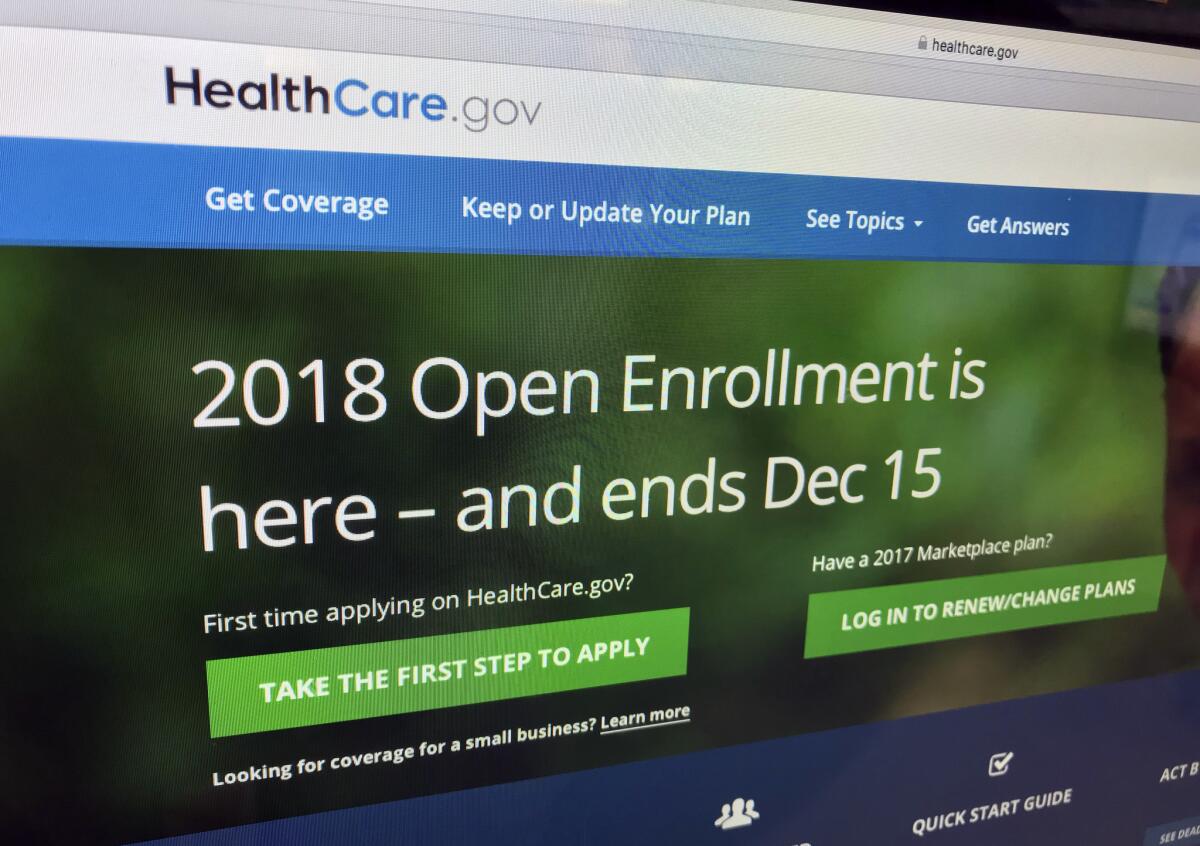
In baseball, the winning pitcher is the one who was on the mound just before his team took the lead for good — regardless of how well he pitched. So a reliever who gets hammered, turning a three-run lead into a two-run deficit, nevertheless will get credit for the win if his teammates retake the lead the next time they’re at bat.
Keep that in mind whenever President Trump talks (or writes) about health insurance premiums for Obamacare policies, which are sold to people not covered by a large employer’s group plan.
The administration announced Thursday that the average premium for the “benchmark” Obamacare plan — the second-lowest-cost plan that covers 80% of the customer’s expected medical costs — will drop 1.5% in 2019 in the 27 states where the federal government operates the marketplaces (called exchanges) for Obamacare policies. That’s the first decrease since the program’s inception in 2014. Nationwide, analysts at Avalere Health project that average premiums will go up a little more than 3% — a far smaller increase than previously seen.
That’s great, as is the news that more insurers are entering and expanding in the exchanges. According to the U.S. Centers for Medicare and Medicaid Services, the number of state exchanges with only one insurer will drop to five, half of the number this year.
Now, imagine how much better off the exchanges and the consumers who rely on them would be if not for the work of this administration and congressional Republicans.
Trump all but eliminated the marketing budget for Obamacare policies and drastically shortened the open enrollment period, steps that could only reduce the number of people signing up. He cut off reimbursements for insurers that provided federally mandated subsidies to poor Americans for their out-of-pocket costs, raising premiums for millions of people who don’t have health benefits at work. He signed a Republican tax bill that eliminated the tax penalty for those who go without insurance, giving healthy people less incentive to obtain coverage. And he’s issued rules promoting short-term, “junk” insurance policies and association health plans, both of which could draw younger, healthier people out of the exchanges.
The cumulative effect of these moves, along with the unrelenting criticism of Obamacare, has been to hold down enrollment and leave insurers covering the least healthy, most expensive consumers who aren’t eligible for a workplace or government health plan. That’s one of the main reasons the average premium for a benchmark policy went up by 25% for 2017 and 37% for 2018.
Of course, most people shopping at the exchange didn’t feel the pain. The vast majority of enrollees are low- to moderate-income Americans who qualify for federal subsidies that shield them from premium increases. Instead, taxpayers pick up the tab.
The administration has taken a handful of steps to slow premium growth and stabilize the Obamacare market, granting several states permission to use tax dollars to subsidize their exchanges. The biggest boon to insurers, however, was consecutive years of sharp premium increases mainly on federally subsidized shoppers who felt none of the sticker shock. The higher rates enabled them to absorb the cost of covering a riskier, less healthy pool of customers.
Insurers appear to be betting that they’ll feel no significant effect from the expansion of association and “junk” health plans, neither of which have to provide the comprehensive coverage that Obamacare plans do. That means they could exclude coverage for costly prescription drugs, chronic ailments and, in the case of junk plans, the health problems applicants had before they signed up.
Make no mistake, though, the whole point of the administration’s efforts on junk policies and association health plans is to draw people out of the exchange. And the people who leave are likely to be healthy — they’re the ones willing to trade off comprehensive coverage in exchange for lower premiums — leaving the exchanges with an even sicker, riskier audience. If junk or association health plans catch on, that would only drive premiums in the exchange higher.
With this in mind, Senate Democrats sought this week to block the administration’s rule promoting junk policies, only to be defeated by GOP opposition. The proposal fell one vote short of a majority Wednesday, with all but one Republican (Susan Collins of Maine) in the “no” column.
- Share via
Here’s an idea: Let’s call climate change ‘Obama warming’ and watch Trump jump into action
My colleague Jon Healey had a good overview Wednesday on the tricky road ahead for a national carbon tax. The short version: Republicans won’t support anything with the word “tax” attached to it.
And President Trump likely won’t like a carbon tax, either, unless the proceeds flow up to his fellow one-percenters.
But the world knows Trump does like a couple of things: using his name as a brand, and having his ego stroked.
So here’s how we get to a carbon tax. We simply start calling it a “carbon plan.” And we put the president’s name in front of it: “Trump’s carbon plan,” or “Trumpcar” for short.
Then we find a way to make him think charging for carbon emissions was his idea all along, an emanation of the self-described “very, very large brain” (sperm whales have large brains, too) that, according to the president, China respects. This is the same China that Trump believes cooked up climate change as a hoax, so citing China’s view of his brain leads us into a bit of cranial dissonance, but we’re used to that.
Come to think of it, this branding thing could be an effective grand strategy for dealing with Trump. Just put his name on everything that would help the nation, and put Barack Obama’s name on everything that hurts the country and needs to stop.
So if we all start calling the massive tax cut and giveaway to corporations and the wealthy that Trump signed last year “the Obama cut,” we could probably get him to insist Congress rescind it.
We could make some necessary tweaks to the Affordable Care Act, or Obamacare, to make it better, and call it Trumpcare. He’d sign that bill in a heartbeat.
And global warming? Call it Obama warming and Trump will lead the international effort to combat it.
And while we’re at it, let’s start arguing that only an Obama would run for a second term.
Yeah, that’s the ticket.
- Share via
The UK has its own ‘gay wedding cake’ case

Remember the “gay wedding cake” case decided by the U.S. Supreme Court earlier this year?
Officially known as Masterpiece Cakeshop vs. Colorado Civil Rights Commission, the case involved Jack Phillips, a Christian baker in Colorado who refused to “create” a cake for the wedding celebration of a gay couple and found himself the target of a complaint that he had engaged in discrimination on the basis of sexual orientation.
By a 7-2 vote, the court ruled in favor of Phillips. But the justices punted on what seemed for a while to be the key issue in the case: whether requiring Phillips to bake a cake for Charlie Craig and Dave Mullins would have forced him to engage in “compelled speech” in violation of the 1st Amendment.
Instead, the court held that some members of the Colorado Civil Rights Commission who found that Phillips had engaged in discrimination had displayed “a clear and impermissible hostility toward the sincere religious beliefs that motivated his objection.”
But now the Supreme Court has ruled on a request for a cake with a clear pro-gay-marriage message — only it’s not the U.S. Supreme Court.
On Wednesday, the five members of the Supreme Court of the United Kingdom unanimously ruled in favor of a Christian baker in Belfast, Northern Ireland, who refused to bake a cake for a gay-rights event. The customer, Gareth Lee, had asked for a cake that would be decorated with images of Bert and Ernie, the logo of a group called QueerSpace and the message “Support Gay Marriage.”
Writing for the British court, Lady Hale said: “The bakers could not refuse to supply their goods to Mr. Lee because he was a gay man or supported gay marriage, but that is quite different from obliging them to supply a cake iced with a message with which they profoundly disagreed.”
The contrast with the Jack Phillips case is stark. One of the reasons the U.S Supreme Court may have decided to finesse the compelled-speech issue in that case is that it wasn’t clear whether Phillips would have been speaking — or how loudly — by baking a cake for the gay couple.
Phillips had insisted that his job was to use his artistic skills to make “custom-designed” wedding cakes, which suggests a distinctive personal message. But the court noted that Craig and Mullins left Phillips’ shop without mentioning the design they were interested in (let alone a particular inscription in icing).
If the wedding cake Phillips would have “created” for a gay couple was indistinguishable from the one he would have supplied a heterosexual couple, the “compelled speech” argument would have been a reach. By contrast, the baker in Belfast was clearly being asked to use his confectionary skills to send a message.
The British court obviously relied on different legal authorities than the ones that guide the U.S. Supreme Court. Nevertheless, there is a certain amount of cross-pollination between the American and British legal systems. Hale cited several of the opinions in Masterpiece Cakeshop, suggesting that even some of the U.S. court’s liberal justices might see things her way in a case similar to the one before the British court.
So it wouldn’t be outlandish to have a U.S. Supreme Court justice refer to Lee vs. Ashers Baking Co. in a future “gay wedding cake” case on this side of the water.
- Share via
Exxon came up with a climate change response that Republicans should love. They probably won’t

The carbon tax proposal that Exxon Mobil is backing is the only one that has a prayer of becoming a reality in the United States. I’m not saying it’s likely to be enacted anytime soon, I’m just saying it’s a tax increase designed with some political savvy.
On Monday the giant oil and gas company announced that it would contribute $1 million over the next two years to Americans for Carbon Dividends, a nonprofit group lobbying for a gradually rising federal tax on carbon. That tax revenue would be returned to the public in the form of monthly checks. The group is led by two former U.S. senators, Trent Lott (R-Miss.) and John Breaux (D-La.), known for their friendliness to the energy industry, and its plan was written by two luminaries from previous Republican administrations, James A. Baker III and George P. Shultz.
The main argument in favor of carbon taxes is that increasing the price of carbon would provide a powerful incentive for people to use less fossil fuel and reduce greenhouse gas emissions. In other words, it harnesses market forces to combat climate change, rather than imposing regulations to dictate reductions in carbon use.
The Baker-Shultz plan also tries to overcome the Grover Norquist problem — the backlash against Republicans who vote for any new taxes — by calling for a tax that’s revenue neutral. The government would collect the money, then return every penny of it to the public.
But if the tax is simply refunded, you ask, how would that encourage people to cut their carbon use? Because everyone would receive the same rebate — an amount equal to the statewide average in carbon taxes paid — which means that people who use less than the average amount of fossil fuels would come out ahead. That’s a powerful incentive to take mass transit whenever possible, say, or to switch to an electric car.
That’s another example of how a carbon tax could put market forces to work in the fight against climate change, which should increase its appeal among Republicans in Congress. But here’s the most obvious problem for proponents: If policymakers don’t think greenhouse gas emissions are a problem, they won’t see any reason to throw sand in the gears of the U.S. economy by making fossil fuels considerably more expensive.
The Trump administration falls into the latter category, and its actions and rhetoric on the topic may be increasing Republican skepticism about climate change. A Gallup poll in March showed that more Republicans in 2018 felt that the media were overstating the risks of climate change than in the previous year. The same poll found that only 42% believed that “most scientists believe global warming is occurring.” That’s jarring; even if you don’t agree with the scientific consensus on this issue, you have to concede that most scientists do, in fact, say global warming is real.
Reports like the latest one from the Intergovernmental Panel on Climate Change suggest we are at a crucial moment in the fight to slow global warming, with horrific consequences almost guaranteed to ensue if we don’t step up our efforts. Raising the price of carbon may be the most effective weapon in that battle, and the tax-and-dividend plan seems like the most politically feasible. But it won’t stand a chance if the administration and Congress continue to deny that there’s a problem to be solved.
- Share via
John Cox has the real estate experience to help California’s housing crisis. Too bad he doesn’t have any ideas
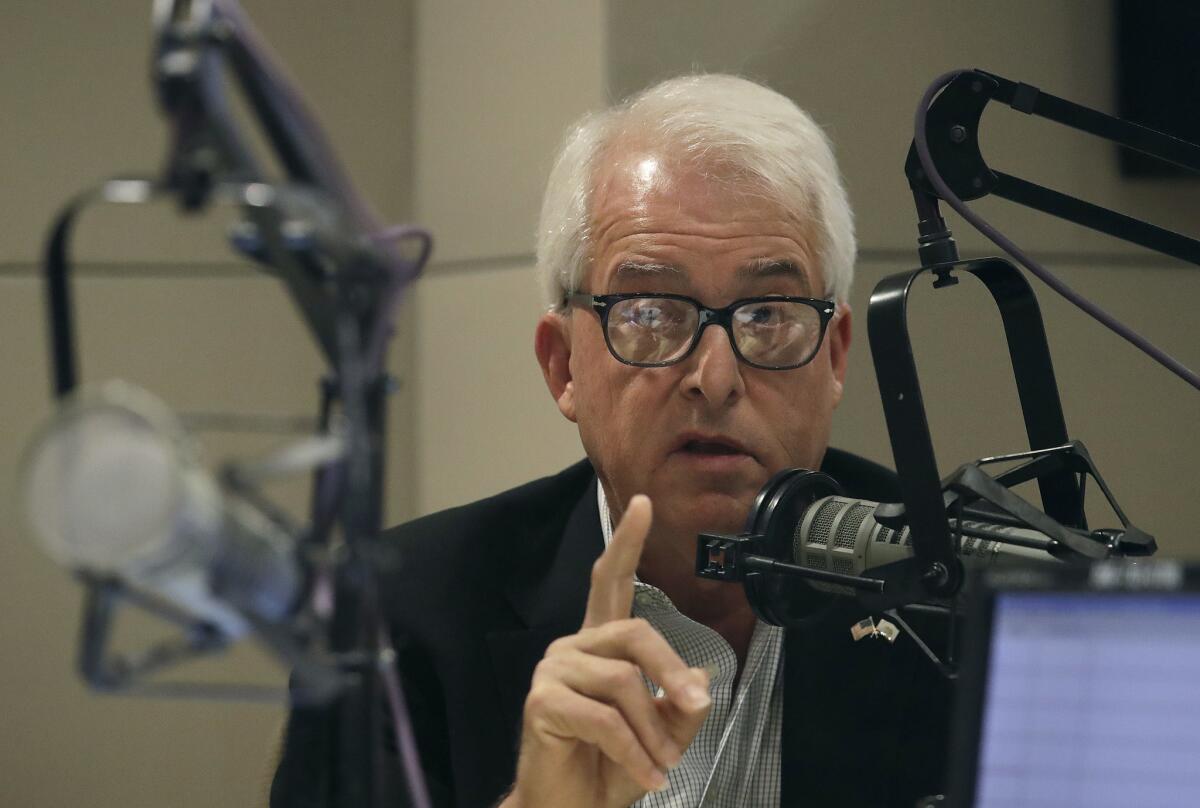
It’s no surprise that California’s insanely high housing costs were the first topic that gubernatorial candidates Gavin Newsom and John Cox tackled during their one and only debate Monday.
What is surprising – and frustrating – is that Cox actually has expertise in the real estate development business and should be able to offer some practical ideas for lowering the cost of new construction. Instead, his answers to questions about the state’s housing affordability crisis were vague pronouncements rather than substantive plans.
“I build apartments for a living,” Cox said during the debate. Cox is president of Equity Property Management, which has developed and manages apartment buildings in the Midwest; his opponent, Lt. Gov. Gavin Newsom, has a long track record in public office. That gives Cox a pretty good vantage point to critique California’s home building regulations.
“I can build apartments in other states that I operate in for a fourth or a fifth of what they cost to build in California. The reason is red tape, taxes, lawsuits, approval processes that take forever,” Cox continued.
OK, he raises some legitimate issues, well documented by the Legislative Analyst’s Office. Builders do face higher costs in California than in other states. Most of the red tape, taxes (and fees) and approval processes that Cox complains about are the result of local land-use policies that add time and expense to home construction.
Would Cox support limiting local government’s ability to stop or slow housing development? Nope. Cox said locals should have the power over land-use decisions.
So, what would he do instead?
“One of things I would do is reform CEQA, which has been turned into an effort by trial lawyers to sue competitors and stop development and that is limiting the supply of housing,” Cox said during the debate.
The California Environmental Quality Act has been blamed for slowing construction. Homeowners and other groups have used CEQA lawsuits to stop construction or shrink the size of apartment complexes in the middle of cities. While lawmakers like to pass measures exempting football stadiums and basketball arenas from CEQA, they have been unwilling to adopt more significant changes that would make it easier to build housing.
So what changes would Cox make in CEQA? He didn’t give a lot of details during the discussion. Sure, it’s hard to get into specifics during a fast-paced debate, but Cox’s website is equally devoid of details.
His website links to his plan for reforming CEQA, but the plan is nothing more than a vague promise to “replace the sledgehammer of the California Environmental Quality Act with a greatly streamlined set of sensible reforms.” What are those sensible reforms? There’s no mention of what they might be.
With CEQA reform, the devil is in the details. While many interest groups, from city governments to environmentalists to businesses, concede the need to make it easier to build housing and transit systems, few want to give up the power that CEQA gives them.
Cox could use his company’s experience building apartments in Indiana to compare and contrast that state’s housing policies to the ones here. What red tape does California layer on housing construction that Indiana doesn’t? What taxes? California cities, for example, impose hefty development fees to offset the impact of the new housing or pay for public services. Are those fees part of the problem? Are public attitudes toward housing development different in the Midwest?
The point is, Cox is uniquely positioned to use his industry expertise to talk about how other states handle housing development. He could spur a conversation about what Californians need to do — and what they’d be willing to give up — in order to get more affordable housing.
But he’s not offered detailed proposals or anything beyond boilerplate denouncements of special interests. And that’s a missed opportunity for Cox and for California.
- Share via
Both parties are weaponizing the Kavanaugh fiasco. Will independent voters get sick of it and stay home?
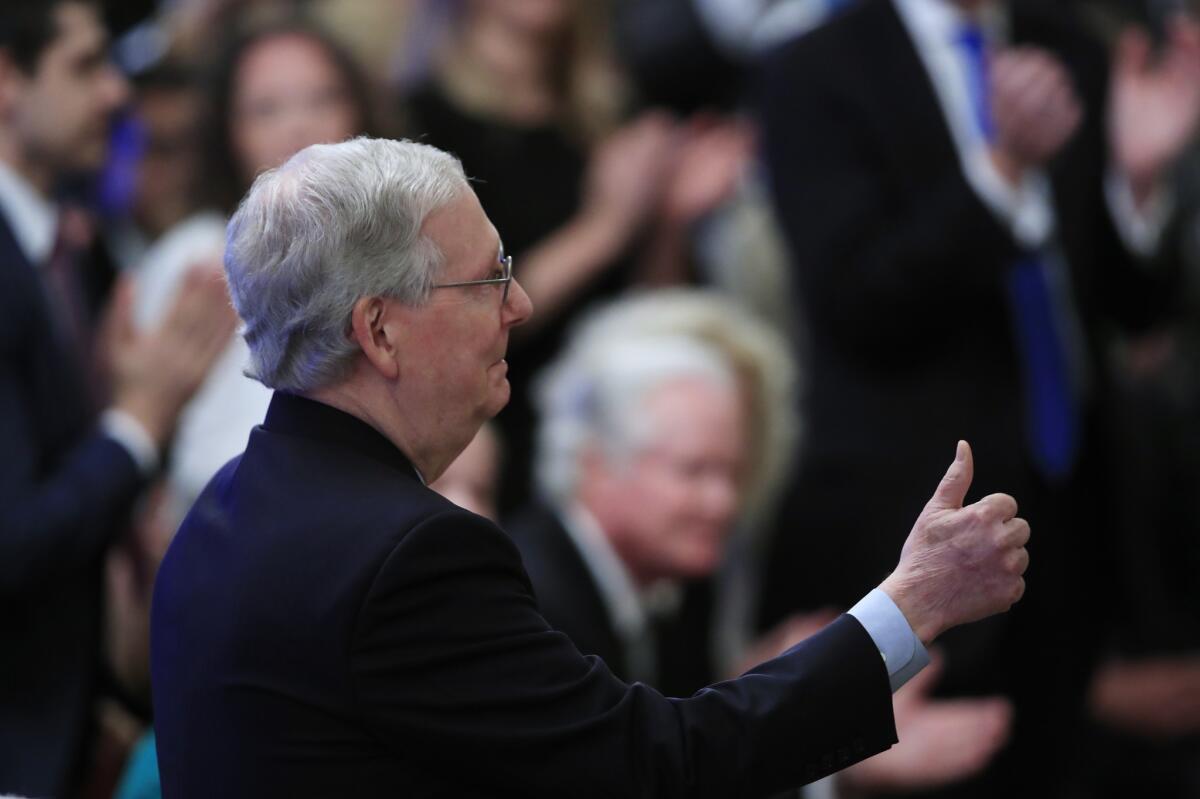
As Republicans bask in the glow of the Brett Kavanaugh confirmation, right-of-center pundits are coalescing around the view that Kavanaugh rescued his nomination by, as Matt Damon put it on “Saturday Night Live,” starting at an 11 and taking it to about a 15 real quick. The point was to cast Kavanaugh as a victim too — and someone who would forcefully defend his integrity.
I don’t buy that.
Another bit of conventional wisdom emerging from the right is that Democrats were their own worst enemies in the Kavanaugh fight, and they’re only hurting themselves more now.
I do buy that, kinda sorta.
As I noted in shortly before Kavanaugh was nominated, the procedural deck was stacked in favor of confirmation as soon as the Senate neutered the filibuster on Supreme Court nominations in 2017 (to overcome Democrats’ opposition to Neil M. Gorsuch). As long as Republicans stayed united behind the nominee, there was nothing Democrats could do to stop Kavanaugh from ascending to the highest court in the land.
Kavanaugh’s record as an appellate judge was solidly in the conservative mainstream, so his only real challenge was to reassure the two Senate Republicans who seem to care about abortion rights — Maine’s Susan Collins and Alaska’s Lisa Murkowski — that he wasn’t hell-bent to repeal Roe vs. Wade. Even then, there was a chance Kavanaugh could pick up a handful of votes from Senate Democrats representing red or swing states.
Stuck behind the 8 ball, Kavanaugh’s opponents had only one hope: that they could quickly dig up something about the judge that would disqualify him. And then, voila — someone leaked the existence of Christine Blasey Ford’s letter to Sen. Dianne Feinstein (D-Calif.) accusing Kavanaugh of sexually assaulting her when they were teens enrolled in private schools near the nation’s capital. Suddenly, Kavanaugh’s confirmation didn’t seem so certain.
Here’s where the GOP “fight back” notion comes in. Under this thinking, Kavanaugh saved himself by forcefully denouncing the attacks, shifting the focus from his behavior as a teen to the Democrats’ tactics.
The judge’s emotional, hard-to-watch defense of his own reputation may well have allowed him to assume the victim’s mantle in the court of public opinion. But he squandered some of the sympathy he earned by unleashing an unprecedented partisan attack, accusing Democrats on the committee of conspiring to defeat him out of resentment for President Trump’s win in 2016 and Kavanaugh’s own work investigating President Clinton as part of independent counsel Ken Starr’s team in the 1990s. This battle was never about either of those things — it was always about the threat posed to abortion rights, gay marriage and other court rulings prized by Democrats.
Kavanaugh’s attack-dog performance unsettled some of his supporters and gave Democrats an angle that had nothing to do with the disputed allegations of sexual misconduct. (It also helped persuade the L.A. Times’ editorial board to oppose the judge’s confirmation.) What saved the nomination was the GOP unifying around the position that Republicans would have taken even without Kavanaugh’s histrionics: Decades-old, uncorroborated allegations, they argued, are insufficient reason to reject an otherwise well-qualified nominee.
The argument was buttressed by the FBI’s quick and limited investigation into the allegations leveled by Ford and one of Kavanaugh’s fellow students at Yale University, Deborah Ramirez. And the GOP’s appeal to fairness gained traction as the allegations against Kavanaugh grew more extreme and attenuated from his fitness for the bench.
The whole ugly spectacle isn’t likely to fade from the public’s consciousness anytime soon, and neither side appears ready to let it go. Republicans are trying to motivate voters by touting some Democrats’ plans to investigate and potentially impeach Kavanaugh should they gain control of the House next year; Democrats, meanwhile, are hoping to keep the fires of resentment burning over the elevation of a man accused of sexual assault.
In other words, both sides plan to keep reminding people about the worst aspects of this whole episode. And Democrats’ inability to grasp the long-term implications of their threats — I mean, if they impeach Kavanaugh in the House, they’d still have to persuade the Senate to convict him — plays right into the GOP’s hands here, feeding the caricature of Democrats as radicals.
Whether this works to the Republicans’ advantage, though, depends on who shows up to vote in November. Will Democrats’ anger at getting rolled drive more voters to the polls than Republicans’ fear of Nancy Pelosi with a gavel? At least as important, will voters in the middle get so sick of no-holds-barred politics that they stay home, or will they hold one of the two parties responsible?
For what they’re worth, “generic ballot” polls — surveys that ask registered voters whether they would vote for a Democrat or a Republican to represent them if the election were held that day — have shown a marked preference for Democrats throughout the past year, and that preference ticked up a bit in recent days. CNN’s latest poll, which was taken in the days before and after the Senate’s vote on Kavanaugh, showed a yawning gap among women voters.
That gap isn’t lost on either party. And it’s another reason Democrats won’t stop playing the Kavanaugh card.
- Share via
Trust us, Melania, it’s for the best we focus on your wardrobe

“I wish people would focus on what I do, not what I wear,” Melania Trump told a gaggle of reporters on Saturday, who had gathered in Giza, Egypt, to chronicle her blitz through Africa.
What she’d worn the day before, and what she was referring to, was a pith helmet. Whether planting trees in pale pink stiletto heels, sporting her infamous “I Really Don’t Care, Do U?” Zara jacket to visit children separated from their parents at the border, or tooling around in a 19th century colonial administrator hat, Melania’s sartorial choices have been terribly memorable.
Can’t a woman vogue around the pyramids in a linen suit without being personally victimized by the sexist media?
Never mind that these were all choices — the pith helmet doesn’t strap itself on, if you know what I’m saying — that could have been avoided by wearing something normal like, eh, I don’t know, a khaki dress or a coat that didn’t say “Talk About Me, Please For the Love of God, Talk About Me” on it. So as to what she did…
On her first solo trip abroad, Trump said she was going to “take the message of my Be Best campaign to many of the countries, and children, throughout Africa. Whether it is education, drug addiction, hunger, online safety or bullying, poverty or disease, it is too often children who are hit first, and hardest, across the globe.”
It’s not clear what the Be Best campaign, launched in May, does, or is intended to do. Initially, it was framed as an anti-cyber-bullying initiative, the language of which was cribbed from an Obama-era booklet. Now, it’s apparently about addressing education, drug addiction, hunger, online safety or bullying, poverty, and disease, especially as it relates to children, not just in the United States but also “throughout” Africa (or at least in the four countries she visited last week).
She held hands. She kissed babies. She did some of the usual White House duties, laying a wreath at a slave port in Ghana, visiting a hospital and providing school supplies to some kids. She played with elephants. She saw historic sights. She gave away Be Best tote bags. She met with government officials.
None of this is damning in and of itself. It’s just the age-old “You get a pencil! You get a pencil! I get a safari!” form of foreign aid that stands in for systemic change. It becomes damning against the backdrop of her husband looking to gut PEPFAR, a comprehensive HIV program started by the Bush administration. He has twice attempted to cut USAID funding by 33%. And while only two African countries are affected by the Muslim ban, nearly a third of the world’s Muslim population lives in what her husband so memorably described as the continent’s “shithole countries.”
“I’m so proud of the work this administration is doing through USAID and others,” she said before she left. Of course, she can have her own views; she said as much before the Giza photo shoot. But she can’t pretend that her husband’s policies support her professed intentions.
I’m glad Melania got to see the pyramids; they’re spectacular. Happy to have helped pay for it. But at this point, when it comes to whatever else she’s up to with Be Best, the campaign to end all forms of human suffering in all continents one bewildering press conference and one airdropped pencil at a time, I really don’t care. Do u?
Melissa Batchelor Warnke is a contributing writer to Opinion. Follow her on Twitter @velvetmelvis.
- Share via
Taylor Swift just proved she’s not all about the cheddar
Pop megastar Taylor Swift disrupted the space-time continuum over the weekend by endorsing a Democrat in the race for an open seat on the U.S. Senate in her home state of Tennessee.
This was viewed in some circles as cataclysmic (and in others as overdue) because, like so many contemporary pop hit makers, Swift has kept silent on many of the burning issues of our day. That may be a smart way to hold onto a fan base that crosses geographic ideological lines (although it skews young and female); the oft-cited cautionary tale here is that of the Dixie Chicks, whose criticism of President George W. Bush led many country radio stations to drop them while they were hot. But it also feeds the “shut up and play” mentality toward celebrities — whether it be music, sports or entertainment — that denies them the right to be actual humans with opinions that might just conflict with their fans’ view of the world.
But I digress. What struck me about Swift weighing in was that it wasn’t an endorsement of Democrat Phil Bredesen — a guy with a substantial track record, having served eight years as the state’s governor. Instead, it was a repudiation of Republican Rep. Marsha Blackburn, one of the music industry’s biggest and most reliable allies in Congress.
Just listen to Blackburn talk about the Music Modernization Act earlier this year on Twitter:
Talk about red state voters acting contrary to their own pocketbooks.
But Blackburn is so much more than a water-carrier for music-industry copyright holders. She’s been a leader in the GOP’s efforts against Planned Parenthood, abortion rights and fetal tissue research. Swift did not mention those issues, which are divisive; instead, she focused on Blackburn’s views that are increasingly out of the mainstream: her opposition to the bipartisan Violence Against Women Act and to LGBTQ rights, including gay marriage.
It’s not exactly a profile in courage for someone in the entertainment industry to say the sorts of things Swift did in her Instagram post (“I believe in the fight for LGBTQ rights, and that any form of discrimination based on sexual orientation or gender is WRONG. I believe that the systemic racism we still see in this country towards people of color is terrifying, sickening and prevalent.”). That’s the stuff of the typical Oscar acceptance speech. And despite her country music roots, Swift is a genre-free pop star now, as deep in the entertainment-industry mainstream as one can be.
Yet in training her fire on a champion of her industry’s priorities, Swift showed that she’s not all about the cheddar. And unlike Kanye West’s support for President Trump, she doesn’t appear to be doing this just to be controversial; that’s his stock in trade, not hers. Nor does her post help her sell tickets (she’s on the other side of the Pacific Ocean at the moment) or push a new album (her next one isn’t expected until late 2019).
In other words, she has more to lose from this endorsement than she has to gain. No matter how you feel about Blackburn, Bredesen or politics intruding on your pop music, take a moment to appreciate Swift’s willingness to put her earnings where her mouth is.
- Share via
The world faces catastrophe without drastic action on global warming. Do we have the will to fix it?

The warning couldn’t be any more clear and direct: Without near-immediate action, the world will fail to limit global warming to 1.5 degrees Celsius above pre-industrial levels, according to a new and highly anticipated report by the Intergovernmental Panel on Climate Change. And the chances of the human race actually coming together to address the problem are not very good, the report says.
The result: A radically different environment, with rising seas, species disappearing, food chains in chaos and human migration and competition for resources leading to political instability. The poorest nations and the lowest-lying countries will suffer the most, but there will be plenty of impact to go around from bigger swings in extreme weather (more and stronger hurricanes), more extreme drought and more extreme flooding, depending on where people live.
The temperature rise can be combatted, if political and industry leaders show the will. The IPCC says the rise can be capped at 1.5 C (less than 3 degrees in Fahrenheit) if global carbon pollution is cut 45% before 2030 (in 12 years), and reaches zero emissions by 2050. As the Guardian reports, “This would require carbon prices that are three to four times higher than for a 2 C target (set in the 2015 Paris agreement). But the costs of doing nothing would be far higher.”
Global governments have the information. What they do with it will determine how much more damage we do to the planet, and to ourselves.
“We have presented governments with pretty hard choices. We have pointed out the enormous benefits of keeping to 1.5 C, and also the unprecedented shift in energy systems and transport that would be needed to achieve that,” Jim Skea, a co-chair of the working group on mitigation, said. “We show it can be done within laws of physics and chemistry. Then the final tick box is political will. We cannot answer that. Only our audience can — and that is the governments that receive it.”
The big question for Americans is whether anyone in the Trump administration will even bother to read the report. As the Times editorial board noted late last month based on early news coverage of the report’s contents:
“Even the Trump administration, which wants to burn fossil fuels with an arsonist’s glee, has acknowledged the impacts of climate change in official reports, though it defies and occasionally denies the science of climate change in formal policies and statements. Remember, President Trump wants to withdraw the U.S. from the Paris agreement, which would make us the only — only — country in the world to not be a part of it. Yet a pending draft report from the National Highway Traffic Safety Administration defending Trump’s desire to freeze fuel efficiency standards for cars and light trucks predicts that global temperatures will rise by 4 degrees Celsius over pre-industrial levels by the end of the century. Incongruously, the report argues that since the world is baking anyway, higher emissions from cars and light trucks won’t make much difference. And the Pentagon recognizes that rising seas threaten military bases, particularly naval installations, around the globe. But the administration seeks to make the problems worse rather than take steps to combat them.
“Humanity is spinning pell-mell toward self-inflicted disaster, and the largest economy in the world — the country with the second highest industrial output — has official policies to ignore it. Indeed, the U.S. plans to add to the problem for the sake of short-term energy sector financial gains. Whether Trump’s policies are bred of ignorance or cynicism, they push the nation — and the planet — into ever-more dangerous territory.”
- Share via
For sexual assault survivors, the Kavanaugh confirmation is a hell made of ice, not fire
Hell — its contours, qualities and contested existence — is an enduring source of fascination for many of us mortals. Saint Augustine, the fourth-century bishop and philosopher, wrote that “hell, which is also called a lake of fire and brimstone, will be material fire.” A thousand years later, poet Dante Alighieri wrote the Inferno, in which his narrator travels through nine concentric circles of Hell. In this depiction, however, it grows ever colder as they approach the core, where they find Satan trapped in a block of ice up to his waist. Several centuries after that, Robert Frost considered both fire and ice as a means of torture; “either would suffice,” he concluded. (The Bible, for its part, suggests neither.)
During the Kavanaugh hearings this past week, which have been, for many of us, unbearable, I’ve thought of Frost, Alighieri and Augustine.
Fire requires stoking; to establish eternal flame, wood, gas or brush must be continually available for consumption. Ice is less high-maintenance; the climate just needs to be cold year-round. You can, as 1990s telemarketers enthused, set it and forget it. This week, I learned: it’s ice, not fire, that the GOP is after.
- Share via
Don’t buy Kavanaugh’s last-minute semi-apology
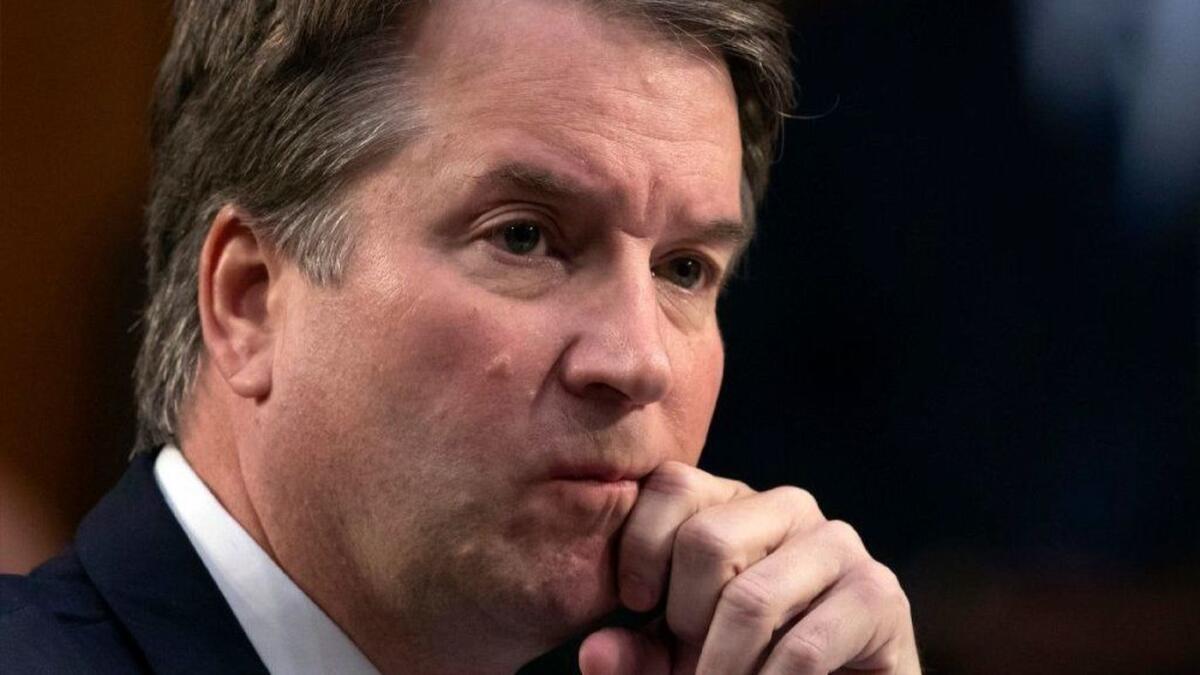
Many who oppose the confirmation of Judge Brett Kavanaugh for a seat on the Supreme Court — including the editorial board of the Los Angeles Times — have cited his emotional, and partisan, comments last week when he testified before the Senate Judiciary Committee to rebut allegations of sexual abuse.
Kavanaugh railed against a ”calculated and orchestrated political hit, fueled with apparent pent-up anger about President Trump and the 2016 election” and speculated that he was the victim of “revenge on behalf of the Clintons.” In what sounded like a threat, he warned: “What goes around comes around.”
Kavanaugh’s angry partisanship prompted 2,400 law professors to oppose his confirmation in a letter that said the nominee “displayed a lack of judicial temperament that would be disqualifying for any court, and certainly for elevation to the highest court of this land.”
On Thursday night, on the eve of a procedural vote on his nomination, Kavanaugh responded to the criticism with an opinion column in the Wall Street Journal titled: “I Am an Independent, Impartial Judge.”
Not exactly apologizing, Kavanaugh wrote:
“I was very emotional last Thursday, more so than I have ever been. I might have been too emotional at times. I know that my tone was sharp, and I said a few things I should not have said. I hope everyone can understand that I was there as a son, husband and dad. I testified with five people foremost in my mind: my mom, my dad, my wife, and most of all my daughters.”
He then asked the public — and undecided senators — essentially to expunge this episode:
“Going forward, you can count on me to be the same kind of judge and person I have been for my entire 28-year legal career: hardworking, even-keeled, open-minded, independent and dedicated to the Constitution and the public good.”
There are a couple of problems with Kavanaugh’s almost-apology.
First, although he said he was testifying as “a son, husband and dad,” he was also a sitting judge and a candidate for the Supreme Court when he attacked Democrats in the Senate, the Clintons and “the left.”
Second, judicial ethics involve appearances as well as interior motives. If Kavanaugh were confirmed and ruled in what could be perceived as a partisan way, his over-the-top comments to the Judiciary Committee will be remembered regardless of his insistence that he was speaking as a “son, husband and dad.”
If Kavanaugh’s purpose in writing this article was to convince a few wavering senators, it might have been successful. On Friday morning the Senate voted 51-49 to advance his nomination, setting the stage for a final vote this weekend. Skeptics among the general public will be a harder sell.
- Share via
The Kavanaugh nomination has left no one unsullied

As the Brett Kavanaugh melodrama nears its conclusion, a few lines from Echo and the Bunnymen’s “The Cutter” come to mind:
Am I the worthy cross?
Will I still be soiled
When the dirt is off?
The Senate vote this morning to curtail debate on Kavanaugh’s nomination all but guarantees that the judge will be elevated to the nation’s highest court. But the incredibly ugly path taken to get to this point has not only put a cloud over Kavanaugh that may never lift, it’s damaged the Senate’s already weak reputation and cast the Supreme Court in more vividly political hues. There’s plenty of blame to go around, so let’s start assigning it.
President Trump gets credit for picking a nominee who was well qualified, respected by his peers and a relatively mainstream legal thinker, albeit clearly conservative. And he was remarkably restrained — even presidential, go figure — in his comments in public and on Twitter. Then suddenly he went back to being Dennis the Menace, mocking Christine Blasey Ford at a rally and reminding everyone in this country that their president had been accused of sexual misconduct too.
Senate Judiciary Committee Chairman Charles Grassley (R-Iowa) and Senate Majority Leader Mitch McConnell (R-Ky.) moved Kavanaugh’s nomination at a feverish pace, refusing to wait even for the National Archives to supply all the pertinent documents from Kavanaugh’s years in President George W. Bush’s administration. Their haste made it seem as if they were trying to hide something — despite the fact that Kavanaugh’s long tenure as an appellate judge provided an ample record of his approach to the law.
Sen. Dianne Feinstein could not have made a bigger mess of Ford’s allegations had she tried. Given the stakes here, the moment Ford’s letter arrived in July, Feinstein should have explained to her that an off-the-record allegation of sexual assault, as serious and alarming as it may be, would have zero effect on the nomination. If Ford really wanted to inform the process, she had to be willing to answer questions from the committee — potentially in private, but as a named person. And Feinstein really should have warned Ford about something everyone who works in Washington knows: No secret is safe there.
Instead, Feinstein hung on to Ford’s missive, helped her find a lawyer, and eventually forwarded her allegations to the FBI — after reporters somehow found out that Feinstein had a document from someone accusing Kavanaugh of a sex crime. At which point all hell broke loose, and the nomination became a referendum for many Americans on whether women who accuse men of sexual assault will ever be taken seriously.
Not that anyone else on the Senate Judiciary Committee, with the exception of Sens. Jeff Flake (R-Ariz.), Amy Klobuchar (D-Minn.) and Chris Coons (D-Del.), would have made the Founders proud. By deciding which way they were going to vote before Kavanaugh made his first appearance, and then sticking to their positions after Ford’s allegations went public, they eliminated any probative value the hearings might have had. It was a display of the worst aspects of our polarized Congress.
Kavanaugh can be forgiven for getting angry and feeling unfairly attacked. But unleashing his inner rage monster and spewing vitriol and threats at Democrats on the panel? That went beyond unseemly and straight into unfit-to-wear-a-robe territory. He tried to make amends with a public apology of sorts on the Wall Street Journal op-ed page Friday, but that felt as stage-managed as his extraordinary (and unjudicial) appearance on Fox News to defend his nomination.
Nor did Kavanaugh help matters during his first round before the Judiciary Committee by giving less-than-forthcoming answers to questions about important legal issues. He was fully within the nominee mainstream on that front too — since Robert Bork, would-be federal jurists have been coached to keep their cards close to their vest, particularly on hot-button issues like abortion rights. By being cagey on this front, however, nominees detract from their own credibility. And in Kavanaugh’s case, that laid the groundwork for later Democratic attacks on his candor.
The people most culpable for this mess, though, were the extreme partisans on both sides. The stop-Kavanaugh-at-all-costs Democrats clung to the fantasy that defeating this nomination would open the door to a justice more to their liking. That was never an option; elections matter, especially presidential ones. The opposition’s eagerness to find something, anything to make Kavanaugh unpalatable to the Senate’s handful of persuadable Republicans only made Republicans more determined to confirm him; it also cast doubt, deservedly or not, over the allegations by Ford and others who came forward after the hearings.
And of course the search for dirt on Kavanaugh pulled up some things that should have stayed buried, such as Julie Swetnick’s wild accusations (which she later dialed down).
On the other side, you have the likes of Ed Whelan, who publicly accused one of Kavanaugh’s prep-school classmates for Ford’s alleged assault, and Sen. Lindsey Graham, whose over-the-top attack on Feinstein and other Democrats on the Judiciary Committee set a new low for partisan rancor. They were the bellows that pumped up the flames, calculating that the more Republican voters resented the attacks on Kavanaugh, the better it would be for the judge — and for the GOP in November.
Ugh. Republicans appear certain to win this battle and put Kavanaugh on the court, where he’s expected to be a more reliable fifth vote for conservative rulings than the justice he will replace, Anthony Kennedy. Let the Supreme Court kegger jokes begin! Here’s hoping they will at some point be funny, not just painfully sad.
- Share via
Vernon Madison is too dementia-ridden to find the toilet next to his bed. Alabama still wants to execute him
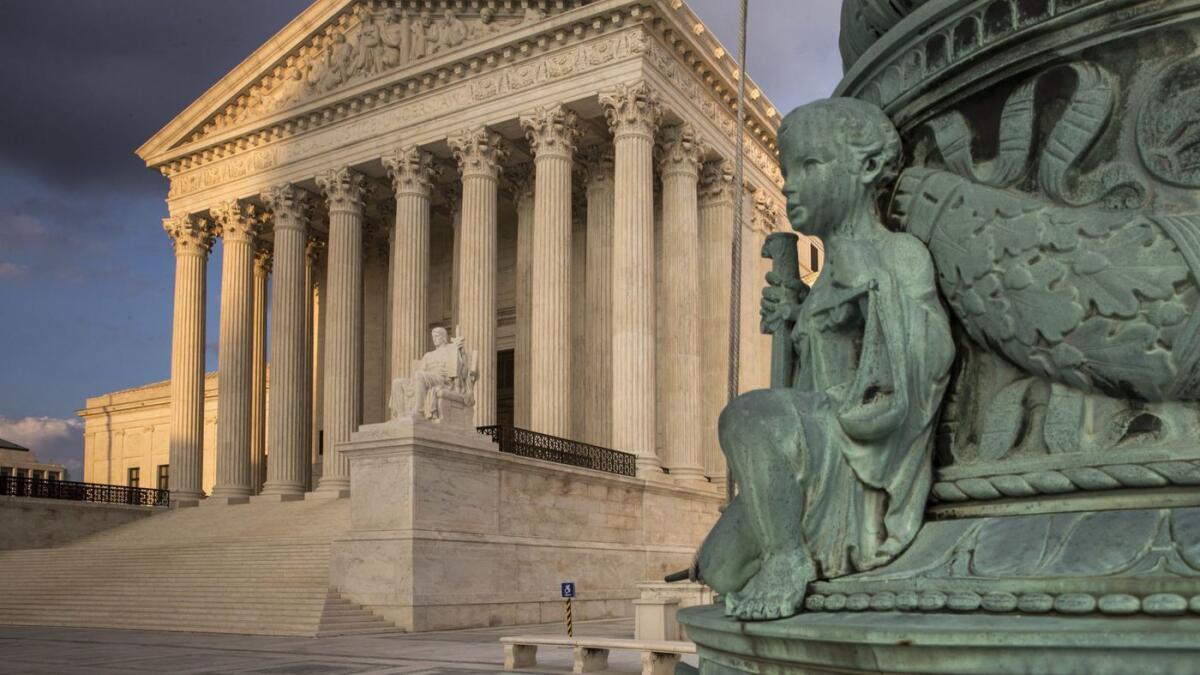
It might be hard to recognize, but there are other things going on in Washington these days besides the two-ring circus of President Trump and Brett Kavanaugh’s nomination to the Supreme Court. For instance: That very court heard oral arguments Tuesday in a death penalty case centering on whether a state can execute someone whose medical condition has left him addled and stripped of memory of the crime for which he is to be executed.
The courts have previously held that it is cruel and unusual punishment to execute someone who doesn’t have a “rational understanding” of what’s happening – generally, the insane and the psychotic. In the case of Vernon Madison, 68, that line gets blurry. When reminded, Madison knows the state of Alabama wants to execute him for the 1985 killing of a police officer. But the knowledge quickly dissipates into fog. A series of strokes have left him brain-damaged and suffering from vascular dementia — the injuries show up on MRIs — with a documented decline in IQ; he’s now incapable of remembering the crime for which he is to be killed. And 33 years of solitary confinement hasn’t helped.
The dementia has left Madison befuddled to the point that he soils himself because he can’t find the toilet next to the bed in his 5-by-8-foot cell. He wants someone to tell his mother that he has suffered strokes; she’s been dead for years. He can’t remember the alphabet past the letter G. He also plans to move to Florida.
But dementia is not psychosis or delusion. It doesn’t fall under standard legal definitions of insanity. Yet as his lawyer, Bryan Stevenson of the Equal Justice Initiative, argued, dementia has left Madison in the same place: confused, “unable to fully orient to time and place,” and with no recollection of the acts for which he is to be punished.
“The court always looks at facts and circumstances through the lens of the Constitution, through the window of the Constitution, and we have that here,” Stevenson told the court. “The 8th Amendment isn’t just a window. It’s a mirror. And what the court has said is that our norms, our values are implicated when we do things to really fragile, really vulnerable people. And what we’ve argued is that dementia in this case renders Mr. Madison frail, bewildered, vulnerable in a way that cannot be reconciled with executing him because of his incompetency.”
Alabama Deputy Atty. Gen. Thomas R. Govan Jr. argued that none of that matters because Madison, when asked, can reply that he is to be executed for a murder. And because he can articulate that, he doesn’t meet the standards for exclusion. The most telling part of Govan’s argument, though, was why the state persists in wanting to execute a sick and addled old man.
“The state would still have a strong interest in seeking retribution for a horrible crime,” he said.
There it is: Retribution. After more than three decades of mostly solitary confinement, and after a slow descent into dementia, what is to be gained now by retribution?
The death penalty is wrong in any circumstance, but it becomes even crueler — and more absurd — when the state tries to execute the infirm. Particularly when the only remaining rationale for it is vengeance.
- Share via
An FBI investigation that doesn’t interview Kavanaugh and Ford? What are Republicans thinking?
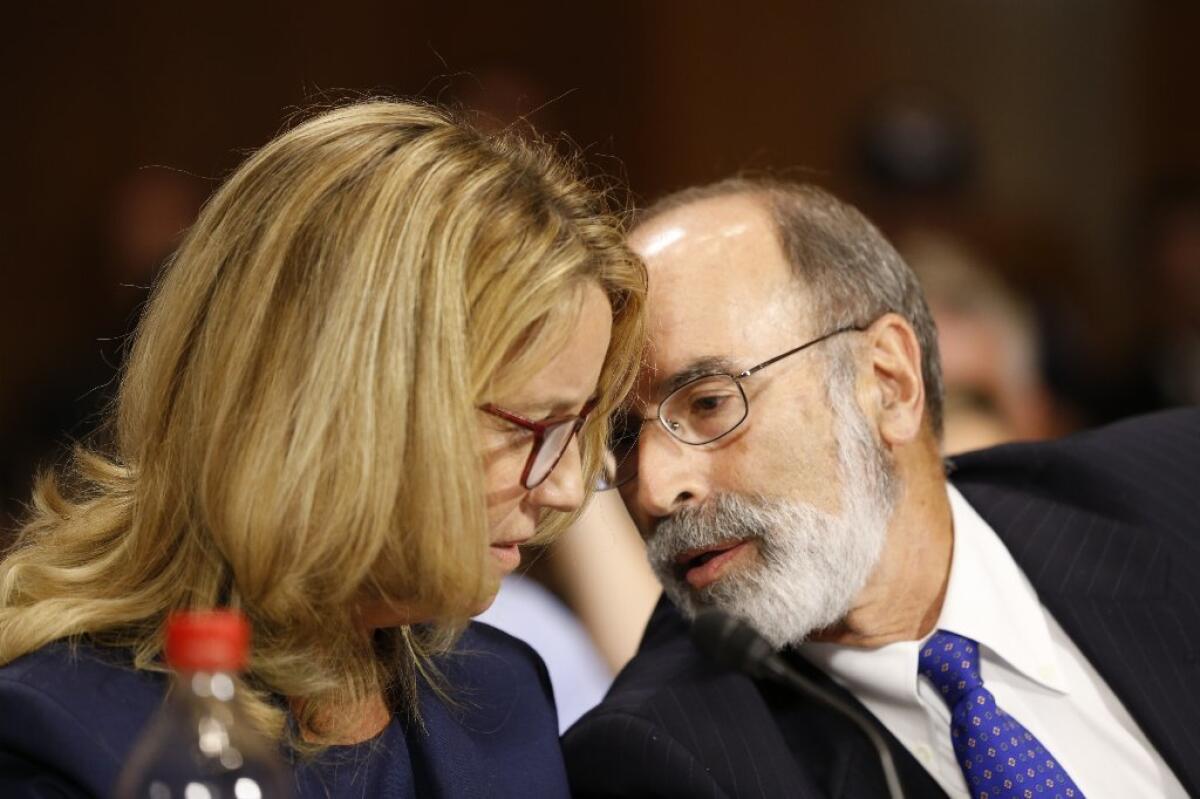
The FBI’s report on its reopened background check of Supreme Court nominee Brett Kavanaugh is expected to be turned over imminently to the White House and the Senate.
That report will lack credibility with many Americans — and some senators — if it doesn’t include interviews with the nominee and with Christine Blasey Ford, who has accused the appeals court judge of trying to force himself on her when they were teenagers, a claim he categorically denies.
The bureau reportedly has interviewed people who belonged to Kavanaugh’s high school social circle, including his friend Mark Judge, who, according to Ford, was in the room when she says Kavanaugh assaulted her. Agents also have interviewed Deborah Ramirez, who has claimed that Kavanaugh exposed himself to her at a party when they were students at Yale.
But on Tuesday two of Ford’s lawyers wrote to the director of the FBI complaining that their client hadn’t been contacted and that it was “inconceivable that the FBI could conduct a thorough investigation of Dr. Ford’s allegations without interviewing her, Judge Kavanaugh or the witnesses we have identified in our letters to you.”
At a briefing on Wednesday, White House Press Secretary Sarah Huckabee Sanders noted that Kavanaugh and Ford “were questioned in the most public way possible by the members of the Senate who ultimately have to make the determination” on Kavanaugh’s confirmation.
Even Sen. Jeff Flake (R-Ariz.), who pressed for the delay that allowed the FBI to reopen its investigation, said on Wednesday that it wouldn’t bother him if the FBI didn’t interview Ford. “We have a statement of Dr. Ford and then we have hours of testimony,” Flake told NBC News. “So, frankly, when we talked about an FBI investigation, it was to follow up leads that might corroborate her account.”
This is blinkered thinking.
It seems obvious that FBI agents would want to circle back and question Ford and Kavanaugh about information they gleaned from interviewing other witnesses. And even if talking to Ford wasn’t strictly necessary to resolve conflicting narratives, she obviously regards being able to speak to the FBI as well as the Senate Judiciary Committee as a matter of fairness.
Finally, on Wednesday Ford’s lawyers told the Judiciary Committee that she will provide materials it has requested to the FBI, including notes from a therapy session, “when she is interviewed.”
Given the partisan polarization over this nomination — evident long before Ford’s sensational accusation surfaced — an FBI report that doesn’t include interviews with the two principals in this story is sure to be denounced as incomplete. With the vote in the Senate so close, why would the White House or Senate Republican leaders want to risk such a reaction?
- Share via
The GOP isn’t the only party that’s flagging in California
The latest state voter registration numbers are out, and though the numbers bode well for democracy, they aren’t looking good for California’s Republican Party.
There are now more Californians signed up to vote than ever — 19,086,589 of them, to be exact, which is 75.81% of those eligible to vote. But the number affiliated with the Republican Party dropped by about 93,000, to a mere 24.5%, just in the last few months.
This is the latest bad news for the state’s GOP, which has been losing ground in the Golden State for many years. Its minority status is reflected in the Democrat-dominated Legislature and the state’s constitutional offices. In May, the California GOP hit the mortifying milestone of losing its second-place status to those registered with no party preference.
No gloating, Democrats. Your party may still claim the No. 1 spot, but your ranks have thinned since May as well, from 44.4% of registered voters to 43.8%, or about 89,000 fewer voters.
So what party is claiming all these new voters? The Greens? Peace and Freedom? Libertarians? None of the above. Since May, voters who chose no party designation grew by 252,000, according to numbers released Tuesday by the secretary of state.
It’s possible some portion of that gain may be attributable to the Department or Motor Vehicles’ mishandling of the motor voter registration program. The DMV admitted last month that it had improperly registered 23,000 people, and many of those errors included assigning the wrong party preference. Even so, that would not be enough to materially affect the significance of this new set of voter registration numbers.
The popularity of the “no party preference” designation has been growing for the last two decades, perhaps in reaction to the increasing partisanship in American politics. After California switched to a top-two primary system, rendering party affiliation all but unnecessary for voters in most elections, the pace of voters choosing “no party” naturally picked up.
These numbers may indicate that more people than ever are interested in voting; they are not a reliable indicator of election outcomes. Who knows which way those non-affiliated voters will swing? Most likely they will lean left, because California overwhelming elects Democrats over Republicans. And Republicans might be losing members on the roll, but they wield outsize power because they actually vote at a higher rate than Democrats and unattached voters.
So the numbers are interesting, but they don’t necessarily indicate that the party is over for the state’s political parties. They just show that a growing number of voters want to go solo.
- Share via
If we’re going to build a wall, let’s put one up between the Oval Office and Trump’s businesses
Meanwhile, back to one of the Trump administration’s original scandals: A watchdog group has updated its list of President Trump’s wide-ranging conflicts of interest, offering a depressingly thorough accounting of how he, his family and some top appointees have routinely tripped over the ethics line.
The conflicts are rooted in the nature of the Trump Organization’s businesses, which includes licensing the Trump name for development projects around the world and operating Trump-named golf courses and resorts. Every time the president visits one of his properties for business or recreation — 147 days and counting — he uses the White House to enhance his private business. You can’t buy advertising like that.
Trump announced early on that he had stepped back from decision-making at the family business and turned operations over to two of his sons, Donald Jr. and Eric. But that doesn’t redress the conflicts because Trump still derives income from the businesses, and he knows what they are because his name is plastered all over them.
In fact, there are so many conflicts that it can be numbing to try to wrap your head around them. Fortunately, the folks at the Global Anticorruption Blog recently updated its tracking of Trump’s conflicts, breaking them down into four main categories covering federal payments to Trump’s businesses, instances in which the White House has promoted Trump family brands, regulations and policies that benefit the family and top advisors, and instances in which private and foreign interests have sought political influence through business dealings.
It’s rather exhaustive. And exhausting. I count 52 separate issues, with some, such as diplomats patronizing the Trump International Hotel in Washington (the alleged emoluments violation), comprising several distinct interactions. Altogether, the list includes 75 separate entries of varying degrees of seriousness.
Some, such as public pensions fund investments into Trump-connected business, seem a bit attenuated. But overall, that are a lot of conflicts.
They include Trump staying at his own expensive properties and getting paid by the government for Secret Service rooms and other services; ordering golf tee markers with the presidential seal (it’s illegal to use the seal unless it’s for government business); making a derogatory tweet about Nordstrom’s after the high-end department store chain dropped Ivanka Trump’s fashion line (products that top advisor Kellyann Conway endorsed), and — despite the wide crackdown on visas — increasing the number of H-2B visas used by temporary foreign non-agriculture workers. The Trump Organization relies on such visas to staff Mar-a-Lago and other Trump properties.
Then there’s the rollback of environmental rules protecting water supplies, which cut costs for golf courses in which Trump has a stake. And the waiver exempting Florida from Trump’s proposal to open nearly all federal waters to offshore drilling. The administration said it would exclude Florida because of its reliance on tourism. It’s not like anyone ever comes to California for the beach. Or Massachusetts. Or the Carolinas. So why Florida? To help Gov. Rick Scott, who is running for the U.S. Senate? Or did it have something to do with a certain oceanfront estate in Palm Beach that a certain high-level government official owns (cough, Mar-a-Lago)?
Of course, not all of these appear to involve a quid pro quo or direct enrichment. But they all give Americans reasonable cause to wonder whether the president is acting in the nation’s best interest or his own.
The only solution here (short of ousting the president) is for Trump to sell off the family business and place the assets in a true blind trust, one in which he cannot know what impacts his policies and decisions have on his own wealth.
Trump supporters have argued from the beginning that such a demand is asking too much of a billionaire businessman, the first such president in the nation’s history.
But it’s not asking too much that Trump follow modern-era tradition and build a wall (I mean, he really likes walls) between the Oval Office and his investments and business. It’s also not too much to ask Congress to force the issue. Getting an answer from a Congress controlled by Trump enablers, well, that’s another matter.
- Share via
Now the Trump administration is going after same-sex partners at the United Nations
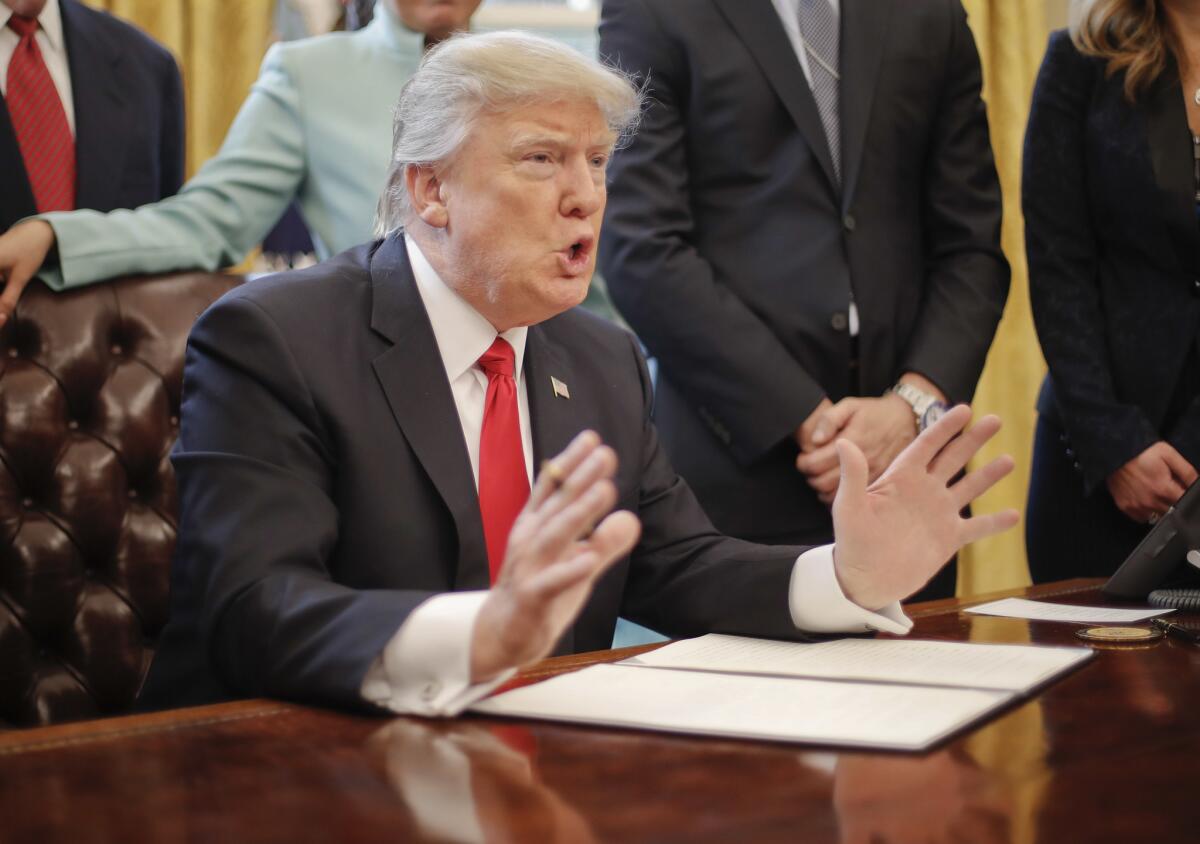
It’s shocking sometimes at how needlessly cruel this administration has been. This week, a new policy went into effect denying visas to same-sex partners of U.N. diplomats and employees unless they are married, a dangerous act for people hailing from any of the 72 countries where homosexuality is illegal — or from any of the eight countries where it is a capital offense.
The new policy, which went into effect Monday, also requires same-sex partners of diplomats and U.N. employees already in the United States to get married by the end of the year or face expulsion.
Former Obama U.N. ambassador Samantha Power got it right when she tweeted that the policy is “needlessly cruel and bigoted.”
The government framed the policy as an effort to treat same-sex couples the same as married couples. The United States does not grant visas to unmarried partners of heterosexuals, but the previous policy — recognizing the precarious position of gay couples internationally — included an exception for same-sex partners.
Only two dozen or so countries allow gay marriage. If the administration limited the new policy to just same-sex couples from countries that allow gay marriage, then the administration’s logic might be defensible. And while a noncitizen same-sex couple can legally marry in the United States, thus conforming with the new policy, doing so runs the risk of raising problems with their home country if it’s among those with harsh anti-gay laws.
So the explanation feels like a pretext for yet another anti-gay policy by the administration.
In the greater scheme of cold-hearted moves by the administration, this one is relatively minor. But its pettiness is part of the larger problem: Trump and his acolytes have been on a mission to undo just about anything with President Obama’s fingerprints on it. And the policy granting visas to same-sex couple stems from an Obama directive implemented by his secretary of State, Hillary Clinton.
There was nothing in Trump’s so-called mandate from voters that compels the administration to mess with the personal lives of gay or lesbian couples in the United States as representatives of their governments, or as employees of an international body such as the United Nations.
But the administration did it anyway. And instead of fixing a problem, it created one.
- Share via
Jerry Brown’s parting gift to California women: A seat at the table of power
Hear that tinkling? That’s the sound of the glass ceilings in corporate boardrooms shattering up and down the Golden State.
With just hours remaining before the legislative deadline on Sunday night, Gov. Jerry Brown signed Senate Bill 826 by state Sen. Hannah-Beth Jackson (D-Santa Barbara), making California the first state in the nation to require publicly traded corporations to have women on their boards of directors.
Not many, mind you, but at least one by the end of next year. About one-fourth of the large corporations headquartered in California don’t have a single female board member. By 2021, corporate boards with five directors must add at least one more woman, and larger boards must add two more or face fines and public shaming on the Secretary of State’s website.
Hear that sputtering? That’s the sound of powerful men denouncing the law as terrible, horrible and — this is amusing — discriminatory.
Women make up about half the people in the state, yet hold only 15% of the corporate board seats. What would you call that disparity? Bad luck?
There will be lawsuits, count on it. People with power don’t give it up easily. Reserving seats for women on corporate boards means fewer seats for men — and the power, prestige and pay that comes with the position. The opponents of the bill — chambers of commerce, the California Manufacturers and Technology Assn. and other business and industry groups — contend that it violates constitutional protections against gender discrimination.
I’m actually looking forward to those arguments. How will the corporate lawyers explain why it’s not fair for this law to discriminate against men, yet it’s entirely reasonable for corporations to discriminate against women? Will they rely on the old canard that there just aren’t enough capable women to go around? That will be a fun discussion, especially if the judges are women. (There’s about a 35% chance of that happening. America’s judges are overwhelmingly male, though half of law school graduates are women.)
That argument might have been plausible 50 years ago, when women really were shut out of entire professions and discouraged from higher education. But in the last half-century, universities have been churning out qualified women in every professional field. If corporations can’t find competent female directors in 2018, it’s probably because they are not trying very hard.
Brown acknowledged the law may face “fatal” legal challenges, but signed it anyway, noting in his signing message that “recent events in Washington, D.C. — and beyond — make it crystal clear that many are not getting the message.”
In any case, why not try government coercion? Things can’t get much worse.
Despite the advances women have made in the workplace, the halls of power are still largely closed to them. Men still control most of the political establishment, the government, wealth and industry. Things are changing in some areas. For example, there are more women running for public office than ever this year. But they’re not in other areas. This year, the number of woman running Fortune 500 companies dropped from a high of 6.4% (which is, obviously, not very high to begin with) to less than 5%.
How do you change this besides lots of hoping and praying? Increasing the number of women on corporate boards is one way. Studies have shown that people are more likely to hire people like themselves. If so, then all-male boards are more likely to hire nothing but male top executives.
Even if the law is struck down, and it may be, the governor has done an important thing by highlighting the gross gender disparities in corporate America even as gender power imbalance has been on stark display in the confirmation proceedings of Supreme Court nominee Brett Kavanaugh, who has been accused of sexual assault when he was a teenager. As parting gifts go, Brown can’t do better for women than giving them a seat at the table of power.
- Share via
The Justice Department sues California over its new net neutrality law. What a surprise
Moments after Gov. Jerry Brown’s office announced that he had signed a bill to restore net neutrality protections in California that the federal government abandoned, the U.S. Department of Justice sued to block the measure from going into effect. California lawmakers saw the measure (Senate Bill 822) as an important step to protect internet users in the state; the Justice Department saw it as yet another effort by the loony left state to dictate policy for the entire country.
The feds argue that the Federal Communications Commission, not the states, decides how the internet will be regulated (or not regulated). And having a uniform national policy on internet issues would indeed be a good thing. But that uniform policy should be one that preserves the status quo, protecting both consumers and the companies that offer content and services online from interference by local broadband providers such as AT&T, Spectrum and Comcast.
Last year, the FCC’s Republican majority went about as far as humanly possible in the other direction. It not only repealed a net neutrality rule the commission’s previous Democratic majority had adopted in 2015, it said the FCC had no authority to regulate broadband providers beyond requiring them to disclose accurately how well their networks perform, how much they charge and how they manage their networks. The move renounced the commission’s efforts over the previous decade to crack down on broadband providers that improperly favored some content, services or applications on their networks over others.
- Share via
Gov. Brown shuts down the party with veto of bill to push back last call to 4 a.m.
What a party pooper! Gov. Jerry Brown vetoed a bill that would have allowed Los Angeles, San Francisco and seven other cities to temporarily extend alcohol service at bars and restaurants from 2 a.m. to 4 a.m.
Senate Bill 905 was San Francisco Sen. Scott Wiener’s second attempt to loosen an 80-year-old law that requires businesses licensed for on-site liquor sales to stop serving alcohol at 2 a.m. This is earlier than other states, such as New York, Illinois and Nevada, where bars are allowed to keep pouring until 4 a.m. and later.
Wiener and others argued that a 2 a.m. last call no longer makes sense for cities with thriving music and nightlife scenes that compete for investment and tourism with the likes of New York City, Las Vegas and other late-night hot spots. It also doesn’t consider the increasing availability of taxis and ride-hailing apps, such as Lyft and Uber, that give revelers more ways to get home without driving.
The Times Editorial Board supported a similar bill last year, arguing that a city like Los Angeles shouldn’t have to shut down its bars early each night in deference to a fusty old law based on cultural practices, not research on the appropriate time to stop serving alcohol.
Law enforcement and community activists helped block that legislation amid fears that later hours would lead to more drunk driving and raucous partying.
Wiener returned this session with a narrower proposal for a five-year pilot program that would let nine cities decide whether to allow bars and restaurants in certain areas to stay open later. The cities were Los Angeles, San Francisco, Oakland, West Hollywood, Long Beach, Palm Springs, Sacramento, Coachella and Cathedral City.
The Legislature approved the bill, but Brown sided with the fusty old law.
“California’s laws regulating late-night drinking have been on the books since 1913,” he wrote in his veto message. “I believe we have enough mischief from midnight to 2 without adding two more hours of mayhem.”
Well, Gov. Brown, not everyone who goes to a bar, restaurant or club late at night engages in mischief. And you don’t need to go to a bar to create mayhem and misery.
Wiener says he will keep trying to modernize the state’s last call law. He might find a more willing governor next year. Democrat Gavin Newsom, after all, was a restaurateur and bar owner in San Francisco before entering politics.
- Share via
Congressman takes the low road with despicable, xenophobic attack ad
Voters in inland San Diego county didn’t need another reason to question Rep. Duncan Hunter’s fitness for office. The Republican from Alpine and his wife were indicted in August on charges of misusing a quarter million dollars in campaign donations for personal expenses. A poll since then shows that a lot of voters in his district think he’s guilty.
Nevertheless, Hunter gave voters another reason to reject his reelection bid on Nov. 6 with the release of a despicable campaign ad insinuating that his Democratic opponent, Ammar Campa-Najjar, is a Muslim terrorist “working to infiltrate Congress” in a “well-orchestrated plan.”
The evidence? That Campa-Najjar, who is American born and ethnically Palestinian and Mexican, changed his name from Ammar Yasser Najjar to Ammar Campa-Najjar (Campa is his Mexican mother’s maiden name) after the June primary. The ad suggests he did it to hide his familial connections. Campa-Najjar’s grandfather was one of the masterminds of the 1972 “Munich massacre,” a terrorist attack by the Palestinian Black September group on Israeli Olympic athletes.
That fact was reported long before the June primary, however. More likely, Najjar made the change to appeal to the state’s large Latino population. Also, he’s not Muslim. And besides, the 29-year-old already “infiltrated” government at the highest level when he worked in the White House during the Obama administration.
Candidates often misrepresent their opponent’s backgrounds to make their own look more palatable, but this smear goes way beyond the usual dreck. What does it say about the judgment of a member of Congress if he would resort to stoking xenophobic fears just to hold onto a seat?
It should be enough in this conservative district for Hunter to call attention to his young opponent’s progressive platform. Instead, the incumbent has been pressing the “radical Muslim” angle in speeches and in this ad. That the campaign would sink this low suggests a certain desperation. Hunter is still polling higher in the race than Campa-Najjar, but only by 8 points. There’s no guarantee that advantage will hold until Nov. 6, especially with current events in Washington that could drive turnout in unpredictable ways.
I wish I could say this were the only racially tinged political ad in this midterm race. It is not. Rep. Chris Collins (R-New York) has managed to outdo even Hunter’s ugly ad with one that features his Democratic opponent Nate McMurray speaking Korean in a video. McMurray’s wife is Korean. The subtitles underneath the video hint that the Democrat is a foreign agent working to move American jobs overseas. At one point, there’s a picture of North Korean leader Kim Jong-Un projected over McMurray’s shoulder, which makes it clear this ad is not to inform people but scare them enough that even the candidate facing criminal charges seems preferable.
Oh, did I forget to mention that? Like Hunter, Collins is campaigning with an indictment on his back. He faces federal charges of insider trading.
I hope that voters don’t reward this kind of irresponsible behavior in November. Politics are ugly enough as it is.
- Share via
Jeff Flake pulls a John McCain
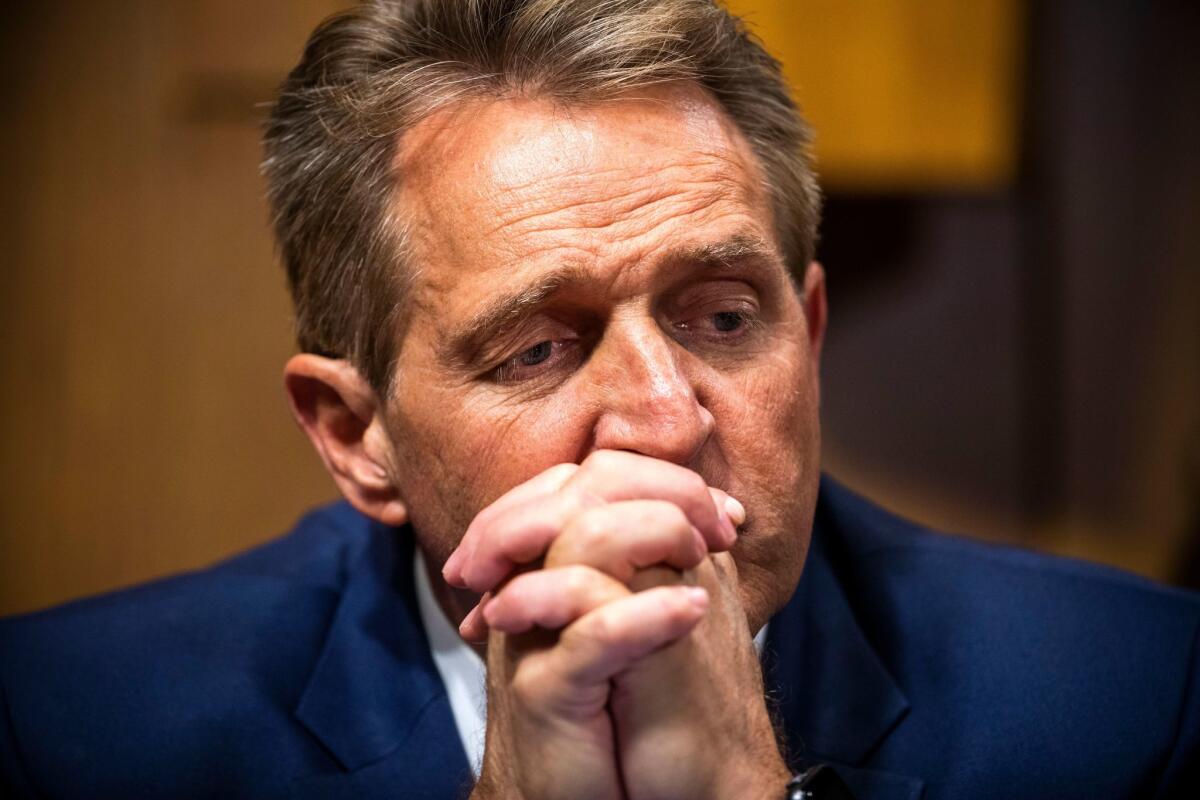
This party may never end.
Soon-to-be-former Sen. Jeff Flake (R-Ariz.), a frequent and acerbic critic of President Trump’s, tapped the brakes Friday on the Senate GOP’s rush to confirm Trump’s latest Supreme Court nominee, Brett Kavanaugh, in a way that won’t make anybody happy, but at least should make everyone less ticked off.
Flake said he wouldn’t support holding a final vote on Kavanaugh unless the FBI investigated the allegations that have been leveled to date against the appellate judge. The investigation should be conducted right away, Flake said, and last no more than a week.
Republicans have to take seriously Flake’s threat to support a Democratic filibuster, even though the GOP changed the rules last year to allow debate to be cut off with a simple majority vote. Having only 51 members, Senate Republicans would need every other person in their caucus to vote to end debate if Flake joined the Democrats on the other side. And it’s not clear at this point that every other Republican wants to keep pressing ahead.
Bear in mind that Flake supports Kavanaugh’s nomination. This is a calculated risk — a bet that the FBI will either find evidence refuting the allegations by Christine Blasey Ford and two other women, or at least turn up no facts to confirm them. But it’s also a smart play to help Republicans defend themselves against the accusation that they were in such a rush to confirm Kavanaugh that they disregarded at least one credible allegation made by a woman with no motive to lie.
Flake presented his position in Rodney King terms, as a form of rapprochement. “This country is being ripped apart here,” he told his colleagues on the panel. “We’ve got to be sure that we do due diligence.”
He’s certainly right about the polarization around the nominee, a relatively young, conservative jurist who could shift the Supreme Court further to the right for decades. And Flake isn’t holding out hope for a kumbaya moment at the end of the day; he said he didn’t expect Democrats to vote for Kavanaugh even after they get the investigation they’ve been urgently demanding. Instead, he said, he’s just trying to address what he characterized as legitimate complaints about the rush to a vote.
It’s the kind of institution-preserving gesture that his late colleague John McCain was celebrated for. You have to wonder why (and regret that) it’s not being done by someone who plans to stay in the Senate, and who’ll have to work with Democrats again next year.
President Trump appears willing to go along with Flake’s plan.
“I’m going to let the Senate handle that,” Trump told reporters Friday after the committee vote. He added, “I thought [Ford’s] testimony was very compelling and she looks like a very fine woman to me. A very fine woman. And I thought that Brett’s testimony likewise was, really something that I hadn’t seen before. Incredible.”
So now it’s up to Senate Majority Leader Mitch McConnell (R-Ky.), who has steadfastly resisted Democrats’ calls for a deeper FBI inquiry into Kavanaugh’s past. Update: The Senate GOP leadership indicated Friday afternoon that there will be a supplemental FBI investigation in the coming week, as per Flake’s suggestion.
Flake’s move cut the legs out from under his fellow Republicans on the committee, who’d spent the morning railing against the “character assassination” perpetrated against Kavanaugh. Although respectful of Ford during the panel’s hearing, many went on at length about the lack of corroborating evidence for her account. They also emphasized that Ford’s allegations were investigated by the FBI, albeit in a cursory way.
“There’s no doubt in my mind that she truthfully testified,” Sen. Mike Crapo (R-Idaho) said at Friday’s session. But he added, “I don’t feel that the evidence shows that Judge Kavanaugh was there that night. I believed his testimony, I believed Dr. Ford’s testimony about the sexual assault.”
Talk about trying to have it both ways.
Kavanaugh had similarly argued Thursday that Ford’s allegations had been investigated by the committee already, and that if there were any further questions, members could simply ask him while he was there. Not that he would have answered them — his pugnacious performance that afternoon seemed to have been taken straight out of President Trump’s “I punch back” playbook, as if Kavanaugh were playing to Trump’s base.
And perhaps he was. Whoever fills this seat will help shape the Supreme Court for years to come, but the fight to confirm Kavanaugh will help determine who controls Congress in 2019 and 2020. In the minds of some conservatives, winning that fight is vital to keeping GOP voters motivated for the midterm elections.
On the other hand, support for Kavanaugh among GOP women has been slipping in opinion polls, so how the panel treats Ford’s allegations may well have some bearing on the vote too. That’s another reason for them to embrace Flake’s proposal.
- Share via
Ford was the alleged victim, but Kavanaugh played that role

The federal judiciary is technically a nonpartisan branch of government. On Thursday, however, one member of the federal appeals court — and a potential Supreme Court justice — spewed contempt explicitly on Senate Democrats.
That would be Brett Kavanaugh, who delivered what may be the angriest, most emotional opening statement ever by a witness before the Senate Judiciary Committee. His intensity was understandable, considering the serious and occasionally salacious accusations leveled against him after the committee completed a lengthy round of hearings on his nomination. But Kavanaugh didn’t just defend himself. He said his accusers were engaged in a “calculated and orchestrated political hit” as “revenge” for President Trump’s victory.
In particular, he was angry that Sen. Dianne Feinstein (D-Calif.), whom he — along with most of the committee’s Republican members — accused of sitting on Christine Blasey Ford’s allegation against him for a month in order to waylay his nomination. He also was furious at the committee for not rushing to let him testify as soon as Ford went public with her allegation that a youthful Kavanaugh had sexually assaulted her, saying the delay gave others time to come forward with false accusations. And he was livid at other Senate Democrats for their more hyperbolic criticisms of his nomination.
He was, in short, spitting nails, but doing so exclusively in one direction. And again, it’s easy to understand why. But if he’s elevated to the Supreme Court, let’s hope he’s never asked to help resolve an election dispute.
It was a wild session and a vivid contrast to Ford’s appearance earlier in the day. As riveting and persuasive as her testimony was Thursday morning, more remarkable — especially in light of what followed — was her implacability.
Ford never got riled, never seemed suspicious of the questions put to her by Rachel Mitchell, the Arizona prosecutor hired by Senate Judiciary Committee Republicans to ask questions on their behalf. And perhaps she should have been, given that Mitchell appeared to be singularly interested in weakening Ford’s credibility by cataloging seeming inconsistencies in her utterances and suggesting that Democrats were aiding her cause in some way.
In short, it was what a prosecutor might do to a defendant on the stand. But Ford — the alleged victim here — stayed agreeable throughout, as if Mitchell’s questions were interesting and helpful to the process. Which in some respects they were, because they solidified a couple of things Ford has said about her motives. To wit:
- Ford never wanted to go public. Under questioning by Mitchell, Ford testified that she had indeed asked Rep. Anna Eshoo (D-Menlo Park) and Feinstein not to disclose the allegations she made about Kavanaugh in a private letter. She agreed to talk to the Washington Post, she said, only after a number of journalists had found out about the letter and were blindsiding her at work and at home in an attempt to get an interview. Ford had no idea how her name and letter got leaked.
- Ford brought her allegation to members of Congress confidentially in the hope of informing the process while Kavanaugh was just a name on President Trump’s short list of potential nominees. Contrary to the GOP-advanced notion that Democrats sprung Ford on Kavanaugh’s nomination at the 11th hour, Ford said she started reaching out with her story while Trump was still picking a replacement for retired Supreme Court Justice Anthony M. Kennedy. But she added that she didn’t know how to do that, and her desire to remain anonymous, while understandable, prevented her from having a voice.
By contrast, Mitchell’s questions to Kavanaugh were designed to lend credibility to his assertions. But after a couple of sets of inquiries, Republican senators sidelined Mitchell and began ministering to Kavanaugh directly.
That only exaggerated the partisan slant to the proceedings. Democrats were just as bad, clearly siding with Ford and working to trip up Kavanaugh rather than behaving as if their minds were open.
And that’s not new, considering how these proceedings have evolved in recent years. What seemed new was the explicit partisanship of the nominee. Granted, Kavanaugh had worked as staff secretary for President George W. Bush and had aided Kenneth Starr’s investigation into President Clinton. So his allegiances are clear. Nor have the Democrats handled the nomination judiciously, presenting a near-united front against Kavanaugh long before Ford’s allegation surfaced. It’s just that once you become a judge, you’re supposed to at least pretend that you’re no longer on one of the teams.
- Share via
Despite his ‘con job’ bravado, Trump gave himself wiggle room to cut Kavanaugh loose
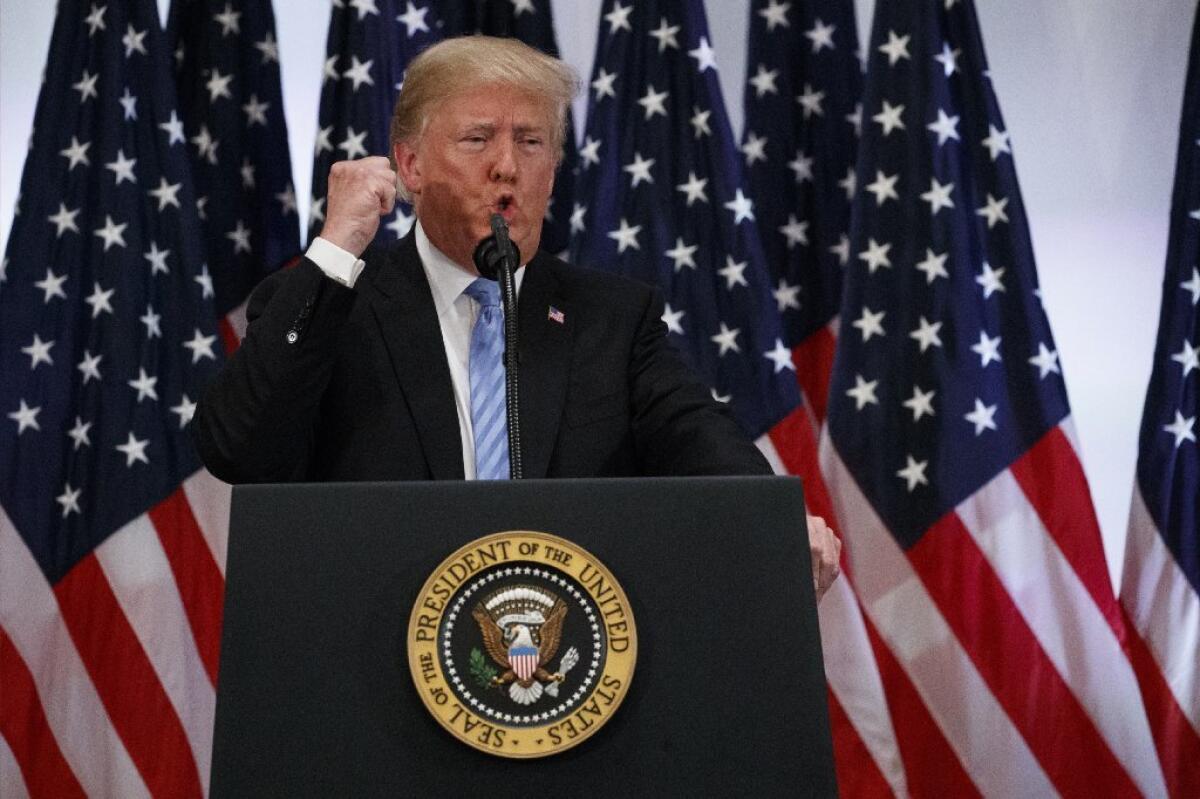
The day before one of Supreme Court nominee Brett Kavanaugh’s accusers is scheduled to testify before the Senate Judiciary Committee, Democrats on the panel asked President Trump to “immediately” withdraw the nomination — unless, that is, Trump agreed to reopen an FBI background check of Kavanaugh to examine sexual assault allegations.
Those allegations are multiplying. They now comprise not only the claim by Christine Blasey Ford, who is scheduled to testify Thursday that Kavanaugh assaulted her when they were teenagers in the early 1980s, but also the charge by Deborah Ramirez that Kavanaugh exposed himself to her when they were students at Yale and new accusations by a Washington woman named Julie Swetnick.
On Wednesday, Swetnick’s lawyer, Michael Avenatti, posted a document in which Swetnick alleged, among other things, that Kavanaugh was present at a 1982 house party at which she was gang raped. (Kavanaugh said her statement was “ridiculous and from the Twilight Zone.”)
It was after Swetnick’s allegations emerged that the Democrats requested that Trump either pull the Kavanaugh nomination or order a reopening of the FBI investigation (something they previously urged Sept. 18). As an attempt to acquire information, it didn’t make a lot of sense. If the call for withdrawing the nomination “immediately” were taken literally, it would mean that Ford would never testify.
But the Democrats’ move made more sense as a political gesture. Even a conditional request that the nomination be withdrawn served to ratchet up the party’s opposition to Kavanaugh and its solicitude for his accusers. Never mind that Trump would ignore both the call to withdraw the nomination and the call for a new FBI investigation.
But a surprise was in store at Trump’s Wednesday evening news conference. The president offered a spirited defense of Kavanaugh, said his nominee was a victim of a “con job” and pushed back against the idea of reopening Kavanaugh’s FBI background check. But he also indicated that he could imagine withdrawing Kavanaugh’s nomination if he were persuaded by Thursday’s hearing that the allegations against his nominee were true.
“I can’t tell you,” he teased reporters. “I have to watch tomorrow.”
More likely, neither Trump nor Republican senators on the committee will shift in their positions as a result of Thursday’s testimony, any more than Democrats will alter theirs.
Still, the president seemed to be leaving himself some room to maneuver if a man he called “one of the most respected people in Washington” disappoints him or if damaging new information surfaces. (NBC News reported Wednesday that the Judiciary Committee had been inquiring about an allegation that Kavanaugh had physically assaulted a woman in 1998 while he was inebriated. Kavanaugh denied the anonymous allegation.)
The Democrats could only be pleased that the president had moved their “impossible” demand into the realm of the possible.
- Share via
Kavanaugh’s prep school drinking buddy Mark Judge needs to testify
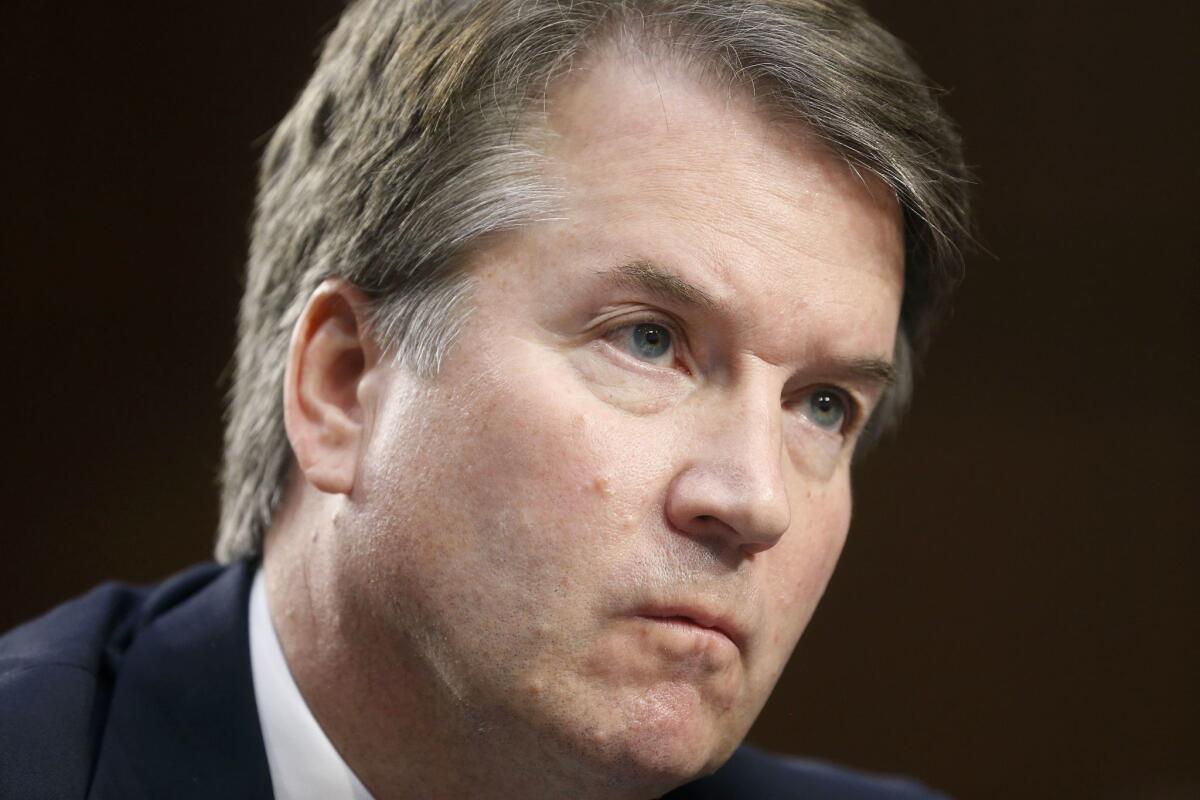
On Wednesday, a longtime federal employee and contractor named Julie Swetnick became the third woman to come forward against Supreme Court nominee Brett Kavanaugh, offering a sworn affidavit Wednesday accusing Supreme Court nominee Brett Kavanaugh of “inappropriate contact of a sexual nature” with women multiple times as a high-schooler.
Her lawyer — Michael Avenatti, who also represented porn actress Stephanie Clifford (a.k.a. Stormy Daniels) in her fight with President Trump and his former attorney, Michael Cohen — says she’s ready and willing to testify. And Senate Judiciary Committee Chairman Charles Grassley (R-Iowa) left open the possibility that his panel will hold additional hearings beyond the one scheduled for Thursday with Kavanaugh and one of his earlier Kavanaugh accusers, Christine Blasey Ford.
But Swetnick’s affidavit suggests that the committee really needs to hear from someone else: Mark Judge, Kavanaugh’s prep school classmate and alleged companion on the party circuit.
Ford was the first to put Judge’s name on the table, saying he was in the room when Kavanaugh allegedly pinned her to a bed, pawed at her clothes and covered her mouth so she couldn’t call for help. Swetnick goes considerably further, claiming she saw Kavanaugh and Judge engaging in sexually harassing behavior (and worse) at a series of alcohol-soaked parties between 1981 and 1983.
The most serious allegation by Swetnick is that Kavanaugh and Judge, among others, “caused girls to become inebriated and disoriented so they could be ‘gang raped’ in a side room or bedroom” by party attendees, and that Kavanaugh and Judge were among those lining up “waiting for their ‘turn’ with a girl.” Swetnick said that she was victimized this way at one of the parties attended by Kavanaugh and Judge, although she didn’t specifically accuse them of assaulting her.
Judge, an author and occasional journalist, has declined to testify, saying he had no memory of the party where Ford said she was assaulted. Swetnick’s affidavit, however, makes it all the more important that the committee hear from Judge. Ideally, the FBI would interview as many potential witnesses as possible to help the committee with its investigation, but the White House has ruled out that idea. So its up to senators themselves to try to bring more facts to bear.
Whether that happens is up to Senate Republicans, who up to this point have seemed to be racing ahead to confirm Kavanaugh. The key question is whether the latest allegation and the testimony by Ford and Kavanaugh Thursday unsettle two or more Republican senators enough to put Kavanaugh’s confirmation in doubt and force the committee to conduct more hearings to try to clear him.
One factor that may work in Kavanaugh’s favor is Swetnick’s choice of attorney. Avenatti is a vocal and harsh Trump critic who has floated the idea of running for president in 2020. Fairly or not, his involvement puts a partisan tinge on Swetnick’s affidavit, inviting Kavanaugh’s supporters to focus on him instead of her. Trump’s response epitomizes this:
Swetnick’s affidavit establishes her bona fides, noting that she has obtained a variety of clearances and passed multiple background checks over the years as a federal government employee. It’s safe to assume that Swetnick didn’t step into this fracas lightly — not only will she be subject to intense scrutiny, but she could be sent to prison if it turns out she deliberately submitted a false affidavit to Congress.
Avenatti has called for the FBI to investigate Swetnick’s allegations, and he’s right — the Judiciary Committee should hit the pause button and have the feds gather as much information as they can before moving forward on the nomination. That isn’t the route the panel is taking, however, at least not yet.